


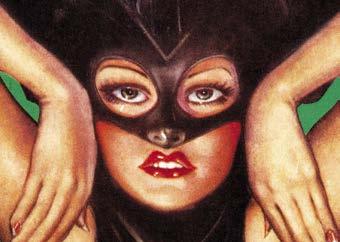

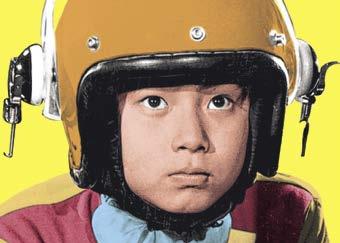

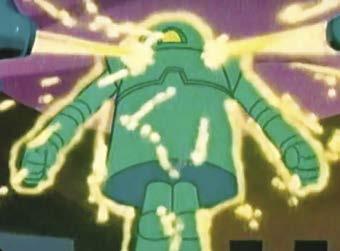
Dynamic television 44 Adam West 46 Burt Ward 50 Yvonne Craig 54 Supporting players 56 Extracurricular television 57 Rogues’ gallery 58 INITIUM ORIGIN STORY HOLY RATINGS!
ANIMATION 2
Insets: Bat lady by Margaret Brundage © Weird Tales; “The Detectives” © NBC Television; Eartha Kitt publicity photo; “Johnny Sokko” © TV Tokyo; “Space Ghost” © Hanna-Barbera Productions Introduction 4 Overview 8 Timeline 10 Roots of superdom 12 Batman begins 16 Jerry Robinson 20 George Roussos 23 Dick Sprang 24 Sheldon Moldoff 25 Birth of a film genre 28 Green Hornet serials 30 Captain Marvel serial 32 Fleischer Superman shorts 33 Batman serials 34 The Phantom serial 35 Captain America serial 36 Superman serials 37 Clayton Moore 38 ‘Adventures of Superman’ 39 Noel Neill 40 ‘The Green Hornet’ 74 Van Williams 76 Bruce Lee 78 ‘Ultraman’ 80 ‘Starman,’ ‘Johnny Sokko’ 82 ‘Captain Nice,’ ‘Mr. Terrific’ 83 Ron Ely 84 Frank Gorshin 62 Burgess Meredith 64 Cesar Romero 65 Julie Newmar 66 Eartha Kitt 69 Malevolent memories 70 ‘Pow!’ went the pop stars 71 The Batmobile 72 ‘Marvel Super Heroes’ 86 Filmation 88 ‘Space Ghost’ 90 Comic book worthy 91 Funny and furry 93 Japanimation 94
EARLY FILM & TV
MORE TV HEROES
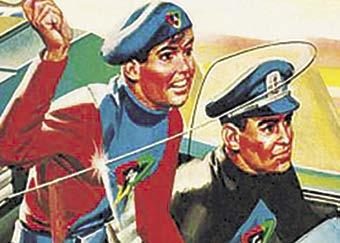

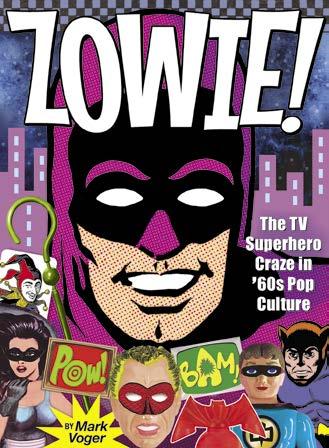
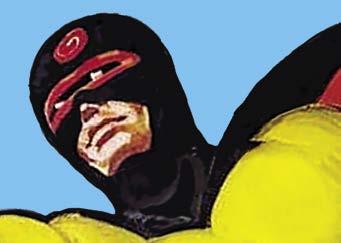

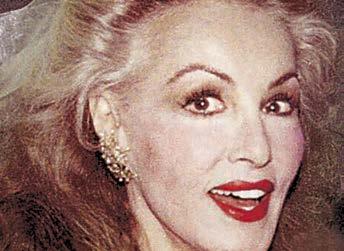
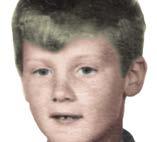


Tights, camera, action 162 ‘Batman’ the movie 164 Lee Meriwether 166 ‘Rat Pfink and Boo Boo’ 167 A tale of two Batwomen 168 Superhero imports 170 Medium in flux 138 Carmine Infantino 141 Joe Giella 142 Batman comics vagaries 143 Creating Batgirl 145 The Marvel bump 146 TV character comic books 150 Parody panels 153 The superhero glut 154 3 All rights reserved under international copyright conventions. No part of this book may be reproduced in any form or by electronic or mechanical means, including information storage and retrieval systems, without permission in writing from Mark Voger, except by a reviewer who may quote brief passages in a review. Address inquiries to Mark Voger c/o: TwoMorrows Publishing. Photos credited to Kathy Voglesong © the estate of Kathy Voglesong Written & designed by: Mark Voger Publisher: John Morrow Proofreader: Kevin Sharp “Zowie! The TV Superhero Craze in ’60s Pop Culture” © 2024 Mark Voger ISBN-13: 978-1-60549-125-7 First printing, July 2024 Printed in China Front cover: Ka-Pow © Amalgamated Superheroes; playing card and Punchboy toy © current copyright holders; “Wild World of Batwoman” poster detail © ADP Productions; Aquaman mask © Ben Cooper & © DC Comics Inc.; Super Dracula by Tony Tallarico © Dell Publishing; Riddler cane and Batphone replica © Warner Bros. & DC Comics Inc. Frontispiece: Detail from “Rat Pfink and Boo Boo” movie poster © Morgan Picture Corp. Back cover: Captain Art Director and Zok! button © current copyright holders; Fly Girl © Archie Comics; Courageous Cat © Trans-Artists; Flash Gordon © King Features Syndicate; “Las mujer murcielago” poster detail © Cinematográfica Calderón Published by: TwoMorrows Publishing 10407 Bedfordtown Drive Raleigh, North Carolina 27614 COMICS PRINT MEDIA Insets: Toy box art © Captain Action Enterprises; Polly © Dell; “Las Mujer Murcielago” © Cinematográfica Calderón; “Argoman” © Fida Cinematografica; Julie Newmar photo © Kathy Voglesong MOVIES CRASH & COMEBACK COLLECTIBLES For Nairb AFTERMATH Rise of an industry 96 Games people played 97 Heroes of Halloween 98 Batmabilia 104 Japanese visions 108 Green Hornetabilia 111 Marvelous merch 113 Hanna-Barbera stuff 114 Captain Action in action 116 Super Soakys 120 Masked on magazines 122 Book ’em 128 Trading cards 130 Norman Saunders 132 Death of the Dozierverse 172 1989: Twice upon a time 173 Modern superhero movies 177 Bruce Wayne in Gotham 178 Respect at last 182 Detective story 184 Epilogue 186 ‘The Super Zero Awards’ 188
Everything was Batman in 1966. You had to be there.
Can you name an actor who landed on the cover of both Life and Mad magazines in the same year? Adam West, the star of TV’s “Batman,” had that honor. West was also granted a papal audience, and learned that Pope Paul VI was a bat-fan. Hollywood elite clamored for roles as “guest villains” on the TV show.
Wherever you turned, you saw the wholesome faces of Batman and Robin smiling on every kind of merchandise: lunch boxes, puppets, bubble-bath toys, model kits, trading cards, Halloween costumes, comic books (of course), paperbacks, record albums, coloring books, play sets, board games, buttons, Big Little Books. Miniature Batman comic books were inserted as premiums inside boxes of Kellogg’s Pop-Tarts. So, yeah, Batman always taught you to be a good citizen, but he also sold Pop-Tarts.
AS THE GIDDY BLUR GOT GIDDIER IN ’66, YOU
began to notice that beyond Batmania itself, an overarching mania for superheroes in general was creeping into the culture. “Batman” showrunner William Dozier followed up with “The Green Hornet” starring Van Williams and Bruce Lee. Like Batman, the Hornet had a trusty sidekick and a sweet ride, but the similarities ended there. “The Green Hornet” was a bit more serious, more adult, which may account for its status as a one-season wonder.
Networks greenlit not one, but two superhero sitcoms: NBC’s “Captain Nice” and CBS’s “Mr. Terrific.” Grantway-Lawrence’s threadbare but charming “The Marvel Superheroes” recycled actual comic-book art in “limited animation” at its most limited. But, hey, it introduced many of us little ones to Jack “King” Kirby.
The medium of comics — birthplace of the superhero genre — itself became obsessed with capes and cowls once the craze hit. Publishers who’d given up on the genre a decade earlier (Charlton, Harvey, ACG, Archie Comics) were suddenly dusting off old heroes or cooking up new ones. Meanwhile, the “Big Two” — DC and Marvel — pulled some wacky genre stunts during the craze.
BUT WHEN THE TV “BATMAN” CRASHED IN ’68, IT really crashed. The once-hot series had entered into a death cycle of sinking ratings and production values. Did the lackluster ratings trigger the lower budgets, or vice versa? Either way, West’s final flap of the cape happened just in time for the hippies, with their marijuana and their Nehru jackets, to commandeer the culture. Overnight, the ’66 Batman became an anachronism. The “Camp Age” (as author Michael Eury termed it) was receding fast.
To those who grew up watching the TV show, and generations thereafter who saw it in reruns, “Batman” became a pleasant memory. But in the comic books, the words POW! and BAM! were summarily banned. Something akin to a rehabilitation took place over the ensuing decades, with the character facing increasingly less fanciful, more reality-based threats. In the comics milieu, this trend wasn’t unique to Batman. Overall, creatives strived to make superhero characters more “relevant.” Alas, Batman comic books were no longer suitable for 8-year-olds.
It all led to writer-artist Frank Miller’s influential (to say the least) revisionist miniseries Batman: The Dark Knight Returns, which was collected into a buzz-magnet trade paperback in 1986. Miller set his story in a future in which Bruce Wayne had retired his Batman costume, and now dulls his post-traumatic stress with alcohol. Circumstances force Wayne to suit up once again, of course, or there wouldn’t be a miniseries.
Tim Burton’s 1989 blockbuster “Batman,” likewise not for the

This detail from an Aurora ad encapsulates the trend. Opposite: Superheroes (and villains) invade newsstands. © Aurora Plastics Corp.; On the Scene © Warren Publishing
Little Ones, soon followed and ignited a new wave of Batmania.
For the first time since West’s day, Batman was being discussed in the mainstream. The 1966-68 series became something of a scapegoat, an object of derision among a new breed of devout Batman geeks who believed West’s portrayal strayed too far from the dark avenger who hunts criminals from the murky shadows of Gotham City. This oversimplified view became the consensus among said geeks, but rates further discussion.
Though the “returning-Batman-to-his-brooding-roots” narrative makes for a sanctimonious sound bite, it ignores the fact that prior to the ’60s TV show, the comic book Batman only really brooded for about a year, his first. (Co-created by artist Bob Kane and writer Bill Finger, Batman debuted in 1939 in, all together now, Detective Comics #27.) Robin — a smiling lad in a colorful costume — was introduced in 1940 expressly to make Batman a less scary, more relatable figure to small-fry readers.
So here’s another way to look at the whole 1966 thing: The TV show “Batman” was, we can all agree, a comedy. West’s Batman was never intended to be “the” Batman. Over generations, the character had wildly differing iterations, and this was one more. The TV “Batman” was a lark, see? It was a comedy — and a clever, colorful, delectable one at that, one that happened to dominate the culture for a year or two before crashing and burning.
Not that the 1966 Batman ever really went away.
9
Roots of superdom
There were always superheroes. Some of them even wore tights.
Before streaming, before handheld devices, before the internet, before home video, before television, before moving pictures, before radio, before print, what did you have?
Word of mouth. (And Corinthian pottery.)
Folklore and legends, parables and myths, fables and old wives’ tales … these were “mass communication” in ancient times. To understand how the TV superhero craze of the 1960s came into existence, we must first establish where the notion of the “superhero” originated. Looking back — way back — it’s clear that humans have always needed heroes and, more to the point, heroes with special powers who operate on the side of good.
In short, better versions of ourselves.
Is Superman really all that different from Hercules, a legendary hero from Greek and Roman mythology of decidedly mixed lineage (god dad, mortal mom) and super strength?
Prometheus anticipated the Human Torch. Hammer-swinging thunder god Thor anticipated hammer-swinging thunder god Thor. Pegasus belongs in the League of Super Pets, yo!
Were Jason and the Argonauts the first-ever superteam? Jason was the great grandson of a god; was raised by a half-man, halfhorse; married a sorceress; and went on a quest to find the fleece of a winged ram. (I could have sworn there was a Saturday morning animated series by Filmation titled “The Argonauts,” with Ted Cassidy as the voice of Jason and Casey Kasem as Acastus.)
If the Argonauts were the original Justice League, doesn’t that make King Arthur and the Knights of the Round Table the original Avengers? Robin Hood was an altruistic vigilante who “robs from the rich and gives to the poor.” His prowess with a bow and arrow were rivaled only by ... Green Arrow and Hawkeye.
IN (RELATIVELY) MODERN TIMES, THE PULP fiction magazines of the late 19th century through the 1950s brought about many masked avengers and sci-fi heroes, some of whom influenced the creators of Superman and Batman. The Shadow, the Spider, the Black Bat, Tarzan, Zorro and a lot of deeper-cut characters (who have long since faded from collective memory) sprang forth from the pulps. Many of these characters were adapted to other media such as radio, movie serials and comics.
The jungle hero Tarzan debuted in The All Story (Oct. 1912) in “Tarzan of the Apes” by Edgar Rice Burroughs. The masked avenger Zorro debuted in All-Story Weekly (Aug. 1919) in “The Curse of Capistrano” by Johnston McCulley. Artist Margaret Brundage’s sexy-creepy lady with the vampire-bat headdress on the Oct. 1933 Weird Tales cover would upstage Batman or Catwoman. (Hot tip: Investigate Brundage’s work!)
Another prototype, Japan’s Ôgon Bat (or Golden Bat), debuted in 1931 in the quaint old medium kamishibai (or “paper theater”). Bold, acrobatic masked heroes pervaded the silent era of film.
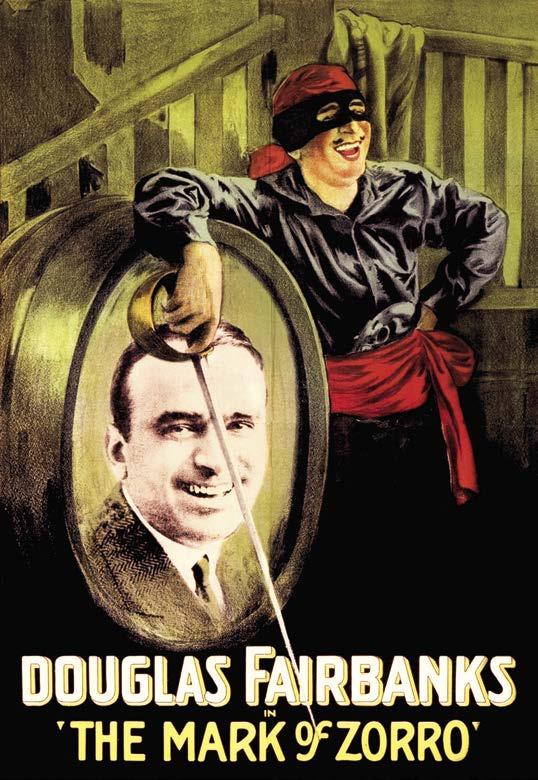
Zorro was only a year old when Douglas Fairbanks Sr. donned the mask in Fred Niblo’s 1920 swashbuckler “The Mark of Zorro.” Radio gave us heroes like the mysterious Shadow (in 1930). The Old West vigilante the Lone Ranger (in 1933) and his great nephew the Green Hornet (in 1936) were introduced by George W. Trendle and Fran Striker. Radio also provided a new venue for existing characters Superman (in 1940) and Batman (in 1945).
The newspaper comic strips brought us heroes that still seem timeless today. Such strips include Philip Francis Nowlan’s “Buck Rogers” (in 1929); Chester Gould’s “Dick Tracy” (in 1931); Alex Raymond’s “Flash Gordon” (in 1934); Lee Falk’s “The Phantom” (in 1936); and Hal Foster’s “Prince Valiant” (in 1937). Of these, Falk’s Phantom, “the Ghost Who Walks,” seemed most simpatico with the comic book superheroes who were soon to follow.
ORIGIN STORY
13
“Mark of Zorro” (1920) gave us an early masked avenger on film. Opposite: Genre thrills on pulp fiction covers. © United Artists; magazine covers © current copyright holders
“The Phantom, as you may know, is the first masked hero in the comics,” said Lee Falk. “He came before Batman, before Superman.”
St. Louis native Falk (1911-1999) created the comic strip heroes Mandrake the Magician (in 1934) and the Phantom (in 1936) for King Features. “The Phantom” — for which Ray Moore was the founding artist — presented a jungle hero in a lavender “union suit” who was descended from a 400-year line. The Phantom wore a mask and skull ring passed down from father to son ever since pirates murdered the original Phantom’s father. Each Phantom has taken the “Oath of the Skull.” Like Batman, the Phantom possessed no super powers, just brains and brawn.
“I had the idea for a man of justice, a crimefighter in sort of a mask going through the jungle,” Falk once told me. (I interviewed the writer in 1991 and 1996.)
“Kind of odd. I had nothing to do with the color process. I didn’t even think about color until the Sunday page (which debuted in 1939). We made him purple. A man in purple going through the jungle — he should have been camouflaged, in green.
“Anyhow, I worked from the heroes of antiquity, of Asia, Greece, Rome, the great heroes of Western Europe, Spain, France, Ulysses, all the heroes. So the Phantom was sort of a combination of those heroes. He’s a hero, a jungle-man hero. I was certainly influenced by what I read as a kid. I grew up with Tarzan, and the Phantom was sort of like a modern Tarzan swinging through trees. I didn’t have a horse for him in the beginning; he had to swing like Tarzan. But he was quite different from Tarzan. He was a college graduate and so forth.

Some of these aspects — the murdered parent, the oath, the tights, the cave — were soon echoed in Batman and Superman.
“And also, some of it might have been from ‘The Jungle Book’ by (Rudyard) Kipling. That story fascinated me as a kid. In fact, if you remember, in ‘The Jungle Book’ there was the Bandar-log, the monkey who befriends the boy. So I called my tribe — the group that sort of protects the Phantom — I called them the Bandar, which is my homage to Kipling.”
BUT THE IDEA OF THE LONG
LINE
OF PHANTOMS,
and even the jungle setting, came along after the strip’s 1936 debut.
“Actually, when I started him, he was a playboy named Jimmy Wells,” Falk pointed out. “He was a friend of Diana’s, who was the heroine. Well, it turns out that at night, the playboy is the Phantom. She gets in some trouble with some gang. Unbeknownst to her, he’s trying to help her. He comes in the night, this masked man, very romantic. She sort of wonders who this mysterious masked man is, not realizing that it’s Jimmy Wells, who is an old friend of the family and wants to marry her.
“So I began with the idea of Jimmy Wells, who was like Superman’s Clark Kent. Where I adopted the idea from, I have no idea. The idea I had first was just the Phantom. In a story, I took the Phantom to the jungle, and then I left him there. So I actually adopted a whole new legend about the Phantom, bit by bit, over the first year. He became the 21st generation of a whole line of Phantoms dedicated to the destruction of piracy — which stands for criminality of all kinds — piracy, cruelty and injustice.
“This was passed down from father to son. And that became the legend of the Phantom. That became the whole idea. It was very developed. There was a Skull Cave, which looked like a big skull, which was created by nature. And we went on from there.”
“The Phantom was, in part, the inspiration for them,” Falk said. “Batman has a Batcave like the Phantom’s Skull Cave. They (Batman and Superman’s creators) weren’t being plagiarists; they were just inspired by the first thing they saw.
“The Phantom inspired a whole lot of costumed superheroes, as they became known. But the Phantom was never a ‘super’ hero. He wasn’t like Superman. He wasn’t immune to being hurt. He would get hurt; he’d be wounded; he’d bleed. So he was more like Batman in that respect. That kept him very interesting.”
At the time Falk and I spoke, “The Phantom” was the longestrunning comic strip still being written by its creator.
“I’ve always kept control,” Falk said. “I still do storyboards, composition. My storyboards are like film scripts. My scripts first show the action, with a description of that, and characters, dialogue. And then you go on to the next panel and so forth. That way, I’ve kept control of the feature. But my artists are excellent. The artists usually improve on what I give them.”
As for being the longest-running writer: “Well, most of them are dead. I started when I was 19. Most of the other guys were in their 30s and 40s, which was still kind of young. But I was very young. That’s why I’ve been doing it for 60 years.”
Said Falk of his other comic-strip creation: “Mandrake has good foreign circulation, because he translates well. There’s a lot of humor to him, but it’s not jokes. It’s humor out of the situation.
“Mandrake and (his sidekick) Lothar were the first Black and White partners, so to speak, in a comic strip. In fact, Lothar was the first Black character in comics, ever. The Phantom and Mandrake translate much better in foreign languages, because they’re not particularly American. They’re just men of the world.”
14
Writer Lee Falk, creator of the Phantom, met the press in 1991.
Photo by Kathy Voglesong
Batman begins
From his first flap of the cape, Batman was breaking the rules of a genre in its infancy. Superman wore bright colors. Batman wore black.
The two seminal superhero characters, introduced within a year of one another, were inexorably linked from the start. What they had in common — both were orphans with secret identities who took a vow to protect the innocent — wasn’t nearly as interesting as their contrasts. Superman was smiley; Batman was brooding. Superman had super powers; Batman was a mere mortal. Superman played by the rules; Batman possessed the ruthless heart of a vigilante.
WHEN ACTION #1 SCORED NEWSSTAND gold, its editor Vincent “Vin” Sullivan (1911-1999) sought a followup superhero. He mentioned this to Bronx native Bob Kane (1915-1998), a cartoonist who had been drawing humorous fill-in pages for Action. These were often written by Denver native Milton “Bill” Finger (1914-1974), Kane’s fellow alum of DeWitt Clinton High School in the Bronx. Kane had a wisp of an idea — just the name Bat-Man and a vague sketch — and turned to Finger to help flesh it out.
Both men loved adventure-genre fiction and films, and put those influences in their proposal. (Kane would later cite Roland West’s 1930 mystery “The Bat Whispers” starring Chester Morris as an influence, even if the masked Bat of that film was the bad guy.)
Kane pitched the Batman concept to Sullivan, apparently neglecting to mention Finger’s contribution.
Batman debuted in Detective Comics #27 in 1939, an anxious time in America. Folks were still reeling from the Great Depression, and a war was looming.
The first Batman story — illustrated by Kane and written by Finger — bore the unsexy title “The Case of the Chemical Syndicate.” (This was Detective Comics, not Action Comics, so mysteries were de rigueur.)
What aspects of the Batman mythos were present from the start? In the first panel, we meet Bruce Wayne (identified as a “young socialite”) and Commissioner Gordon. That, and the costume, are about it.
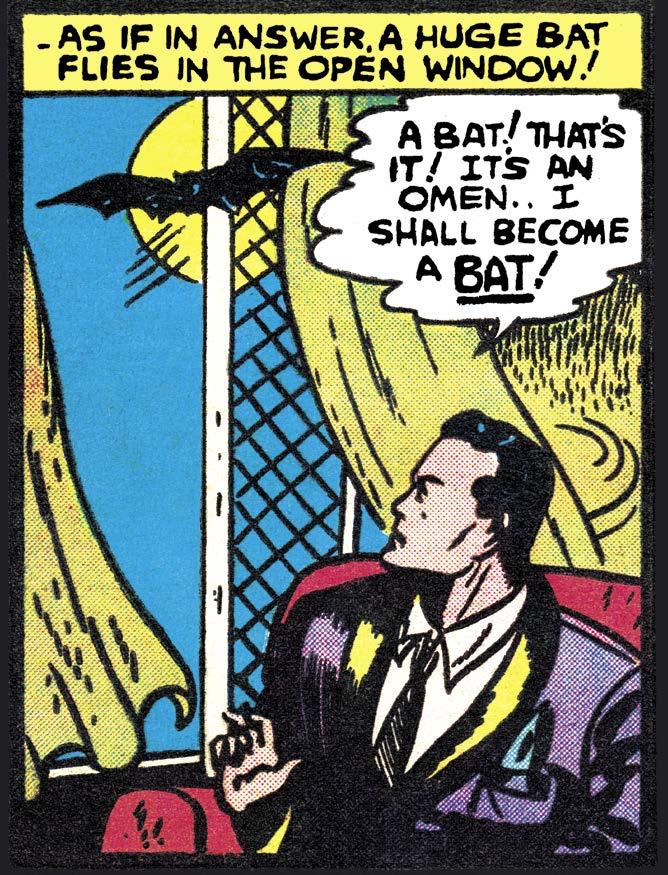
Or was it a purple-throated calliope? From Detective Comics #33 (1939). Opposite: “The Bat Whispers” (1930). © DC Comics Inc.; © Atlantic Pictures
Otherwise, the earliest Batman is a punisher who has zero empathy for lawbreakers. When he sends a gangster into a vat of acid with a punch, Batman brusquely remarks: “A fitting ending for his kind.” Batman drives a car (colored red, at least in DC’s 1990 reprint), but it has no bat-like modifications yet. His dialogue is 100 percent pun free.
Fun facts: The character name is actually spelled with a hyphen (“Bat-Man”) over the first three stories, often in quotes and preceded by the article “the.” And Batman fires a gun (!) in ’Tec #32.
In the first 11 Batman stories through Detective #37 (1940), it’s plain how the character was influenced by the movie serials and pulp fiction stories of the day. Batman was so simply drawn and unambiguously written, you’d swear he was dreamt up by a couple of kids. Which he was. Kane was 22; Finger was 21.
So Batman was a boyhood fantasy not only for millions of readers, but also for his co-creators.
17
Without Bob Kane, there’d be no Batman. Without Bill Finger, we wouldn’t remember Batman. A guy in red with no cowl, no bat-ears?
For many years, the origin story of Batman — the real life origin story, not the bat-flies-in-the-window one from the comic book — was as cloaked in mystery as the character himself.
For 76 years following Detective #27’s newsstand debut, sole creator credit was ascribed to Kane, despite many indelible contributions to the character made by Finger from the very first story.
And, owing to the misleading (and no longer practiced) tradition of “ghosting” in comics, even the artwork credit went to Kane. As a result, the dynamic art of Dick Sprang, Sheldon Moldoff, Win Mortimer, Jack Burnley, Lew Sayre Schwartz, Stan Kaye and others was credited to one man, disregarding stylistic variations — and keeping fans in the dark.
Yet, by Kane’s own account in his memoir “Batman and Me” (1989, Eclipse Books) written with Tom Andrae, Finger overhauled Kane’s initial sketch of Batman in what sounds very much like an act of co-creation. As Kane described it in his memoir:
“One day I called Bill and said ‘I have a new character called the Bat-Man and I’ve made some crude, elementary sketches I’d like you to look at.’ He came over and I showed him the drawings. At the time, I only had a small domino mask, like the one Robin later wore, on Batman’s face. Bill said, ‘Why not make him look more like a bat and put a hood on him, and take the eyeballs out and just put slits for eyes to make him look more mysterious?’
At this point, the Bat-Man wore a red union suit … Bill said that the costume was too bright: ‘Color it dark gray to make it look more ominous.’ The cape looked like two stiff bat wings attached to the arms. As Bill and I talked, we realized these wings would get cumbersome when Bat-Man was in action, and changed them into a cape, scalloped to look like bat wings when he was fighting or swinging down on a rope. Also, he didn’t have any gloves on, and we added them so he wouldn’t leave any fingerprints.”
It may seem odd that a writer, not an artist, would have so much to say about a character’s look. But Finger thought visually, and often put Batman in predicaments based on optical appeal. Dick Sprang was a Batman artist during the ’30s-’40s period called the Golden Age of Comics. “The scripts were never signed, but I could always tell a Bill Finger script,” Sprang told me in 1993. “I’d instantly recognize his unique approach to comic writing.
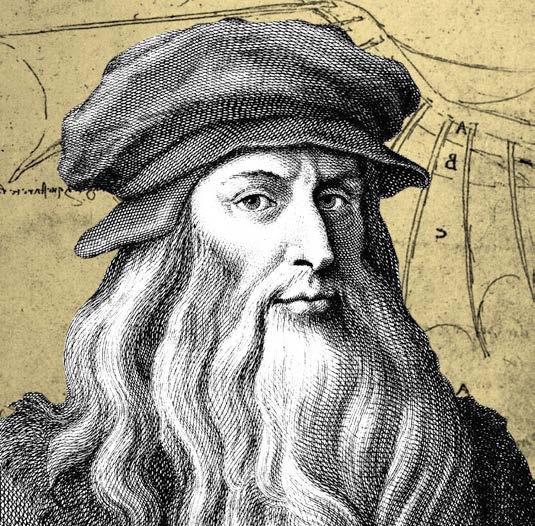
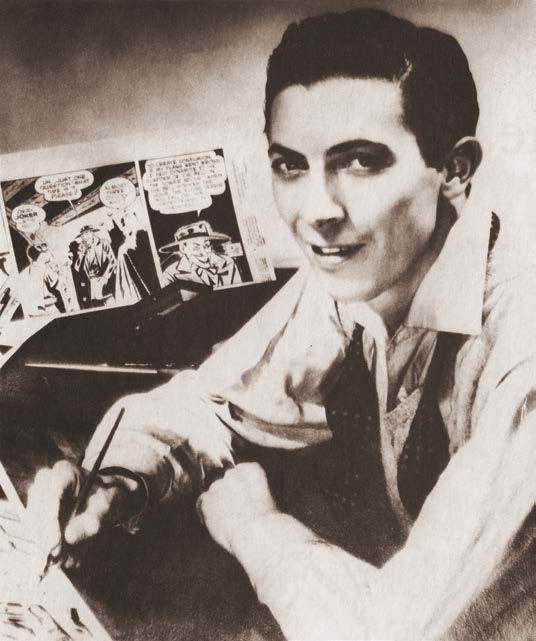
“I always enjoyed working on his scripts, because they were not only extremely well-written and perfectly visualized, but the guy would supply me with background. He would always send a handful of ‘scrap’ (printed visual references) from his own files to help illustrate, to help convey his viewpoint, what he wanted illustrated in his script. And then, of course, I would carry on with other research from my own files, and try to make it authentic.”
 Bob Kane at the drawing board (1944). Below: Two inspirations were Leonardo da Vinci and the 1931 film “Dracula.”
© McClure Newspaper Syndicate; © Universal Pictures
Bob Kane at the drawing board (1944). Below: Two inspirations were Leonardo da Vinci and the 1931 film “Dracula.”
© McClure Newspaper Syndicate; © Universal Pictures
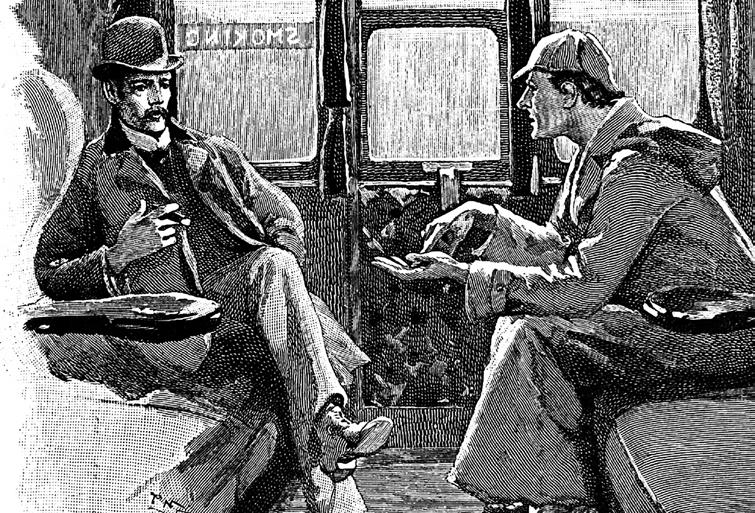

When Bill Finger decided Batman needed a Dr. Watson, Jerry Robinson pitched in. Left: Sherlock Holmes and Dr. Watson
Jerry Robinson
It was the summer of 1939. Batman was a thing, but only just.
A 17-year-old journalism student at Columbia University named Jerry Robinson had a chance encounter with someone he’d never met before, Bob Kane, at a tennis resort in Pennsylvania.
Kane, then 23, paused and engaged Robinson in conversation after taking note of the jacket the teenager was wearing.
“I went out to play tennis and I wore a jacket that I had decorated with my cartoons,” Trenton native Robinson (1922-2011) told me during an interview conducted in 1989.
“And Bob Kane, who had just started Batman shortly before that, saw it and asked who did the cartoons. A friendship developed, and he said that if I came to New York, I would be able to assist him on Batman.”
Bat-what? By summer ’39, a few Batman stories had been published in Detective Comics, not that Robinson had seen them.
“I had never heard of it,” he said. “In fact, Bob took me down to the local magazine store to find a copy of it.”
Robinson bit, and the decision changed the course of his life.
“I came to New York and started work in the fall,” he said. “In fact, I didn’t even go back home. I went right from the resort.”
Robinson reckoned he debuted in “one of the fall issues of 1939,” initially as a letterer and background inker. (For non-geeks: “Pencillers” draw the artwork in pencil, “inkers” finish it in black ink.) As an artist, Robinson grew in leaps and bounds over the next couple of years. He graduated to inking main figures, and eventually began pencilling outright. Robinson’s contributions marked a turning point for Batman. He retained Kane’s cartooniness, but added a much needed fluidity that Kane’s stiff figures lacked.
HERE’S WHERE THE STORY GOES SOUTH.
Today, Robinson is acknowledged as a co-creator of two important characters in the Batman canon that both debuted in 1940: Robin and the Joker. But for many years, Kane denied Robinson’s credit. (Sound familiar?)
Batman’s co-creator, writer Bill Finger, decided that Batman needed a sounding board, a Dr. Watson to his Sherlock Holmes. Partially based on Robinson, Robin debuted in Detective Comics #38, touted as “The Sensational Character Find of 1940!”
Recalled Robinson: “I was a kid at the time — I was only 17 — and they would call me ‘Robinson the Boy Wonder.’ I didn’t like that at the time because I wanted to be thought of as older.
“In fact, I did name him, but my concept was from Robin Hood. If you look at the costume, it’s kind of an update of Robin Hood.”
Regarding the Joker, Robinson didn’t mince words.
“The Joker was my creation,” the artist stated.
“Batman was growing more popular with each succeeding issue, and they decided to publish the Batman quarterly, Batman #1, for which we needed a lot more stories. My idea was to create a new villain, because there weren’t supervillans in the comics at the time. From my studies in literature, I learned that all the great heroes from Biblical times on had an antagonist. Even Sherlock Holmes had Moriarty. But we never had one for Batman.
“I had written a lot of humor pieces in my courses at Columbia. I wanted to create a villain that had some sense of humor. That would be a contradiction in terms, a villain with a sense of humor. That is the essence of a good character: It has contradictions.”
20
artwork by Sidney Paget (1890s). Robinson named Robin for Robin Hood. Right: Errol Flynn as the fabled hero (1938). © Strand Magazine; © Warner Bros.
A NAME FOR THE CHARACTER THEN PRESENTED itself. As Robinson told it: “Once I’d decided on his sense of humor, in searching for a name, the Joker came to mind. I immediately associated it with the joker playing card. That’s where the visual image of his head came from. That’s where we started from.”
Robinson’s playing card concept was used in the Joker’s debut story (and occasionally thereafter). But Kane’s Joker design was more influenced by a reference supplied to him by Finger: German actor Conrad Veidt in the silent adaptation of Victor Hugo’s “The Man Who Laughs” (1928). The Joker debuted in Batman #1.
Kane recollected the Joker’s genesis differently in his memoir: “In a number of interviews, Jerry Robinson has claimed that he created the Joker. At this time he was an 18-year-old kid just out of high school. He came in with a drawing of a joker playing card, with a joker that looked like a court jester. … Jerry claimed that this card was the original inspiration for the Joker. ... I do not doubt that my ex-assistant is sincere in believing that he did, in fact, create the Joker, but time has eroded his memory.”
BACK THEN, NO ONE KNEW HOW MUCH MONEY would change hands over characters like Robin and the Joker.
“In those days, and being so young, we never thought of that,” Robinson told me. “That was a long time ago. Since then, we’ve become a little more aware of our creative rights.
“In fact, (Superman co-creators) Jerry Siegel and Joe Shuster are good friends of mine. I don’t know if you remember the story a few years ago, but they were left penniless. Myself and another artist (Neal Adams) renegotiated that deal for them, and I represented them. Finally, I did get at least some justice for those two.” (Shuster died at age 78 in 1992; Siegel at age 81 in 1996.)
Said Robinson of his old collaborators on Batman: “I haven’t talked to Bob in some years. He moved to the coast. I’d occasionally speak with him or see him in New York. Bill passed on some years ago (in 1974). It’s really a shame he didn’t get credit for his contributions in his lifetime. It’s only now that they’re starting to know his name. It was never signed on the strip, which it should have been. I used to sign his name myself to stories I drew.”
ROBINSON WAS NO FAN OF THE TV SERIES.
“I didn’t like the concept of that TV thing, because they really had camped it up so much that I knew it wouldn’t last more than a couple of seasons,” the artist said. “It didn’t do justice, I don’t think, to the initial concept, which I think is very strong and could have been a long-lasting series, just as Tarzan has been and James Bond has been. Or a strip like ‘Peanuts,’ if it’s handled properly, can go on. But if you parody it, it wouldn’t have the longevity. That’s what I objected to.”
But Robinson had no objections to the show’s portrayal of the Joker. “I liked the selection of Cesar Romero. In fact, I met him out in Hollywood. I kidded him at the time that when I created the Joker, I didn’t know I was reviving his whole career.”
Said Robinson of the casting of Jack Nicholson in the 1989 film: “He didn’t fit my idea visually – the Joker is tall and slim — but I think he’s an excellent choice.”
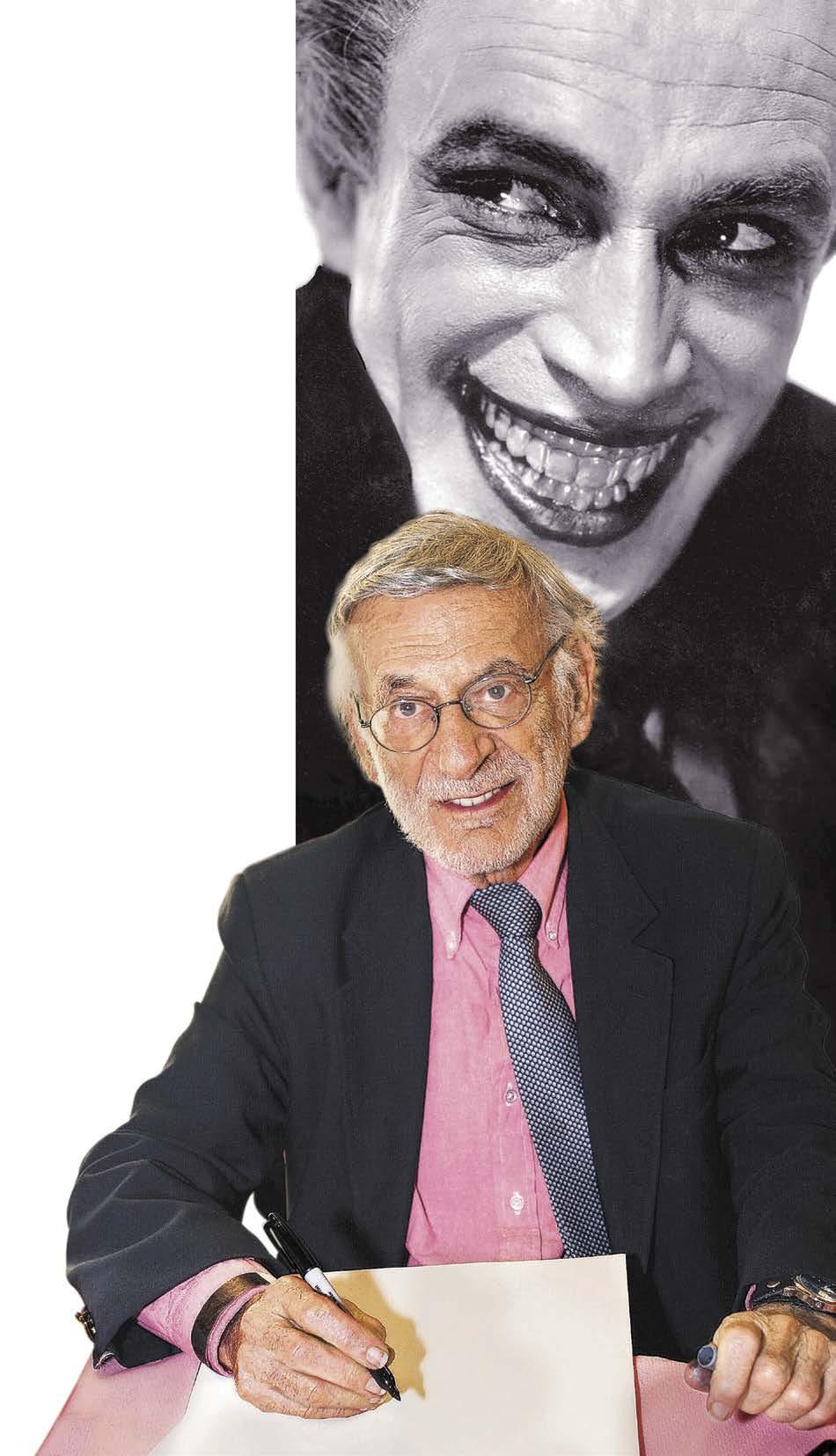 Jerry Robinson in 2003.
Background: Joker influence Conrad Veidt. 2003 photo by Kathy Voglesong
Jerry Robinson in 2003.
Background: Joker influence Conrad Veidt. 2003 photo by Kathy Voglesong
Dick Sprang

(1915-2000)
HE REFASHIONED THE CHARACTER, AND THE villains, as his own.
The most distinctive Batman artist of the Golden Age of Comics, Dick Sprang gave Bruce Wayne a square jaw and Dick Grayson an oval head. He played with perspective, sometimes imbuing his panels with a prescient trippiness. His villains could be garish, even grotesque. Sprang’s Joker, wearing a face that never quite adhered to the laws of human proportion, was a deformed, twisted nightmare. His Two-Face was like something dreamed up by Lon Chaney Sr. His Catwoman was sexy, but there was larceny and murder behind those alluring eyes.
The art of Dick Sprang was never equaled or duplicated. When that art was initially published, his byline didn’t appear. Savvier fans certainly recognized his work when they saw it. Some may have even wondered: Who is this mystery artist?
SPRANG WAS BORN IN
Ohio and turned pro when he was a teenager. Before seeking work in comics, the self-taught Sprang wrote and illustrated for pulp fiction magazines, doing western and detective stories.
“I saw that the pulps were just about being crowded out by the comic books,” Sprang told me during an interview in 1993. “This was a trend. Now, you can’t change a trend, but you can try and manage it. I saw opportunity in the comics.”
One day, Ellsworth paid Sprang the ultimate compliment. Said the artist: “Later, after some years, Whit told me, ‘Look, go your own direction with Batman. Do what you want to do with him.’ I took this as quite an endorsement. But analyzing it, I couldn’t see any dramatic changes to be made in this highly popular character.”
Regardless, Sprang’s Batman evolved over the years: “I widened Batman’s waist a bit. I made his figure a little more fluid in action. I shortened his bat-ears. But I retained Kane’s basic concept.”
As for Robin: “He was a little tough, that kid Robin,” said Sprang. “You know how a kid is. His head is very deep at the back. The skull is very round at the back. Sometimes I flattened him out a little bit. So (editor) Jack Schiff or one of the boys would suggest, ‘Hey, make his head more round!’ ”

“I made his figure a little more fluid in action,” said artist Dick Sprang of modifying Batman in his art. Photo illustration
At DC, Sprang was seen by editor Whitney Ellsworth. “Of course, I had no idea that I’d ever be put on Batman,” Sprang said. “Whit handed me three script pages of a Batman story that had already been drawn and published. He said to me, ‘Take ’em home.’ He said, ‘By the way, I hope you won’t look for the book in which these pages have appeared.’ I said, ‘Don’t worry, I won’t. I understand why you’re doing this.’
“He said, ‘Pencil it all, ink about half of it, do some lettering, put the balloons in, but get it out as quick as you can. I’d like it back in four days.’ Like he told me, I brought it back in four days.
“Whit went through it, squared it up, picked up the phone, and asked for a check. He turned to me and said, ‘What was your name again?’ He gave me a page-rate check for a story that had already been published! Well, this impressed me to no end.”
Initially, Sprang kept his drawing style on Batman more or less consistent with that of Kane — both artists were cartoony — but Ellsworth did not direct Sprang to mimic Kane outright.
“Of course, he told me to stay with the character,” Sprang said. “Naturally, I assembled a bunch of Bob Kane stuff and drew him as best I could. I followed that for quite some time.”
Sprang was directed to strive for authenticity in illustrating a series of whimsical back-in-time stories written by Finger in the 1950s.
The artist recalled: “Whit Ellsworth was quite insistent on this point. He said, ‘Look, kids read this stuff. When they see ancient Rome, ancient France, ancient Greece, I want them to see those countries as they existed — the architecture, the costuming, the horse gear, everything. Let it be somewhat educational for the kids.”
Sprang inked his own pencils until 1945, after which he was teamed with Charles Paris, who became Sprang’s exclusive inker for the duration of his career with DC Comics. “Charlie told me once that he enjoyed my stuff because there was no question what I intended,” Sprang said. “My pencils were not sketchy.”
SPRANG RETIRED FROM DRAWING BATMAN IN 1961, though he later produced special commissions for fans.
“So I still draw the character a lot,” he said. “But I must tell you, when I began to do the recreations in about ’84 or ’85, it was tough to get the character back. I found I’d lost a lot of facility.”
Was Sprang at all bothered about the fact that during all those years, he never received a byline for his Batman artwork?
“I know it annoyed some people to be ‘ghosting,’ but not me,” the artist said. “Only in the later ‘giants’ (reprint issues) did they start to give me a credit. That was just fine.
“Bob Kane had a contract; I think he owned the title. His name did appear on Batman, as you may recall, in that boxed signature of his. Whit had asked me if that would bother me when I first worked for him. I said, ‘Look, as long as my name appears on that oblong, green piece of paper.’ ” (Namely, the check.)
24


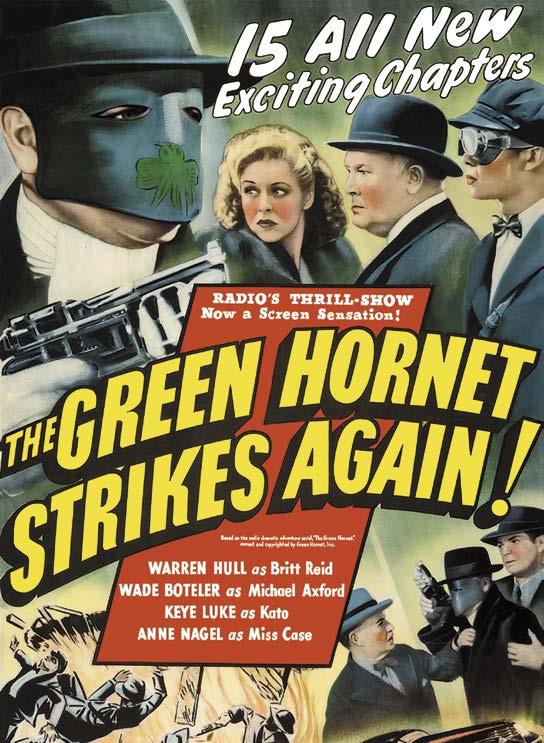

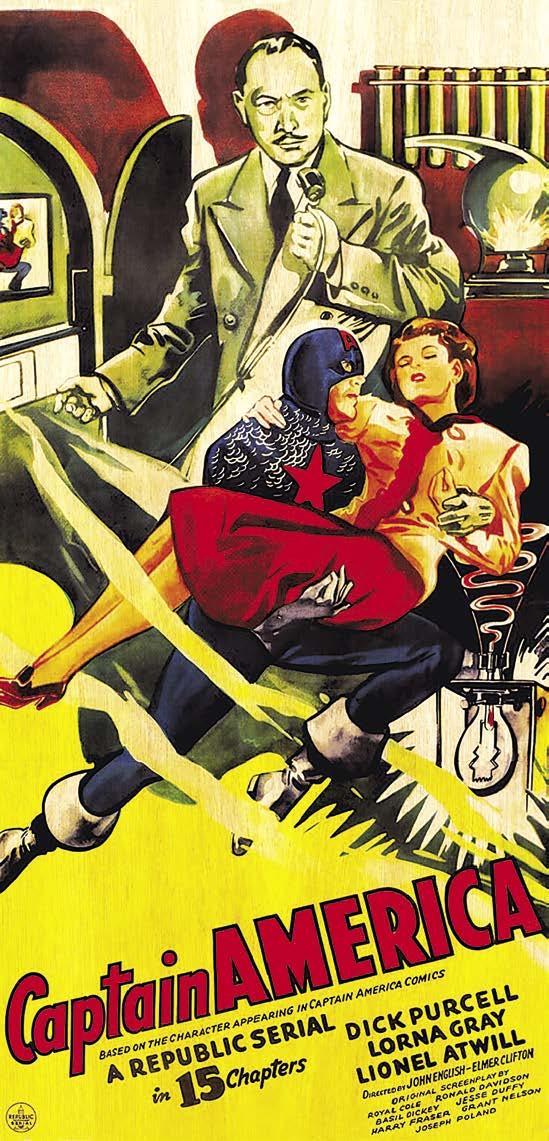
Cinematic
“MOVING PICTURES” WERE FIRST SCREENED IN Superhero comic books were first published in 1938. This leads to a simple question: What was the first superhero movie? Well, as with many burning topics, the answer is not as simple as the question.
The earliest live-action depictions of superheroes on film were called “serials” or “chapter plays.” These were not full-length movies, but a succession of short films (typically 12 to 15) that played theaters in weekly installments. Yeah, they were low-budget, low-tech, and formulaic, but their influence is still being felt. The TV Batman’s cliffhangers and periodic fight scenes were torn from the serials.
Universal’s serial “Flash Gordon” (1936) starred Olympic-gold-metal swimmer Buster Crabbe as Alex Raymond’s comic strip hero. Flash was not a superhero per se, but he resonated during the 1960s Batmania craze as one of nine characters that Captain Action — “the Amazing 9-in-1 Super Hero” — could change into when the toy was introduced by Ideal in 1966.
The serials also gave us masked avengers (some of whom originated in fiction and radio) who looked and acted a lot like superheroes. These include the Spider in “The Spider’s Web” (1938); “The Shadow” (1940); “The Masked Marvel” (1943); and mander Cody in “Radar Men From the Moon” (1952).
LIKE BATMAN, RADIO’S GREEN HORNET wore a mask but had no super powers. He, too, resonated during Batmania for a special reason: “Batman” executive producer William Dozier’s followup TV series “The Green Hornet” (1966-67). This makes the Hornet as much a super hero as Batman, and therefore worthy of the distinction First LiveAction Superhero on Film for his 1940 serial of the same title.
Cutting it finer, the First Live-Action Comic Book on Film was played by Tom Tyler in “The Adventures of Captain Marvel” (1941). The important qualifier in the previous sentence is the term “comic book,” as opposed to newspaper funnies, pulp fiction, radio, etc. (Yeah, it’s gettin’ geeky up in here.)
More comic book superheroes like Batman, Captain America and Superman would follow in their own serials. But 10 years would pass before a superhero finally top-lined a feature film as opposed to, yep, a serial. That film was “Superman and the Mole Men” (1951) star ring George Reeves, the First Live-Action Superhero Movie. It led to the First Live-Action Superhero TV Series — lots of “firsts,” eh? — “The Adventures of Superman” (1952-58) also starring Reeves.
Elsewhere in TV land, a series based on another of Captain Action’s original nine alternating characters, the Lone Ranger, aired from 1949 until ’57, with Clayton Moore wearing the mask.
Main image: Buster Crabbe with large space gun as Flash Gordon. Insets from top right: The Masked Marvel, Commander Cody, the Spider and the Shadow. © Universal Pictures;

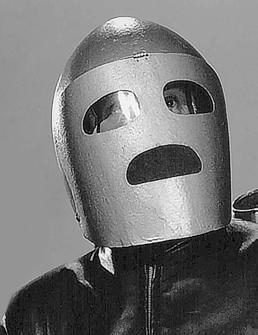

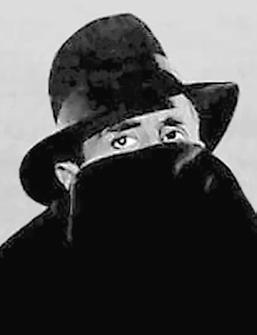
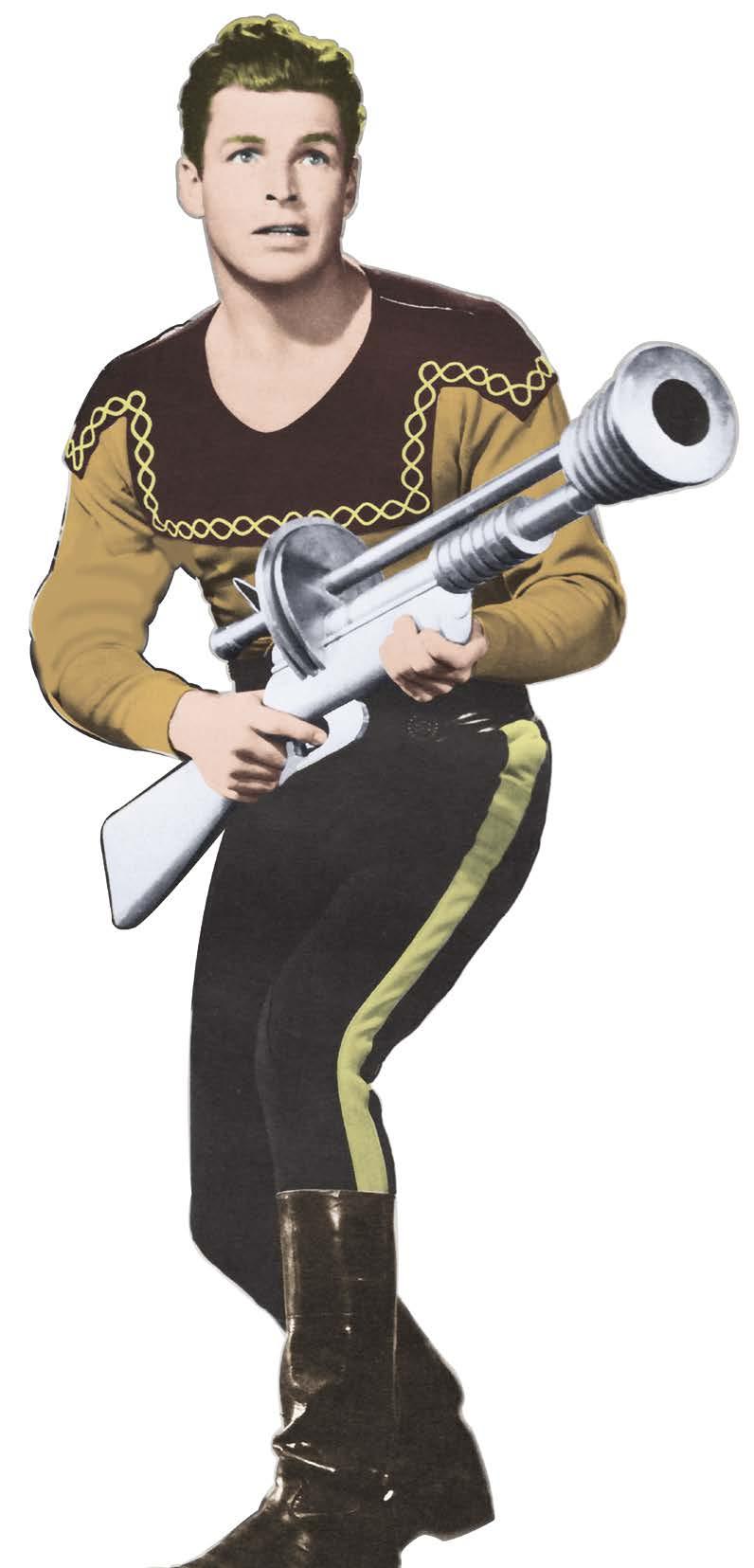
EARLY FILM & TV
© Republic Pictures; © Columbia Pictures
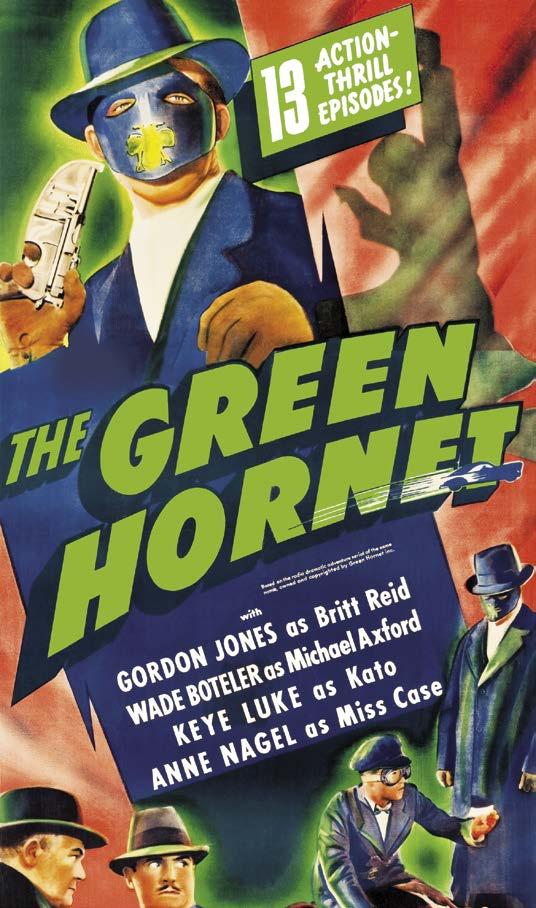
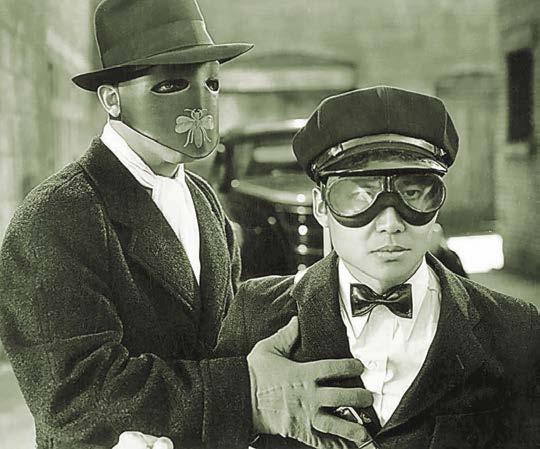
Gordon Jones and Keye Luke as Green Hornet and Kato. A lifetime later, Luke played Master Po on TV’s “Kung Fu.”
© Universal Pictures; © The Green Hornet Inc.
‘The Green Hornet ‘ (1940)
HOW’S THIS FOR TRANSPARENT EXPOSITION:
“It was a lucky day for me when I rescued you from that native in Singapore.”
That was Britt Reid (Gordon Jones), who had yet to adopt his Green Hornet persona, to his “houseboy” Kato (Chinese-American actor Keye Luke). Many Asian actors in old Hollywood movies were cast as houseboys. The white jackets were compulsory.
“He tried to kill me because I was Korean,” answered Kato, insuring that nobody in the World War II-era audience would think he was Japanese. “You shall never be sorry you saved my life.”
Ford Beebe and Ray Taylor’s “The Green Hornet” — the first of two back-to-back Hornet serials from Universal Pictures — is a classic origin story. But in keeping with the breakneck pace of the serial format, that origin is swiftly spelled out in dialogue and a bit of visual business. Britt and Kato’s transformation into masked crimefighters takes up a mere 11 minutes in Episode 1 of 13.
Britt — a “playboy” (just like Bruce Wayne!) who inherits a newspaper from his father — commends the “scientific knowledge” of Kato, who has developed a superfast car motor, a gas gun, and a buzzing siren that “sounds like the giant green hornet we encountered in Africa.” These spiffy accessories have been invented in secret, awaiting the day when Britt will finally put them to use, though he’s not yet sure how. “I’ll prove to that skeptical old dad of mine that I’m not just a playboy,” he tells Kato, leading us to suspect deep-set daddy issues are to blame.
AT THE SENTINEL (LOVE THAT STOCK FOOTAGE of a newsroom and a printing press), Britt is visited by a judge (Joseph Crehan) and the police commissioner (Stanley Andrews), who tell him they miss the anti-racketeering editorials his pappy used to write. “It was my father’s privilege to run this paper as he saw fit. I think the same applies to me,” is Britt’s pithy comeback.
He asks his visitors about their response to the current wave of racketeering activity: “What are you waiting for? A modern Robin Hood to lead you out of the woods?”
“Yes, Reid,” says the judge solemnly. “That’s just what this city needs, a Robin Hood.” Hmmm ...
So Britt dons a mask, Kato dons goggles, and the two take to the streets in that buzzing car. Posing as an underworld figure himself — something The Sentinel is only too happy to promulgate — the Hornet investigates, and smashes, one racket after another.
These include the building of a dam and tunnel with substandard materials; profiting from murder via a life insurance scam; sabotaging competing busing and trucking companies; a chop shop that sells parts from stolen cars; extorting “protection” money from launderers; and voter intimidation. (These guys do it all.)
Sourpuss Cy Kendall, who had a face made for gangstering, is perfectly cast as Munroe, the unseen racket boss’s enforcer.
The Sentinel’s watchful receptionist Lenore Case (Anne Nagel) is one of the few people to realize that the Hornet is really a good guy. “They ought to pin a medal on him instead of trying to catch him and put him in jail,” she says. Horror buffs remember Nagel from two Universal classics: She played the ingenue in the Boris Karloff-Bela Lugosi vehicle “Black Friday” (1940), and Lon Chaney Jr.’s kind-of love interest in “Man Made Monster” (1941).
Luke played Lee Chan, “No. 1 son” of Charlie Chan, in the film series about Earl Derr Bigger’s Chinese detective. Luke also played blind Master Po in TV’s “Kung Fu” starring David Carradine.
30

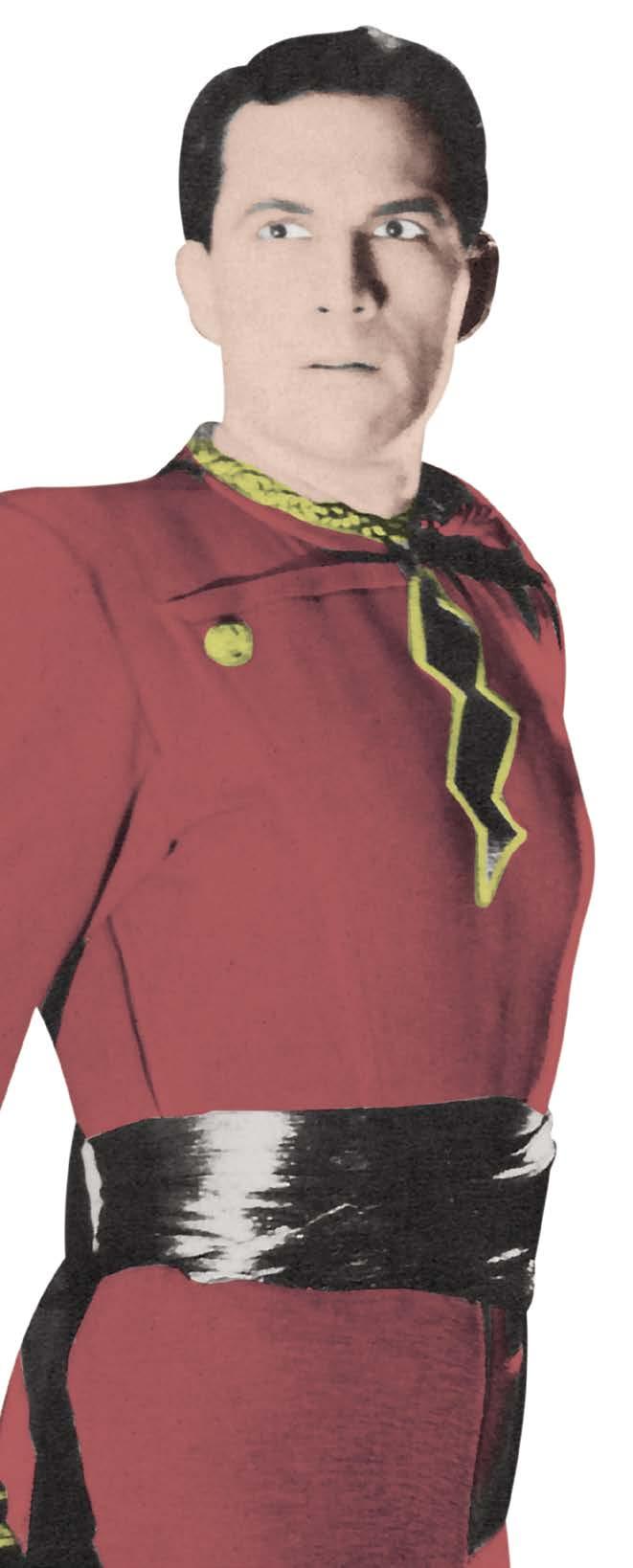
‘
The Adventures of Captain Marvel ’ (1941)
A MASKED CRIMINAL MASTERMIND WHOSE identity is unknown to his own flunkies seeks to obtain a superweapon with which to rule the world, all the while being pursued by a costumed avenger.
That could be the plot of any serial based on a comic book superhero. In this case, it happens to be the very first one: Republic Pictures’ “The Adventures of Captain Marvel” co-directed by William Witney and John English.
While not exactly capturing the humor and whimsy of the Fawcett Publications comic books, the serial may well be the best of the wide 1940s field. Tom Tyler cut a dashing figure in the Captain Marvel getup, moving gracefully and playing the character straight — no winking, no barely concealed humiliation.
IN A “VOLCANIC LAND” CHEERLESSLY called the Valley of Tombs, an archeological expedition discovers an ancient tomb containing a golden idol in the form of a scorpion. Accompanying the expedition is radio journalist Billy Batson (Frank Coghlan), who encounters a robed, bearded wizard named Shazam (Nigel de Brulier).
The idol must not fall into the wrong hands, Shazam warns Billy. To prevent this, Billy is granted the power to transform into a superbeing. Says the old man: “All that is necessary is to repeat my name … Shazam!”
The golden scorpion is outfitted with five special lenses which, when positioned correctly, emit a destructive beam that can melt a mountain. A hooded fiend who calls himself the Scorpion — even the actor who plays him is listed only as “the Scorpion” in the credits — wants that idol. “Whoever controls the device will have power that men have dreamed of since the beginning of time,” he roars.
But expedition members cleverly divide the lenses among themselves in an attempt to keep things honest. (The real reason, savvy viewers know, is to give the flunkies a reason to pursue said expedition members for 12 chapters.)
Joining forces with Billy are Betty (Louise Currie), who is unafraid to get her dainty hands dirty, and Whitey (William Benedict), Billy’s kinda goofy wingman. Benedict’s Bowery Boys character was likewise called Whitey. Typecasting? Or “othering” just ’coz the actor’s pallor bordered on translucent?
Legendary stuntman David Sharpe put his gymnastic training on display, effortlessly executing a standing back flip in costume. For the flying sequences, a dummy gliding along a wire is sometimes utilized. Though not 100 percent convincing — the face is clearly that of a mannequin — seeing the dummy “fly” through actual environments (not rear screen) with cape flapping is so darned cool, you gladly overlook the deceit. On those occasions when Tyler’s face is visible, he achieves credible takeoffs and landings.
This Captain Marvel can be a badass. One of his signature moves is to lift a bad guy over his head and throw him. At one point, Marvel cavalierly tosses a baddie from atop a tall building. There’s nary a scream, but it’s a cinch the guy doesn’t survive the plunge. Judge, jury and executioner — it wouldn’t happen in a Fawcett comic book.
Tom Tyler moved gracefully and played it straight.
© Republic Pictures; © Fawcett Publications
‘Superman ’ shorts (194 1 - 4 3)
THE FIRST CINEMATIC DEPICTION OF SUPERMAN, AND the first time the endless possibilities of the superhero genre were fittingly explored on film, happened in cartoons.
Fleischer Studios — the animators behind those fantastically strange Popeye and Betty Boop shorts — kicked off a series of seven-minute sci-fi masterpieces that comprise the Superman shorts. The Technicolor cartoons (most directed by Dave Fleischer) did what live action and even comic books could not, by demonstrating Superman’s super strength, speed and flight in imaginative and realistically executed scenarios. The Fleischers achieved a sweeping scope in their heavily storyboarded sequences of crackling laboratories, gleaming superweapons, giant robots, lumbering monsters, and teeming Metropolis itself.
Lois Lane (initially voiced by Joan Alexander) was a rare protofeminist character in the genre. She never flinched in her pursuit of The Big Story, despite sexist attitudes of the era. Lois’s snooping invariably resulted in her being lowered into a bubbling cauldron; or suspended over an active volcano; or stuffed into a torpedo awaiting launch. This is where the Man of Steel (initially voiced by radio’s Superman, Bud Collyer) came in.
The episodes typically wrapped with a Daily Planet headline (over Lois’s byline) summarizing the adventure. Lois would deflect compliments on her reporting by adding, “ . thanks to Superman!” Clark Kent then winked at the viewer.
The debut short, “Superman,” was nominated for an Oscar. The shorts popularized (but did not outright introduce) the concept that Superman can fly; previously, he “leaped.” Superman’s co-creators Jerry Siegel and Joe Shuster were billed in the opening credits. The “faster than a speeding bullet” intro narration originated in these shorts, and was retained for the 1950s TV series.
FLEISCHER STUDIOS’ NINTH SUPERMAN
short, “Terror on the Midway,” was its last. It’s commonly reported that Paramount Pictures “absorbed” the Fleischers’ operation after two costly features underperformed at the box office. But in “The Fleischer Story” (Da Capo Press, 1988), author Leslie Cabarga suggests a more concerted takeover by Paramount.
Not helping was the fact that the Fleischer brothers — Max, Dave and Joe — often butted heads, to put it mildly, over remuneration, credit, workplace ethics and morale.
Despite greatly reducing the number of drawings, Paramount’s new animation arm Famous Studios maintained a degree of quality in the remaining eight shorts. Two key Fleischer refugees, Seymour Kneitel (Max’s son-in-law) and Isadore Sparber, were hired as production chiefs.
Five of the eight Famous Studios shorts are World War II-themed. In “Japoteurs,” the “world’s largest bomber plane” (an American invention) is hijacked during its maiden voyage. In “The Eleventh Hour,” Superman commits acts of sabotage in Japan. In “Destruction Inc.,” Lois investigates a munitions plant suspected of enemy infiltration. “Jungle Drums” ends with an Adolf Hitler cameo. In “Secret Agent,” a beautiful undercover agent embarks on a desperate mission to deliver a dossier detailing enemy plans.
Some shorts present regrettable stereotypes. We’ve been here before. Such cringe-worthy scenes can really ruin the party for classic movie buffs.

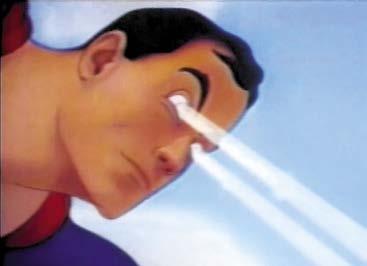


 Superman’s sci-fi roots were visualized in the animation medium. © Paramount Pictures; © Fleischer Studios; © DC Comics Inc.
Superman’s sci-fi roots were visualized in the animation medium. © Paramount Pictures; © Fleischer Studios; © DC Comics Inc.
Clayton Moore
THE LONE RANGER WAS — NO PUN INTENDED — A straight shooter who never took a drink or killed indiscriminately, unlike some movie cowboys. “Well, the show started on radio in 1933. We, on the television series, lived up to the rules and regulations of the radio show,” said Clayton Moore (1914-1999), who portrayed the masked western hero on TV alongside Jay Silverheels (19121980) as Tonto. “It was a good moral program. Great for the kids. Great for the grownups, too. We need it today.”
Moore played in 169 of the 222 episodes of “The Lone Ranger,” which aired on ABC from 1949 through 1957.
“We pioneered the TV business,” Moore told me in 1992. “We started in 1949. We worked pretty fast, believe me. The budgets were very low in those days. We kept pretty active. And, of course, we had the fights going. Jay and myself were very careful. We rehearsed the stunts quite a bit. We made sure that nobody got injured. There was a tremendous amount of horse work. We did all of the horseback work, too. I love horses.”

SAID MOORE WHEN ASKED HIS THEORY ON on the enduring appeal of the Lone Ranger: “Well, I don’t think it’s only the Lone Ranger. I think it’s the fair play and the honesty that the cowboys showed, fellas like Roy Rogers, Gene Autry, and the Durango Kid, Charlie Starett. We had great heroes in the early days, too — Ken Maynard, George O’Brien, Colonel Tim McCoy, Tom Mix, Hoot Gibson, Buck Jones.
“I was quite a western (movie) admirer when I was a kid. It was Americana, the trials and tribulations the pioneers went through in the early days across the desert and the mountains with the storms and the snow. A tough life. They survived. They gave us what we have today: America.”

Said Moore of his costar Silverheels: “He was a wonderful man to work with. We were certainly good friends off the screen as well as on the screen. We shook hands for the first time in 1949. “Jay was a full-blooded Mohawk Indian. He was born on the Six Nations reservation in Brantford, Canada. Good sense of humor. Very quick study. Good athlete. Wonderful horseback rider. He was quite a gentleman. We kept in touch constantly. We did a lot of personal appearances together years ago.”
Said Moore of another co-star, the white thoroughbred horse Silver: “A beautiful animal. Very fast horse. Never got injured. Was very calm. Well kept. He was bathed every day. You know, with a white horse, you’ve got to keep him nice and clean, so he’ll look nice.”

Did Moore wish to reprise his role in Universal’s “The Legend of the Lone Ranger” (1981)?
“I would have liked to have done the feature that they made at that time, of course,” the actor said. “Anything pertaining to the Lone Ranger, I was always very eager to participate in.” The role instead went to a relative unknown named Klinton Spilsbury, and the movie bombed. I asked Moore if he thought he would have done a better job as the Ranger. There was a brief pause. “I think everybody tried real hard to make a nice picture,” he finally said. “I got out of that one, didn’t I?”
Clayton Moore, then 78, again wore the Lone Ranger’s mask in 1992.
Photo by Kathy Voglesong
Noel Nei ll
THE FIRST ACTRESS TO PLAY LOIS LANE, GAL PAL of Superman, never read Superman comic books as a girl.
“I don’t think girls were into comic books,” Neill (1920-2016) told me during a 2002 interview. “They were into dolls and things like that. I think the boys were into Superman.”
Neill originated the role in 1948 in the first of two Superman serials starring Kirk Alyn. When Phyllis Coates quit the TV series “The New Adventures of Superman” after one season as Lois, Neill was hired to replace Coates without auditioning.
She explained: “Mr. (Whitney) Ellsworth — who had been with National Comics for many years in New York and was one of the top dogs — was sent over to watch over the show. He and his wife moved out there. So I didn’t interview, because they knew that I had done the serials with Kirk Alyn. I had done those 30 chapters with Kirk. The producer just called my agent and said, ‘Does Noel want to play Lois Lane again?’ And he said, ‘Well, obviously, she will.’ And that was that.”
NEILL WORE MUCH FASHIONABLE ATTIRE IN THE serials, including some wacky-in-retrospect hats. But not on TV.
“I had three suits, all alike,” she said with a laugh.
“We would shoot 26 episodes in 13 weeks. First, we would do all of the scenes with the ‘heavies’ (villains), as we called them in those days — you know, the character actors — for several weeks, and then get rid of them. In the last two weeks of filming, the four of us (Neill, Reeves, Jack Larson as Jimmy Olsen and John Hamilton as Perry White) would get together at the Daily Planet and do all of our stuff for the 26 episodes. Of course, this was all difficult to keep track of. The poor little script girl!
“That’s why we wore the same outfits all the time. Because there’s no way the script girl could possibly keep track of what we were wearing. So we just wore the same thing.”
Cast members, too, found it hard to keep track of continuity.
“We just kind of winged it,” Neill said. “Of course, wearing the same outfit all the time, we didn’t have to think too much. But we would get the call sheets every afternoon telling us what we’d be doing the next day. So we would collect that and put it in our daily book and give it a quick rundown. We used to say, ‘All the dialogue is the same; they just change the name of the heavies.’ ”
THE PACE WAS EASED BY CAST CAMARADERIE.
“It was fun just working together,” Neill said. “We were so used to each other after doing — what? — 70-some episodes together. Jack was a very good actor and George was a fabulous actor and Mr. Hamilton was just hysterical. He was a riot.”
Being a superhero series and all, “The Adventures of Superman” had more special effects than the average show. The FX were overseen by Thol “Si” Simonson.
“One morning, Jack and Mr. Hamilton and I were at the cave. It was the first shot of the morning. The night before, Si had built the wall that George was to come through. They would let it set for a certain amount of time. But something happened; it set just a little harder than it should have. And so the director, George Blair, yelled, ‘OK, everybody! One take! One take only!’
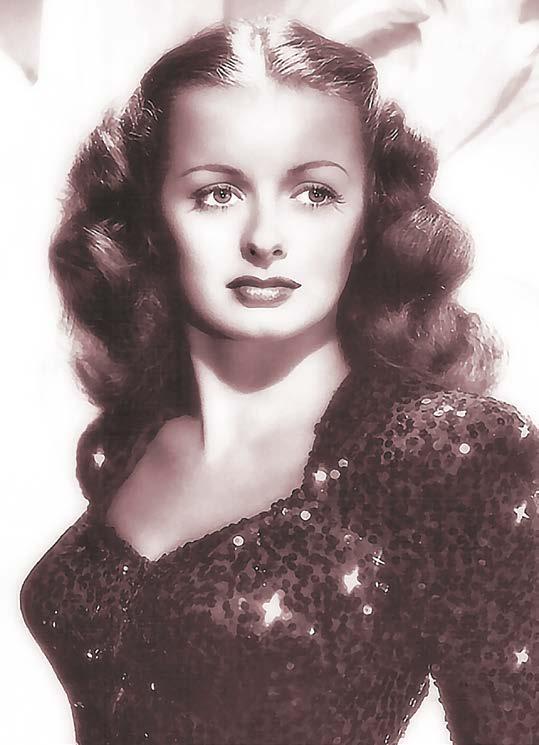
Noel Neill in a glamor shot circa the late 1940s. Opposite: Neill, then 83, showed her Superman colors in 2003.
“Then he yelled, ‘Action!’ And so there we were, waiting for George (Reeves) to come through the wall. And the next thing we knew, we saw one hand and one foot in the wall! And there was dead silence. Everybody just stood there staring. And finally, somebody yelled, ‘George (Blair)! Cut the film! Cut the film! George (Reeves) is stuck!’
“And he was, bless his heart. George Reeves pulled himself back out of this wall and took a very courtly, Southern bow to everybody and said, ‘I will see you all tomorrow.’ So there was a mad scramble to redo the day’s filming. ‘What do we do?’ ‘Help! Help! Help!’ Scatter, scatter, scatter. But bless his heart, George (Reeves) didn’t scream and yell or anything.
“Mr. Simonson was so upset. But it was just the timing — a little bit too long, and the wall hardened. But he was so effective with all of this. Jack Larson always said that he put himself in Si’s hands because, you know, fire shots were coming up out of the stage and off the walls and everything. But we trusted him.”
The way the production was structured, there were long stretches of inactivity for the cast.
“Everybody would be pretty well scattered,” Neill said. “See, we shot 26 shows in 13 weeks. According to our contracts, which were laughable, they could give us two and a half years off and still get us back again if they wanted us. So we wouldn’t see each other for two and a half years! Everybody went their own way. It was kind of strange. But it made for a lot of happy reunions.”
40
2003 photo by Kathy Voglesong
Mourning Superman
We didn’t know he was dead. We only knew he was Superman.
The 1952-58 TV series “The Adventures of Superman” starring George Reeves received a nice boost from 1966-era Batmania.
“Watch Superman on Television!” proclaimed a 1966 full-page advertisement that ran in comic books, the medium of Superman’s birth. “America’s favorite adventure character comes right into your home in thrilling super action!” The ad featured a list of 83 stations that carried the show. (To this day, when I see the ad, I look for my local station: WKBS, Channel 48 in Philadelphia.)
The rub: The Batmania generation had to learn — in a slow, protracted process — that the star of the series was long dead. We didn’t typically get the news from parents or teachers. More likely, it was reported via the kid grapevine in the schoolyard or around the neighborhood. This was, in its own way, quite traumatizing.
Reeves’ co-star, Noel Neill, told me spirits were high among the cast in June 1959, when they were informed by producer (and DC editor) Whitney Ellsworth that 26 more episodes were ordered.
As she told me in 2003: “I said, ‘Gee, that’ll take us almost into Christmas, and give us a little Christmas gift.’ Mr. Ellsworth said, ‘Come on by. We’ve got the same offices. Come see if your old costume still fits.’ So I stopped by a few days later. George Blair, the director, and George Reeves were together playing their usual gin rummy game, happy as little bugs. Everything was fine.


“George (Reeves) was going to direct a movie. Anyway, he was very happy. We had those 26 shows to look forward to.”
A few days later, on June 16, 1959, Reeves was found dead of a gunshot wound to the head in his Benedict Canyon home. The death was ruled a suicide, despite irregularities in witness statements and some evidence. Neill learned the tragic news in an odd way. She received a call from Reeves’ fiance, socialite Leonore Lemmon, but initially misunderstood who Lemmon was talking about.
Recalled Neill: “His girlfriend called and asked if I’d heard what happened to George. I thought she was talking about her husband. I said, ‘No. What happened to him?’ We had this idiotic conversation. She finally said, ‘No! Not my husband! George Reeves!’ I said, ‘Oh, my gosh!’ So that was the first I heard of it.
“There was no talk of making any more (‘Superman’) shows, because the gentlemen in New York had said, ‘Well, we’ve got 104, so we’ll just run ’em forever. We don’t need any more.’ Which was good for them, bad for us.”
Neill said the tragic news was under-reported, but not because of some coverup or conspiracy. “Everything was quickly hushed up, shall we say, any publicity,” the actress said. “Because, well, it was a children’s show, and they didn’t want all the children in the world to realize that Superman was human after all.”


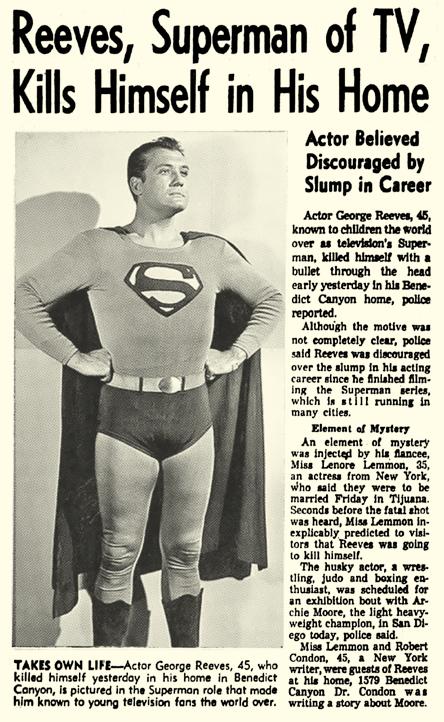
Dynamic television
EVERYTHING CAME TOGETHER. THE MOON was in the seventh house. A perfect thing happened in 1966, and that thing was “Batman.”
Producer William Dozier — not a comic book guy — and writer Lorenzo Semple Jr. created what seemed, to a world of mostly non-comic-book people, like a comic book brought to life. (Only true comic book people, then a marginalized demographic, knew better.)
The production became Dozier’s baby, but it didn’t start that way. ABC had the rights (and a hole in its schedule), and made an overture to Dozier, who agreed to a meeting. Never having read Batman, Dozier bought “seven or eight copies of the vintage Batman comic books” for crash research.
“At first, I thought they were crazy,” Dozier (1908-1991) told Joel Eisner in “The Official Batman Batbook” (1986).
“I really thought they were crazy, if they were going to try to put this on television. Then I had just the simple idea of overdoing it, of making it so square and so serious that adults would find it amusing.”
DOZIER MOUNTED A COLOR-SATURATED production fueled by Semple’s hip scripts (with subsequent writers taking his comedic cue). The casting gods, too, were with “Batman.” Adam West’s Bruce Wayne was a human mannequin and a grown-up Boy Scout. Burt Ward’s Dick Grayson was the last gasp of well-behaved pre-hippie youth.
They were bolstered by veterans Madge Blake (fidgety Aunt Harriet); Alan Napier (stalwart Alfred the butler); Neil Hamilton (no-nonsense Commissioner Gordon); Stafford Repp (stereotypical Irish cop Chief O’Hara); plus the many stars who gleefully hopped onto the roller coaster as guest villains.
Without West, would “Batman” have rocked our world? Also considered for the role were Lyle Waggoner, Mike Henry and Ty Hardin. Fine professionals all, but come on. Dozier already had his amazing, colorful production built and the first scripts written. In the 11th hour, all he needed was for the perfect Batman to stroll through his office doors.
The show kept things light, though there was one reference to Batman’s violent origin story — the one in which Bruce Wayne’s parents are shot dead in the street in front of young Bruce, triggering his vow to fight crime.
In West’s very first words as Bruce, he addresses a group whose anti-crime program he supports financially. Bruce speaks of the time “when my own parents were murdered by dastardly criminals.” This was the first — and last — instance of the TV “Batman” getting real like in the comics.
Burt Ward and Adam West (shown in 1992) weren’t household names when first cast in “Batman.”
Opposite: SOCK! POW! It’s the opening credits!
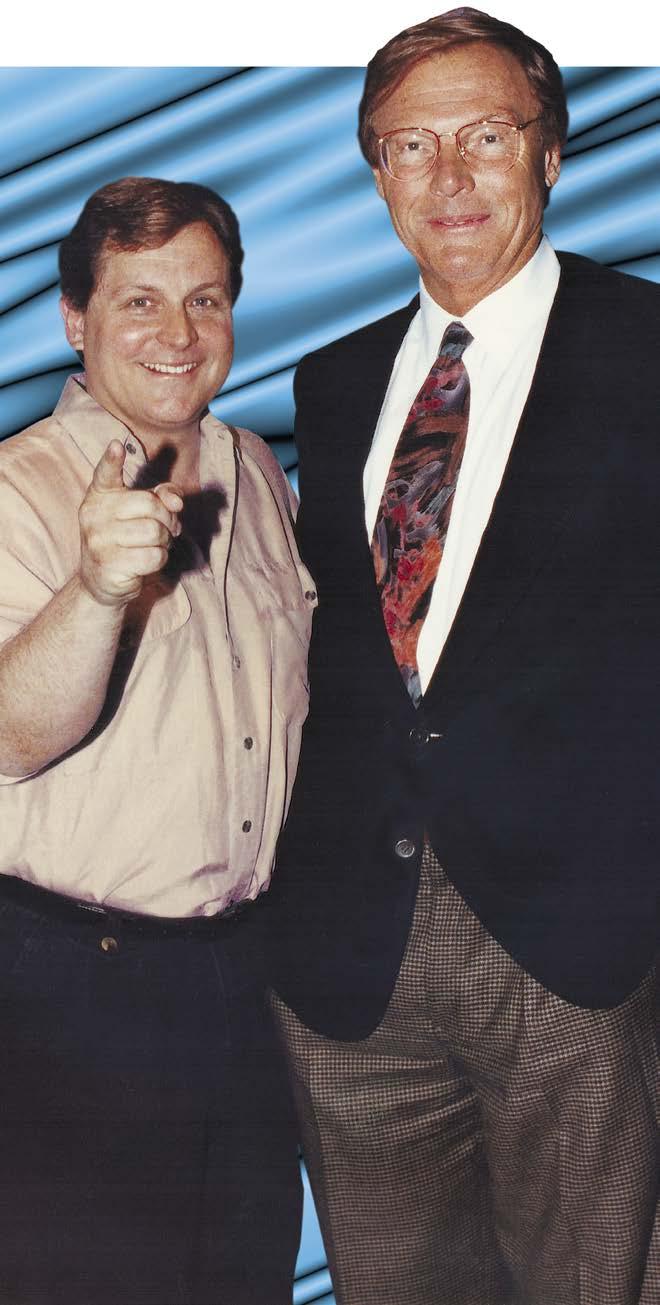
HOLY RATINGS!
45
1992 photo by Kathy Voglesong; opposite © DC Comics Inc., © Warner Bros.
Adam West
HE WAS THE RIGHT (BAT) MAN FOR THE JOB.
An actor who could be both leading man and clown, Adam West (19282017) was born Billy West Anderson in Walla Walla, Washington. In his 1994 memoir, he was candid about his mother, Audrey, an alcoholic who West knew, even as a youngster, was not faithful to his father. Audrey had dreams of stardom, and once told West that but for his birth, she could have been Joan Crawford. Armchair psychologists might point to these events as the roots of West’s own issues with intimacy and commitment.
West worked as a radio disc jockey in Walla Walla … spent a year with the McClatchy news agency … worked in an embryonic television facility at Fort Monmouth, N.J., while in the Army … migrated to Hawaii, where he made his film debut in the Boris Karloff movie “Voodoo Island” (1957) and hosted “The Kini Popo Show” on local TV … migrated to Los Angeles ... and won promising early roles in “The Young Philadelphians” (1959), TV’s “The Detectives” (1961-62), “Robinson Crusoe on Mars” (1964) and “The Outlaws is Coming” (1965).
In the end, a silly little TV commercial for Nestlé’s caught the attention of producer William Dozier, leading to the role of a lifetime.
I interviewed West on six occasions between 1992 and 2010.
Q: Is it ever painful for you to talk about “Batman”?
WEST: Not at all. I have no rancor, no bitterness. I don’t cry over all the money I’m missing.
Q: When did you realize that you had become irreversibly famous?
WEST: It was when I got home from the studio on the night “Batman” was scheduled to go on the air. I stopped at a market in Malibu, where I lived at the time, to grab a steak and a six-pack of beer for dinner. I was in a hurry and overworked. And I heard, at the checkout, “Come on! Hurry up! We’ve gotta get home to watch ‘Batman’! Faster!” And I thought, uh-oh, this could be the start of something.
Q: When “Batman” premiered, us kids tried to stay faithful to “Lost in Space” on CBS. But once we saw you and Burt in those costumes …
WEST: That’s very funny. See, that’s how we grabbed the kids. And then as adults, they watch it later and then they get the jokes.
Q: You grew up during a great time for Batman comic books; you were 11 when the character debuted. Did you read them as a child?
WEST: Yes, I did. My education was elective, not selective.
Q: Did you bring anything from the comics into your portrayal?
WEST: Well, you know what you do? You grab a little from something and something else, and you scratch it out. What I called on there was not so much the comic book, literally, but the sense memories of having read it and what it did to me. You know what I’m saying? As a kid. How it affected me, to call that back.
Adam West (shown in 1994, opposite, and 1992, right) was constantly reminded that the public equated him with Batman.
Who else could have worn the cape and cowl?
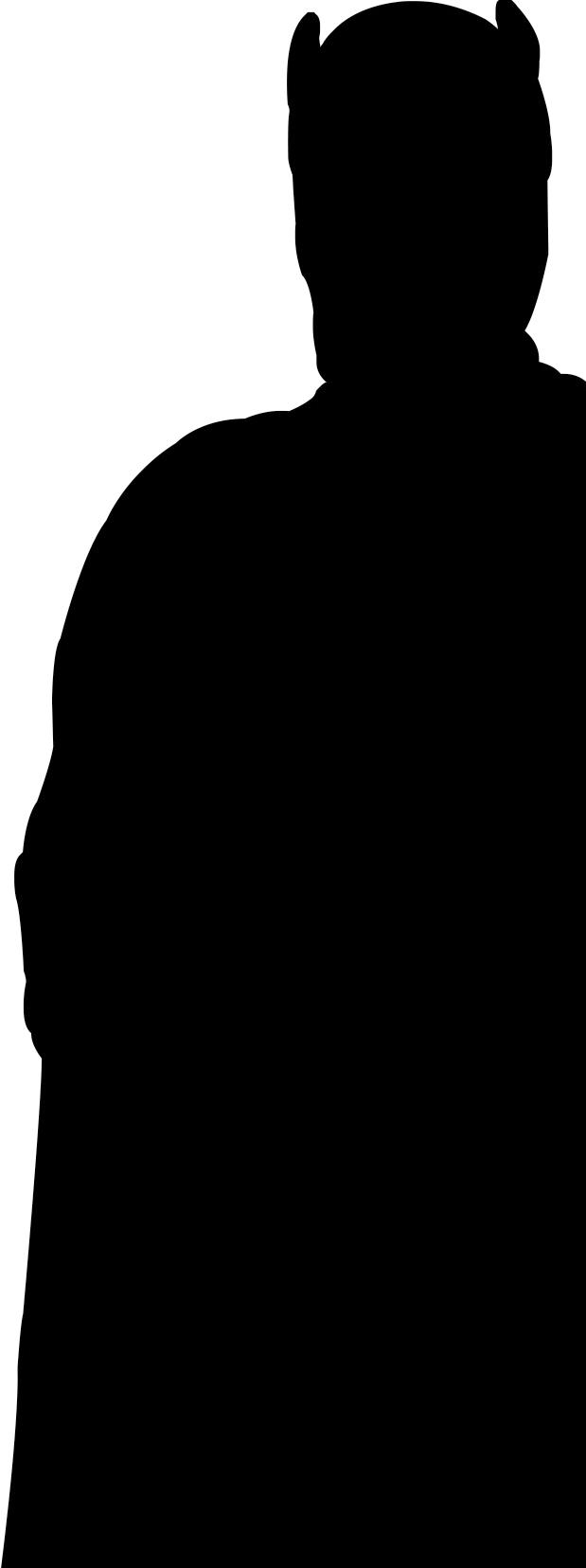
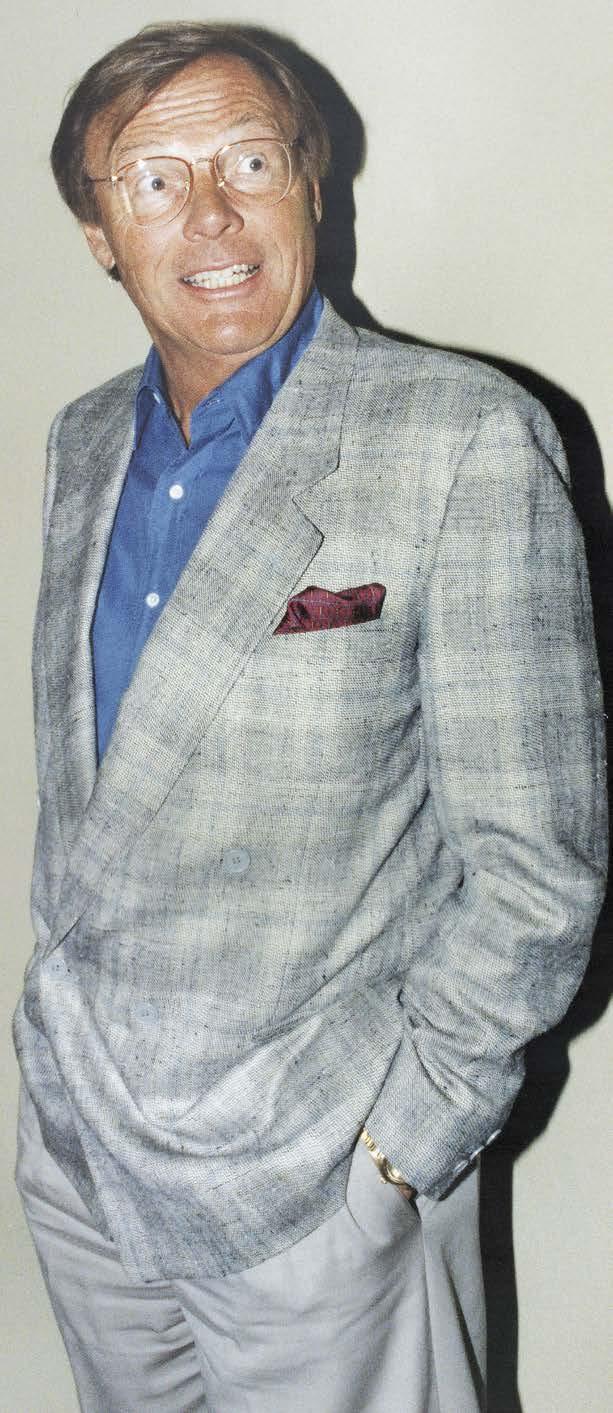 Photos by Kathy Voglesong; “Batman” © Warner Bros.; character © DC Comics Inc.
Photos by Kathy Voglesong; “Batman” © Warner Bros.; character © DC Comics Inc.
Q: What were your other injuries on that first episode?
WARD: On the same show, there’s a scene where Batman breaks through the subway. This is the Frank Gorshin one, the first one. I was on the table, and Batman breaks through the tunnel in the subway to rescue me. The special effects men were to have built a “breakaway” set, so that when they put in these light explosives, it would just break away and Batman could come through. Well, the people that built the set, in their infinite wisdom, didn’t make it a breakaway set. They built a regular set with 2x4s. There wasn’t time to cut it all up and redo it. So again, the special effects people, being the geniuses that they were, planted three sticks of dynamite and nearly blew the entire sound stage down! I had 2x4s landing on my head! I went right back into the emergency ward.
Then — on the same show — I’m climbing out of a burning car and Batman, being the main character, gets to come out first. So I’m down there in this flaming car while Adam stands there, taking quite a while in front of the camera before coming out. And just as I start to jump out, the car accidentally blew up and threw us both to the ground. I got scorched and went back in the emergency room.
So that was three (laughs). Anyway, quite a lot of things like that happened. I thought I wasn’t going to survive it.
Q: As a show-biz newcomer, were you aware of the legendary status of many of the guest stars who appeared as villains?
WARD: Oh, sure. I was like a kid in a candy store. Every one of these superstars shows up, and here I am, just a kid working with them, you know? I was just a 20-year-old kid brought up in a sheltered life. So for me, all of this stuff was so much of a change. It was really a treat to work with so many greats. I don’t have one complaint about one person on “Batman.” They were all terrific. It was like a learning experience for me, working with people like Tallulah Bankhead and George Raft. Great, great actors and actresses. They were fabulous. Each one brought something different to the show. I just had the greatest time.
Q: Were there any guest villains who didn’t “get” it?
Tallulah Bankhead was, first and foremost, a stage actress ...
WARD: No, she was wonderful. “Batman” was such a success that everybody wanted to do the show. Everybody wanted to kind of let go and be crazy, and that’s what they did.
Q: It seemed that the top four villains on the show were Riddler, Penguin, Joker and Catwoman. The movie supported this view.
WARD: Well, they may have been the four who were selected for the movie, but I’ll tell ya, I really enjoyed working with a lot of the others, too. Victor Buono, who played King Tut, was incredible. I think Vincent Price, who played Egghead, was great.
Q: Adam said Otto Preminger was the most difficult guest.
WARD: I had heard stories about the horror, the terror of this man Otto Preminger. But he was very nice to me.
Q: How about his fellow Mr. Freeze, George Sanders?
WARD: George Sanders had an elegance and a class. He just reeked of class. He kind of reminded me of Cesar Romero. Very classy man. Just totally professional. Totally sophisticated. He was just terrific. The fact of his suicide (in 1972) was such a surprise. It really stunned me, the tragedy of his death.

“It was the first thing I ever tried out for,” said Ward (shown in 1992) of auditioning for the role of Robin.
Photo by Kathy Voglesong
Q: The outfit you wore as the Riddler was unforgivingly form-fitting. Did you have to lay off the pasta in order to squeeze into it?
GORSHIN: I love pasta (laughs). I always eat pasta. But that’s not fattening. It’s what you put on that pasta that’s fattening. No, at the time, I was pretty trim. I only weighed 155 pounds, as opposed to now. Now, I’m between 175 and 180. The costume was dictated by the comic book. That’s what the comic book was. If you look at those old comic books, he wore the same skin-tight outfit. The same one I wore, the same one Jim Carrey wore (in “Batman Forever”).
Q: Adam and Burt said they got pretty banged up while shooting “Batman.” Do you have any dangerous stunt anecdotes?
GORSHIN: When I came down that slide in that first episode, I had a tough time doing that. When I’d get down to the bottom of the slide, I always ended up on my can. That was embarrassing, to have everybody watching. But then after a few tries, I got it.
Q: As the Riddler, sometimes you wore the mask, sometimes not. Did you do this unconsciously, or was it in the script?
GORSHIN: Well, the Riddler wasn’t worried about being recognized. But he would feel, from time to time, that the mask made him more attractive (laughs).
Q: Burt Ward has called Adam West, with affection, the world’s greatest upstager. Did he upstage you?
GORSHIN: No. It was Burt Ward who upstaged me. He’s the world’s greatest upstager (laughs).
Q: What was the main difference between making “Batman” the TV show and “Batman” the movie?
GORSHIN: Really, there was no difference, although on the show, each episode would be dedicated to one particular villain. On the movie, we all got to work together — Cesar and Burgess and Lee Meriwether. In that respect, it was different. And it took more weeks to shoot than an episode, of course.
Q: Before “Batman,” you did those wild impressions of Kirk Douglas and Burt Lancaster on “Ed Sullivan.” Did you ever hear from those guys?
GORSHIN: I heard they were flattered by what I did. Kirk Douglas himself told me he loved to watch me do it. He said that if he ever forgot how to do himself, he would call me (laughs).
Q: Are there ever times when you regret being so identified with the Riddler?
GORSHIN: No! How could I resent it? It was really an important part of my career. I like to think that people are aware that I do other things too. I can’t resent it, because it did a lot for me. Even now, I get kids who are 10, 11 years old who know me because they’ve seen me as the Riddler. So it’s kept me alive, so to speak, my career.
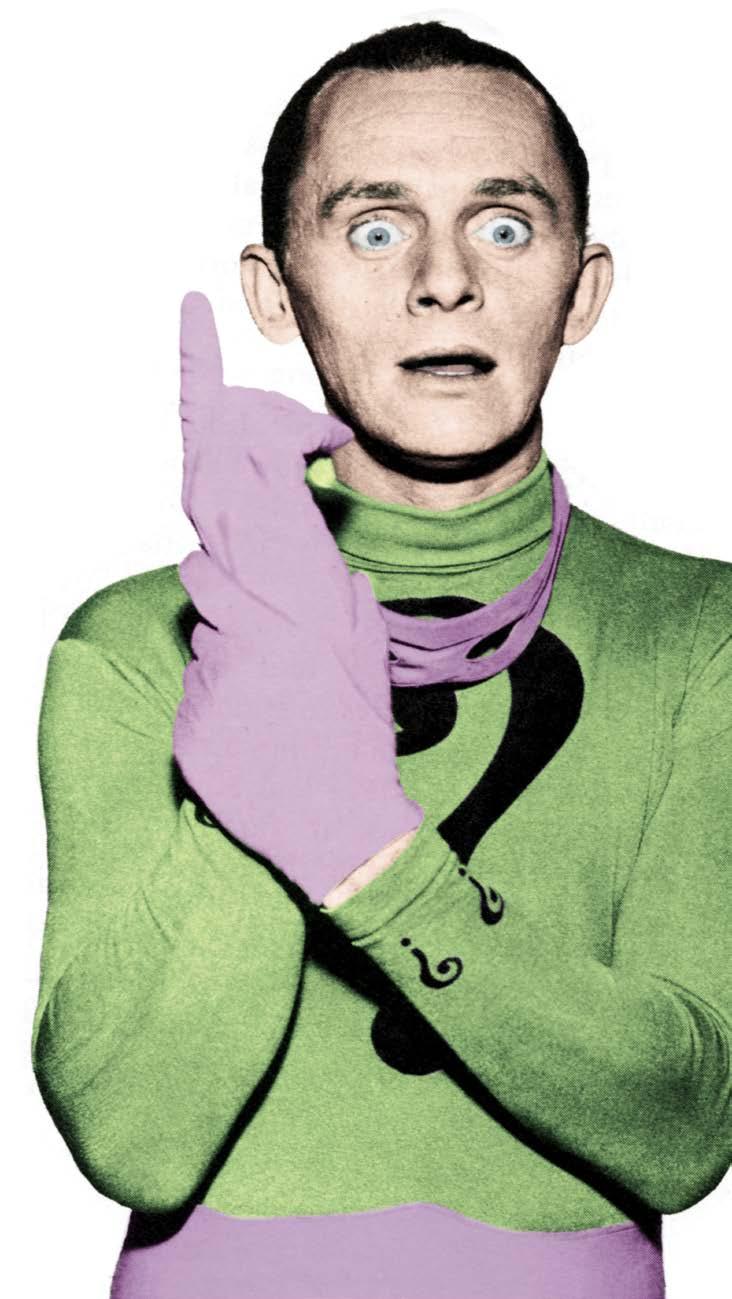
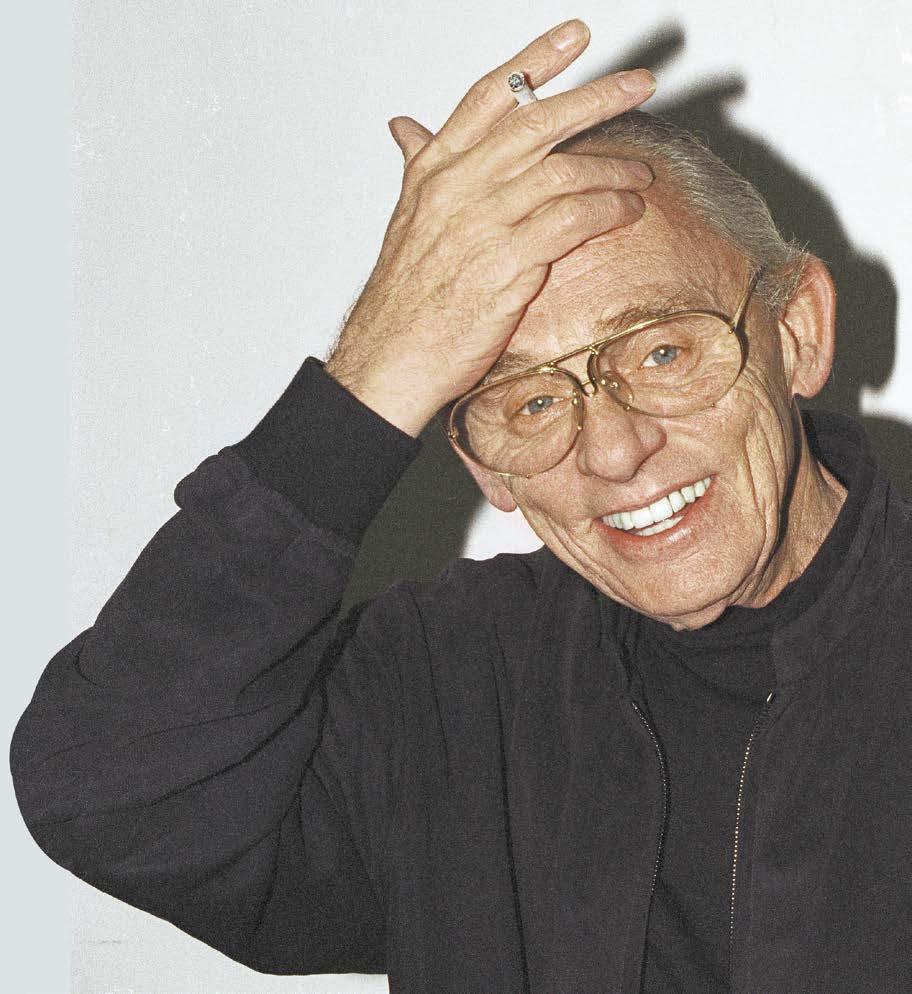
 Gorshin (shown in 2001) compared the Riddler to Shakespeare.
Photo by Kathy Voglesong
Gorshin (shown in 2001) compared the Riddler to Shakespeare.
Photo by Kathy Voglesong
Q: Of course, Stanley Ralph Ross wrote all of that delicious dialogue for the Catwoman, which you ran away with.
NEWMAR: If it hadn’t been for Stanley’s brilliant dialogue — all I had to do was just physicalize the words. When you have gorgeous dialogue like that, all you have to do is get in the right costume and show up.
Q: You make it sound like anyone could’ve done it.
NEWMAR: No, it’s true. There’s a lot of details in that, so that the end result is that everything looks easy. But, yeah, I owe my career to Stanley Ralph Ross (laughs).
Q: But you certainly brought something of yourself into the Catwoman, something that wasn’t in the scripts.
NEWMAR: I’m sure that with the Catwoman, as any role, one offers one’s gifts. If it works, it works. If the part is wrong or the editing or whatever goes into all of our magicmaking, if the other guys didn’t do their jobs, then we all suffer, you see. But I think they all did their jobs on the “Batman.” I give the producer (William Dozier) the top star for that. They prepared the ground for me to dance on. They gave me the clothes to shine in.
Q: The Catwoman costume stood out in a show in which every other actor was swathed in colorful fabric. It looked like someone literally measured every inch of your body.
NEWMAR: It was me. See, I have the secret of making zingy clothes, form-fitting clothes. It’s almost as if licorice was poured over the body, and then they zip you into it. It’s very easy to wear. It’s secret is in the seams. The whole secret is in the seams, and I’m the only one who knows how to do it.
Q: Catwoman was once teamed with the Sandman, played by Michael Rennie, who was so wonderful and mysterious as Klaatu, the Christ-figure space alien in “The Day the Earth Stood Still” (1951). How was it, working with Rennie?
NEWMAR: Oh, my. Yes, that’s right. That was a bizarre sequence. Forgive me for not having a splendid story about him. Stanley probably does. And Stanley didn’t write that show. So, we were kind of ... not working together. We were working shoulder-to-shoulder in that. Stanley wrote five out of the six shows (featuring Newmar), but he didn’t write Michael Rennie’s show. You know, these things happen very fast. And I’m not a big-time socializing actress.
Q: What do you think of the other actresses who’ve followed you in the role of Catwoman, such as Lee Meriwether, Eartha Kitt and Michelle Pfeiffer?
NEWMAR: Personally, Lee Meriwether is a dear and beloved friend of mine. I love her. Eartha Kitt has a far better “purr” than I do, and Michelle Pfeiffer has a far better “meow” than I do. So, I look up to them. Well, not really. They look up to me — but that’s only because I’m 5-foot-11 (laughs).
“It’s almost as if licorice was poured over the body,” said Julie Newmar, shown in 1995, of the customized costume she wore as the Catwoman.
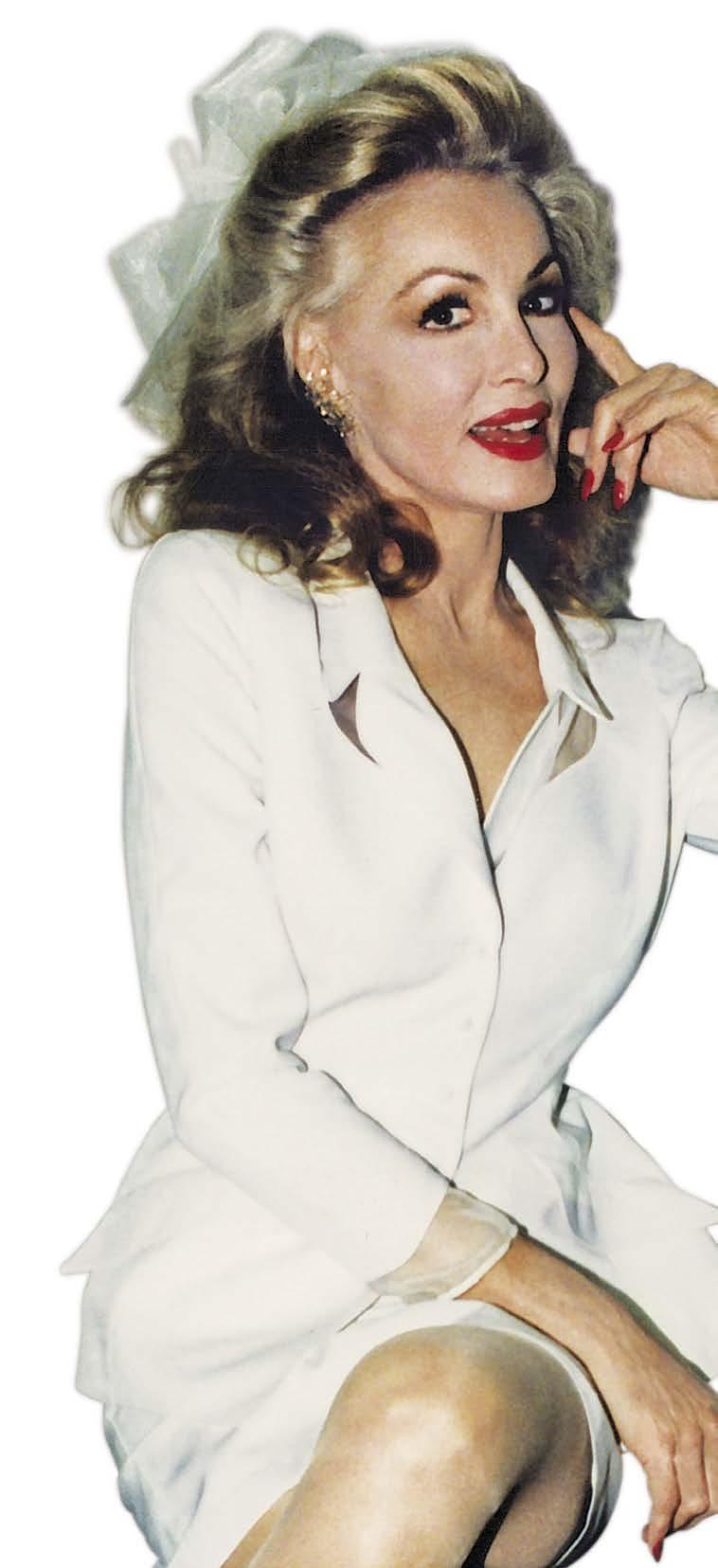
 Photo by Kathy Voglesong
Photo by Kathy Voglesong
Righteous wheels
HE WAS DESIGNING A CAR FROM A COMIC BOOK.
But George Barris, Hollywood’s “King of the Customizers,” didn’t design a comic book car.
“As you know, in the comic book, Bob Kane had an old Zephyr,” Barris (1925-2015) told me during a 1997 interview.
“The bat-face was just cut out of metal and stuck on the front. Of course, this was an artist’s rendition. When they (ABC TV) came to me — this was in 1966 — they said, ‘We want to get a 20th-century Batmobile, something that would be for a crimefighter with the crimefighting equipment of today.’ Immediately I thought, ‘If I’m going to build a Batmobile, I want to incorporate the bat-features into the car, and not have it be just a ‘paste-up.’
“That’s why, when I designed the car, I designed it off the Futura. The original car was a Futura Lincoln-Mercury Ford ‘concept car.’ A concept car is not a production car or a year model. It’s not sold to the public. It’s a concept car like you see at a new car dealers’ show. You see special ‘idea’ cars or futuristic cars.
“Because we had three weeks to build the car, I had to have a basic car that I could work with. That one (the Futura) already had some of the characteristics that I wanted. It had the double basic bubbles. It was only a two-passenger. It was 20 feet long. I could use that to effect the length and the wheel base.”
With the Futura as a suitable “skeleton” for the Batmobile, Barris set about customizing the vehicle.
“Of course, I changed the basic fins around so that I could get the bat-fins,” Barris said. “I took the headlights and made them into bat-ears. I took the scoop and made it into a nose. We had the chain slicer coming out of the nose. The grills on each side, I made out of cavities; they became the mouth.
“In painting the car black, we outlined all of the characteristic lines in a fluorescent reddish-orange, which is a ‘glow’ color, so that it would glow at night. That meant the bat-face and the batfins and the bat-figures would illuminate at night on camera or wherever we had it. That’s the effect we wanted.”
What did the TV folks mean when they said the car should have the “crimefighting equipment of today”?

“At that time, crimefighting implements were squirting out oil so the Joker, who was chasing you, would skid out,” Barris laughed. “Or throw out nails to puncture the Riddler’s tires. Or we had ejector seats, so that they could get out of the car quick in case there was a theft. We had rockets and the chain slicer in the front.”
The Batmobile in 1989. With only three weeks to build the “No. 1 car,” Barris used a Futura Lincoln-Mercury concept car as a “skeleton.”
Photo by Kathy Voglesong
BARRIS, WHO ALSO DESIGNED THE delightfully dilapidated “Beverly Hillbillies” truck, built two Batmobiles in metal and three in fiberglass for the production.
“We always have to make more than one car,” the customizer explained. “Because if you have one car and it gets smashed while you’re filming, you can’t stop the whole production to build another car. That’s another three months. Time is money. You don’t want that.
“So you always want to have a spare car — one or two or three other cars — in case there’s an accident or it stops running.
“We started out with one metal car. In order to make the duplicates, it’s a lot easier to pull a mold off of one car to make the other ones. You can put a fiberglass body together a lot faster and better than trying to do them all out of metal. Since we had two cars that were also going out on tour — which eventually went to three and four cars, of course — it was a lot better and more effective to have those be fiberglass cars. So the No. 1 car was the original, which was built in metal, and the No. 5 car was the stunt car, which was also built in metal.”
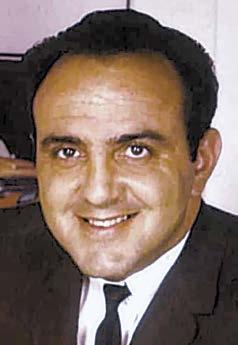
As for the car’s popularity: “The Batmobile has gotten so much recognition through television and movies,” Barris said. “People love it. It just seemed to catch ahold and move forward. (Executive producer) Bill Dozier — with his creativity of making ‘Batman’ into a POW! WHAM! BANG! humorous show — followed the trait of having the Batmobile become an effective part of that show.”
The 1966 Batmobile remained a fan favorite.
“Today, it’s all computers and electronics,” Barris said. “They can do things today that are just unbelievable and fantastic. But the old days of the crimefighting collector pieces still become a favorite of the people, because it was enjoyable. It was not so fancy and way-out that you couldn’t adjust to it. People can’t understand all these high-tech electronics, with buttons and lights and computers.”
If Batman was at all territorial about people driving his car on the TV show, he didn’t enforce it very well. Many other characters, friends and foes alike, got behind the bat-wheel.
These include Robin, Alfred, the Riddler, the Penguin, the Catwoman, King Tut, the Black Widow and the Sandman.
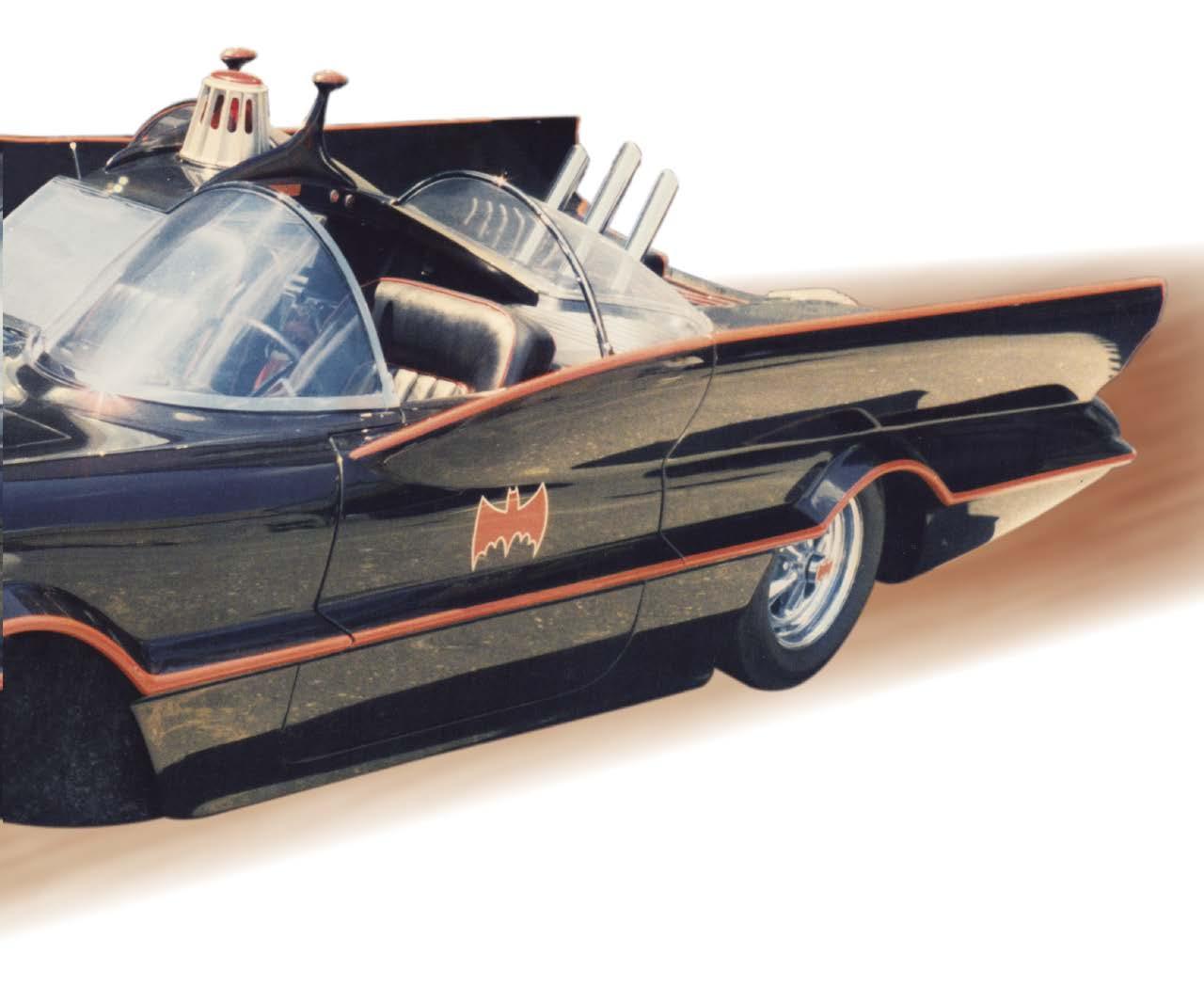
In a (very) weird related development, the Batmobile was sometimes used as a conduit to smuggle characters into the Batcave, often with the use of sleep-inducing “bat gas.” (In this way, the “visitors” wouldn’t realize that the Batcave was located beneath Wayne Manor.) Such interlopers include Commissioner Gordon, Batgirl and various henchladies. In the 1966 movie, the Penguin smuggles a small army of henchman into the Batcave to overtake Batman and Robin. (It’s too bad for Pengy that said henchmen are vaporized on contact.)
Adam West on the Batmobile: “Every time I got in that car — I mean, the car was not poised. It wasn’t set up. The suspension, the drive train, it was so torque-y and off-balance. It wasn’t very stable. And every time I did something in the car, poor Burt (Ward) was hanging on for dear life. George’s cars looked good. That’s all I can say.”
George Barris in the ’60s. Publicity photo
Van Williams The man behind the sting gun
THE LITTLE BOY FROM TEXAS WAS GLUED TO the radio show “The Green Hornet,” never dreaming that one day he would star in the television adaptation.
“I was a big fan of the Green Hornet growing up,” said Fort Worth native Van Williams (1934-2016) when we spoke in 1995. “It was a big show in Texas back in those days. We didn’t have television, so we listened to the radio. There was ‘I Love a Mystery’ and ‘The Green Hornet’ and all those different shows. I really liked the character.”
Not that Williams jumped at the chance when the offer came. He was already a familiar face as a series regu lar on “Surfside 6,” and with one-shot roles on “The Beverly Hillbillies” and “The Dick Van Dyke Show.” But just prior to “The Green Hornet,” Williams was set to star in a World War II drama titled “Pursue and Destroy.”
“It was going to be an A-No. 1, top-notch production,” he said. “They had the show sold. But at the last minute, ABC pulled it. They started pushing me to do ‘Hornet ’
WILLIAMS’ WIFE VICKI wasn’t happy about this push.
“Oh, she was so upset,” Williams said with a laugh. “She said, ‘You’re going to get identified with that part, and nobody’s ever going to want to see you again.’ Which has happened to a lot of people — Superman (George Reeves) and, to a certain extent, Adam (West). He’s had a hard time getting away from Batman. But they offered me decent money and the pressure came down. So I finally didn’t listen to Vicki and I did it.”
“THE GREEN HORNET” WAS NOTED FOR ITS high-tech props, which involved a learning curve.
“We had trouble with all of that stuff,” Williams said.
“We didn’t know what we were doing. A lot of experimenting. The biggest problem was, they came up with the ideas, and then we went into production. But the ideas hadn’t been tested in shooting sequences.
“Like the gas gun. They wanted to see a big cloud of green gas when I fired it, so they rigged me up with an air bottle which I wore underneath my coat.
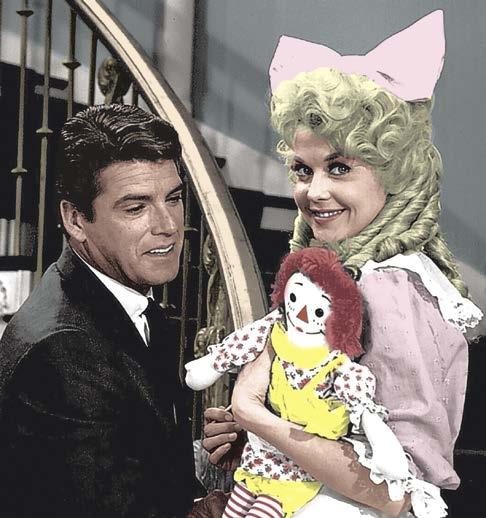
When I pulled the trigger, it had a little can of green talcum powder, and they had their big green cloud.
“It looked good, but of course it would blow all over the place, and then they’d have to stop and clean the camera off and everything else.”
As for the famous sting gun: “Supposedly it had an electronic shock similar to the stun guns they have now,” Williams said.
“I carried that in a special pocket in my overcoat. I’d pull it out; hit a button; it would spring open; I’d point it at something; and they’d lay in a sound effect. Then the door or whatever would explode, or you’d stun somebody.
“Well, it had a real strong spring, because otherwise it would just sag. So one time I took it out, hit the button, and the thing broke and just went right through the wall! They said, ‘Boy, we’re not gonna do that anymore. Somebody’s gonna get speared.’ ”

Williams didn’t regret his decision. “I was proud of the show and what I did in it,” the actor said. “I kind of fought for what I did in it. Because I was going to play it straight and Bruce Lee was going to play it straight. And we did. I think that’s what people appreciate about it.”
So who among the powers-that-be pushed for a lighter approach on “The Green Hornet”?
“It wasn’t really Bill Dozier,” said Williams of the obvious suspect. “It was (Hornet creator) George Trendle, who loaned the rights to the show. Bruce and I went to his penthouse before the show aired. He actually did have all of that stuff. Basically, Britt Reid was modeled after him! He owned a television station and a newspaper there. He was quite old, but his mind was very sharp. But a little later on, he started getting critical that there was no levity in the show.”
Even the production’s most important props — the masks of the Green Hornet and Kato — presented a challenge.
“We could never get it to fit right, so you couldn’t see to do anything in it,” Williams recalled. “Especially Bruce. He just had terrible problems with his mask in the beginning.
“Finally — after the third or fourth show, after so many different masks and trying all these different things — somebody came up with the brilliant idea that we should have a mold made up of our faces, and then they’ll just mold the masks to fit the face molds. Why they didn’t think of that from the very beginning, I’ll never know.
“Once they did that, the thing fit like a glove. It didn’t have to fit tightly. You didn’t have to use wires or elastic to hold it on. It stayed on because it fit so well. The eye holes were big enough so they didn’t stick way out in front, where you were blinded on the sides. You could actually see for a change.”
May (Donna Douglas) in a 1965 episode of “The Beverly Hillbillies.” © CBS Television

ADAM WEST ONCE LOBBIED TO GET MORE
Bruce Wayne into “Batman.” He even made that a contractual certainty for the “Batman” feature film. Did Williams feel there was enough Britt Reid in “The Green Hornet”?
“I never even thought about that, to be honest with you,” he said. “I thought there was plenty of Britt Reid. I actually liked doing the Green Hornet sections of it, because it was action. I’ve always loved action. In every series I ever did, I always liked the fight sequences. That was part of the business I enjoyed, doing stunts. I wanted to do my own stunts.
“It was established from the very beginning that I didn’t know karate, that I didn’t do that jeet kune do. That was Bruce’s bit, and I just fought the conventional way.”
Bennie E. Dobbins was the stunt coordinator on the show.
Recalled Williams: “Bennie would go in and set up the master scene and do the entire stunt, even if it lasted for five or 10 minutes. They’d film it with three or four or five cameras pulled back. Then they would say, ‘Here’s an interesting part. Let’s punch in.’ I would have to match what Benny had done as closely as possible. It worked out really well.”
THE BLACK BEAUTY WAS A GORGEOUS CAR, without question. But you wouldn’t call it a smooth ride.
“They’d decided they didn’t want a ‘comic’ car,” Williams said. “But when it was first built, we had a lot of trouble with it. They lowered the car to make it look more menacing. Then, we would wreck it. All of that stuff on the Black Beauty was one-of-a-kind. The wheels were magnesium wheels; they were one-of-a-kind. When we would hit a chuck-hole during a chase scene, the thing would just bend or shatter, and they’d have to go and get a mold and make the things again.
“So they decided: ‘We just can’t keep using this car because, boy, if we do something wrong and none of this stuff works, we’re in real trouble.’ They ended up making two backup cars. They weren’t practical. On the outside, they just looked like the original car that was practical. So they got to be real treasured items. They were put in storage so nobody could get near ’em, so nothing would happen to ’em.”
WILLIAMS WAS MYSTIFIED WHEN HE LEARNED that the Green Hornet and Kato would guest-star on two “Batman” episodes broadcast in March 1967.
He recalled: “Bruce and I, neither one of us could figure out how in the world they were going to make this thing believable. Because we played this thing straight, while they played it campy and the whole bit. How is this going to work?
“Of course, Bruce really hit the roof, because in the original script, he got into a fight with Robin and lost! Oh, man, he just walked off the stage and he walked off the lot. He was just irate. So they finally made it to where we got into this fight with Batman and Robin, and it came out a draw. I guess they wanted to show the stunts and show Bruce’s stuff.
“People have titled that ‘The Crossover.’ Everybody calls it ‘The Crossover.’ I guess it worked for them. It didn’t for us. We had to get totally out of character. Britt Reid was making fun of Bruce Wayne and he was making fun of me. I dunno. They wanted to try to pick up some of ‘Batman’s’ audience for ‘Green Hornet,’ but the shows weren’t that similar. It was a totally different thing. People watched their show for comedy and our show for seriousness. We were kind of the James Bond-type of deal.”
Brit Reid himself, Van Williams, in 1995.
Photo by Kathy Voglesong
Monsters, beware !
HE’S
AN ALIEN WHO PROTECTS THE PEOPLE OF Earth (like Superman). He wears a shiny suit with built-in gizmos devised for power allocation and battle (like Iron Man). He shares his existence with a mortal man who, when threatened, employs a talisman in order to take superhero form (like Thor).
He is Ultraman. If you’re a giant monster, you’d best beware.
“Ultraman” (1966-67) is a sublimely bizarre live-action Japanese TV series produced by master monstermaker Eiji Tsuburaya who, it should come as no surprise, did the FX for Japan’s Godzilla movie exports. For American children who watched the show (often in syndication in afterschool timeslots), “Ultraman” provided a daily dose of kaiju — that is, giant monsters.
Setup: The Science Special Search Party is a fivemember team whose mission is to “investigate strange incidents and anomalies, and protect Earth from any invasion from space.” They are heroic Hayata (Susumu Kurobe), communications officer Fuji (Hiroko Sakurai), team leader Muramatsu (Akiji Kobayashi), and wingmen Arashi (Sandayu Dokumamushi) and Ide (Masanari Nihei). They are often joined by pint-sized SSSP wanna-be Hoshino (Akihide Tsuzawae).
The group travels in high-tech vehicles; wields rayguns; and wears buttocks-defining orange polyester uniforms festooned with fancy buttons and black piping.
Where does Ultraman come in? In Episode 1, he is a visitor from Nebula M78 who inadvertently causes the death of Hayata. To restore his life, the alien fuses their existences. From then on, Hayata can transform into the giant alien using a Beta Capsule, a device that resembles a marital aid. But Hayata conceals his double life. (You’d think the sharp-eyed SSSP gang would notice that Hayata always shows up the minute Ultraman flies away.)
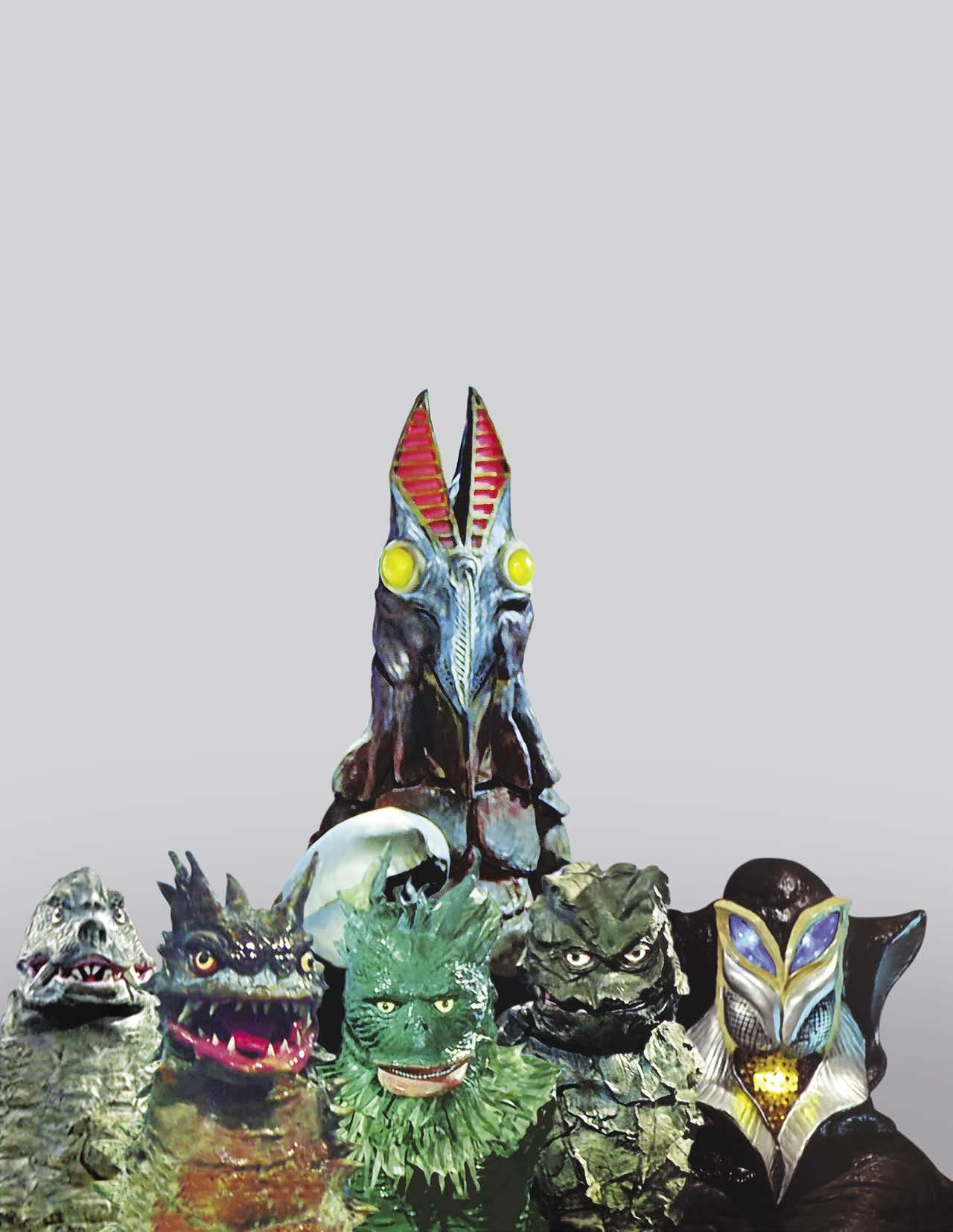
When not in Hayata mode, Ultraman was played by actor Bin Fururya, who appeared as an alien in Tsuburaya’s previous series, “Ultra Q” (1966). Fururya must be lauded for fighting rubber monsters amid miniatures and pyro with limited visibility. The actor was a judoka (judo practitioner) who often evoked judo and karate with his moves and poses in action as Ultraman.
THE PLOTS OF THE SERIES’ 39 EPISODES USUALLY followed the same formula: Monster shows up; monster wreaks havoc; monster is defeated by Ultraman. As with Tsuburaya’s many monster movies, the series cleverly employs the use of intricately fashioned miniatures (detailed buildings, wooded terrains, tiny tanks with moving guns). Also employed are optical superimposition and real-deal fire, explosions and water. It appears that the production secured the cooperation of refineries, construction sites, cement workers, radio towers and, in one instance, even a ski resort. For a children’s show, the fights can sometimes be a bit on the bloody side. Each episode is like a mini-movie.
“Ultraman” has a groovy theme song, even if children sing it. Some on-the-nose lyrics: “The mark on his chest is a meteor / in his favorite jet he strikes his enemies / here he comes, our Ultraman ...”
Stand-out episodes: “Ultra Operation No. 1” (Episode 1) presents the origin story in which Hayata is killed when his aircraft collides with a mysterious red sphere. Ultraman combines their life essences; Hayata can again be Hayata or, when the occasion demands, Ultraman. The big silver-and-red guy’s first opponent is the scaly, long-tailed Bemular.
In “The Blue Stone of Baradhi” (Episode 7), the SSSP travels to Turkey, where they discover an ancient civilization called the Baradhi that worships Ultraman. (They have a big Ultraman statue and everything.) Ultraman defends the Baradhi against Antlar, a giant monster with, in case you haven’t guessed, giant antlers.

In “Terrifying Cosmic Rays” (Episode 15), a child’s twodimensional drawing of a monster becomes the actual threedimensional monster Gavadon. (He’s not really a bad monster.) Didn’t Rod Serling do the same story in “Night Gallery”?
In “The Forbidden Worlds” (Episode 33), Fuji herself becomes a giant monster thanks to invading alien Mefilas. It’s kind of cool seeing Fuji (instead of a hideous monster) tearing apart intricate miniature buildings. The SSSP are aghast. “Have you lost your human heart?” Miramastu yells to his super-sized colleague.
In “Farewell, Ultraman” (Episode 39), the final installment of the series, Ultraman loses his battle with the horned green monster Gomora due to a technicality: precious seconds run out on his three-minute power timer. It’s up to Hayata — a human with no Spacium Beam, no Slash Beam, no Ultra Attack Beam — to rid Earth of this monstrous threat. The episode becomes a tear-jerker.
Says a narrator at the show’s close: “He defeated violent monsters and fought invaders from space. Now the day has finally come for our Ultraman to return to the land of light. Surely, Ultraman is praying that this Earth will be filled with peace and light. Ultraman, thank you. Ultraman, farewell.”

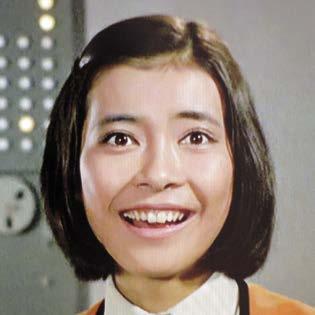

TSUBURAYA (1901-1970) WAS A SPECIAL EFFECTS director who co-created Godzilla. During World War II, he directed the effects for a re-creation of the attack on Pearl Harbor in the Japanese propaganda film “The War at Sea: From Hawaii to Malaya” (1942). Wrote Tsuburaya biographer August Ragone: “The American Occupation forces mistook Tsuburaya’s surprisingly realistic footage for the genuine article, and some of it actually ended up in documentaries about Pearl Harbor.”
After the war, Tsuburaya directed the effects for “Godzilla” (1954) — a film often called a metaphor for the bombings of Hiroshima and Nagasaki — followed by such kaiju classics as “Godzilla Raids Again” (1955), “Rodan” (1956), “Mothra” (1961), “King Kong vs. Godzilla” (1962), “Ghidora, the Three Headed Monster” (1964) and “Destroy All Monsters” (1968).
It should be noted that Sakurai was a TV trailblazer. Playing a female officer in a time of rampant sexism, Sakurai’s Fuji preceded Nichelle Nichols’ “Star Trek” character Uhura. (“Star Trek” premiered 60 days after the debut “Ultraman” broadcast.)
Fuji and Uhura are both communications officers fighting alien threats. Coincidence? Or sci-fi synchronicity?
Above: Ultraman zaps ’em! Insets: Hayata (Susumu Kurobe), Fuji (Hiroko Sakurai), and Hoshino (Akihide Tsuzawae).
81
Opposite: Monsters of every threat level. © Tsuburaya Productions

AT LEAST “THE ADDAMS FAMILY” AND “THE Munsters” premiered on different nights. Two tepid sitcoms concocted to cash in on the superhero craze premiered on the same evening, Jan. 9, 1967 — “Mr. Terrific” at 8 on CBS, “Captain Nice” at 8:30 on NBC. Oddly, both series were about dweeby guys who ingest a foreign substance that temporarily imbues them with super strength and flight. Just as oddly, both were mid-season replacements that, by May, were cancelled. (Cue “Twilight Zone” music here.)
In “Mr. Terrific,” Stephen Strimpell starred as Stanley Beamish, an unassuming mechanic enlisted by the Bureau of Secret Projects to swallow a “power pill” that makes him super for one hour. (Hmmm. DC Comics’ Justice Society of America had a member named Mr. Terrific. And another member, Hourman, took a pill that made him super for one hour. Was this actionable?) When Stanley flies, he flaps his arms like a bird, just in case you forgot this is a comedy.
Stanley’s government contact was played by John McGiver — from “The Manchurian Candidate” to this.
“CAPTAIN NICE” SEEMED TO HAVE A LEG UP on its competitor, as it was created by Buck Henry, who earlier co-created the 007 parody “Get Smart.” Henry’s premise has police chemist and “mama’s boy” Carter Nash (William Daniels) discovering a serum that turns him into a superhero. Here’s the “funny” part: He can fly, but he’s afraid of heights. He has superpowers, but he’s a klutz. You get the idea.
Carter’s love interest Candy, a sergeant at the precinct, was played by Ann Prentiss. His overbearing mother was Alice Ghostley. Character favorite Byron Foulger played Carter’s dad (though you didn’t see his face). Joe Flynn and Bob Newhart had guest roles.
The same year, Daniels and Henry were in Mike Nichols’ counterculture comedy “The Graduate,” which Henry co-wrote.
For lasting only a half season, “Nice” generated a decent number of collectibles. (Chalk it up to the TV superhero craze.) There was a paperback from Tempo; a comic book from Dell; and a promo poster illustrated by Jack Kirby, no less. There is evidence that Topps put out “Captain Nice” trading cards (black-and-white photos, color mini-comics by Wally Wood), but I didn’t see any in 1967.
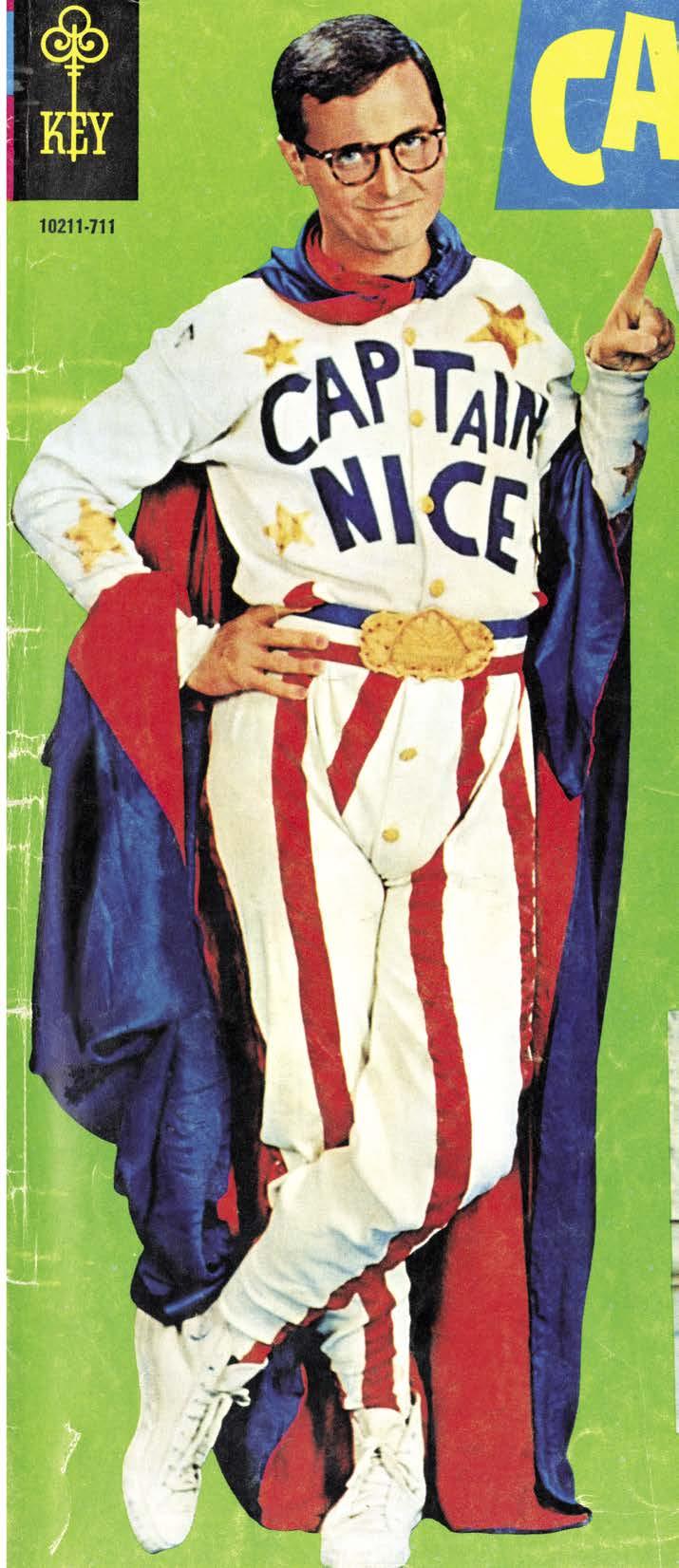
“Mr. Terrific” and “Captain Nice” debuted back-to-back on the same night, but different networks. © Universal Television; © NBC Television

Ron Ely
A HANDSOME GUY WITH KILLER ABS IN A loincloth on
TV — how could he not be a sex symbol?
Ron Ely, who starred in NBC’s 1966-68 adventure series “Tarzan,” hadn’t really pondered the question.
“I never thought of myself as representing a sex symbol,” said the Texas native (born 1938) when we spoke in 2012.
“I didn’t see anything attractive in what I was doing or the way I was presented. I just saw it as natural and normal to the complexity of the stories — never beyond that.”
Ely was an actor on the rise, but not yet a star, at the time he was cast by NBC to star as Edgar Rice Burroughs’ iconic jungle hero who debuted in a pulp fiction magazine in 1912.
“It’s fairly interesting, in the sense that it all happened very fast,” the actor recalled. “I’d been home to my mother’s house in Texas. I returned on a Sunday night and I got word that my agent wanted to talk to me about a meeting on a Monday. It was a meeting for ‘Tarzan.’ I was resistant to the idea. I said, ‘That could be a career killer.’ ”
But Ely’s agent was encouraged by the network’s involvement, and talked his client into the meeting as a courtesy.
“As it evolved,” Ely said, “before I knew it, I became interested. They asked if they could shoot some film of me, and I said OK. I went on film on Tuesday; on Wednesday, they chose me; and on Friday, I was on a plane to Rio de Janeiro! I remember wondering at the time: How in world did I get to the point where I’m going to Brazil to do a character I’m not really that keen on?
“However, when I got into the stories and the character, and I really came to terms with doing it, the character became very potent to me. There was a lot to that character that I hadn’t thought of before. I was stoked.”
THE ACTOR DID MOST OF HIS OWN STUNTS.
“There were so many things to deal with — water, fire, animals, flying — which was basically trapeze work, which I’d never done before,” Ely said. “I learned on the job. I would think, ‘This is what (Tarzan) would have gone through.’ I always kept that in mind. I tried to move with grace. Because I felt that, at this juncture in his life, he would have been graceful with his movements. It should never appear difficult or hard to do. If he took on a lion, then — yeah, sure, he’s taking on a lion. Naturally, he’s doing that because he knows how to do that. So the viewer isn’t distracted from the story.”
Still, some of the stunts were perilous and even injurious.
“It seemed as if on every on show, something would happen,” he said. “We dealt with fire a couple times, which was very, very hairy. Water is always tricky. There are currents under there, and you don’t know where they might take you; they could take you two or three miles downstream. By the time you come up, you’re way down.
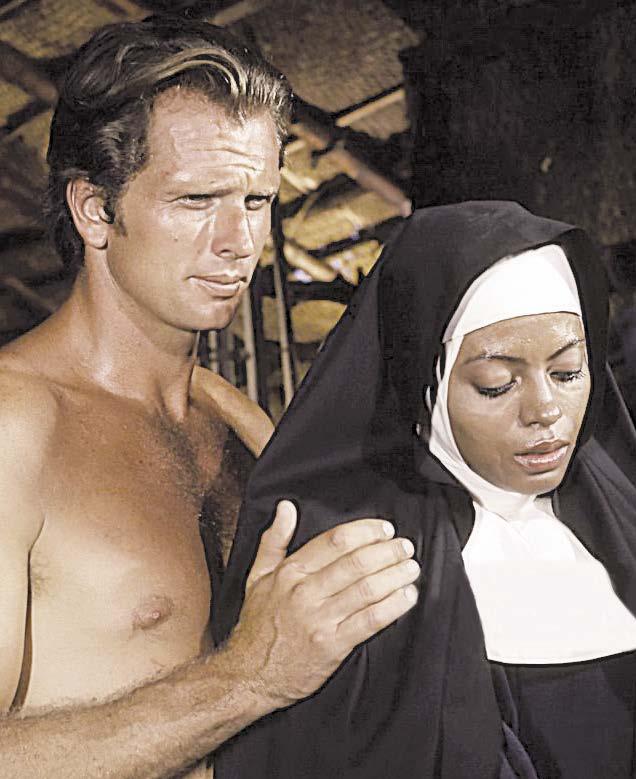
“I remember one time, the Brazilians were saying, ‘No! No! You shouldn’t be down there! There are piranhas there!’
“On the main, it was always teetering on something that could go wrong, that could go bad. Sometimes it did, but sometimes I got lucky and got through it OK.”
In one instance, a real-life injury sustained during shooting was written into an episode, on the fly.
Ely recalled: “It may not sound extreme to have something like a ruptured muscle in the leg that inhibits movement. But you can’t shut down the production. So you simply write in a character in a bush with a blowgun who hits you with a dart that causes you to limp for that episode, and explains the black bruising on your leg.”
As for non-human cast members: “Sure,” Ely said, “lions, tigers, leopards, elephants, all the animals. Animals are unpredictable and dangerous. That’s something you come to terms with early on, and put it to bed and not think about it.”
One such co-star was Cheetah, the chimpanzee with whom Ely shared much screen time. Were they friends off-screen?
“Definitely friends,” Ely said with a laugh.
“It was a wonderful companion. It used to be that any time we had a little bit of time to rest, I’d sit in a chair, and the chimpanzee would sit right there by me, because he wanted to be by me. The relationship was one that over three years, I watched the chimpanzee grow closer to me all the time. By the end of the series, I mean, we were probably closer than maybe a pet would be. I think it was because of the ability to communicate at a high level; I think chimpanzees can communicate at the level of a 3-year-old child. But our friendship was priceless. Wonderful.”
Ely with singer Diana Ross as a nun on “Tarzan.” The actor worried he might become typecast in the role.
© Banner Productions
Titans of the ’toons
It was the comic books come to life. And that ain’t hyperbole.
Grantray-Lawrence Animation’s series “Marvel Super Heroes” debuted in syndication on Sept. 5, 1966, a period during which superheroes could do no wrong — something the series put to the test. This was limited animation at its most limited. Actual Marvel page art was Xeroxed (then a new technology). Camera tricks such as zoom-ins were employed to give the illusion of movement. But lest we forget: This was artwork by Jack Kirby, Don Heck, Gene Colan, Bill Everett — guys whose illustrations had movement.
The series’ roster of heroes comprised Captain America, the Sub-Mariner, the Hulk, Thor and Iron Man. But the shorts also introduced deeper-cut Marvel characters (to mainstream viewers, at least) such as the Avengers, the X-Men and many villains.
When I brought up the series to Marvel Comics legend Stan Lee during a 1992 interview, I found myself being serenaded. Lee warbled the first line from the show’s opening theme song: “He’s a sulky, over bulky, kind of hulky superhero ...”
I told Lee that, believe it or not, I felt the 1966 cartoon series was the most successful attempt to capture Marvel on film up to that time. (The so-called “Marvel Curse” was still a thing in 1992, and Lee had been disappointed in Marvel’s filmic progress up to that point. Boy, would things change over the next 10 years.)
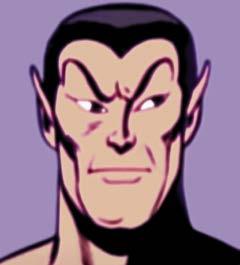
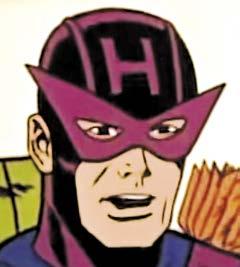
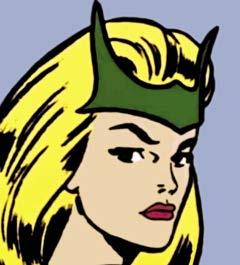


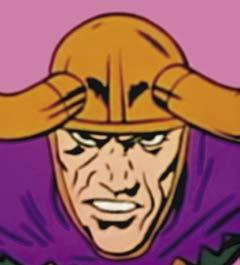
How was it arranged that the actual Marvel Comics page art would be used? “I don’t remember too clearly,” Lee said.
“The two guys who did it, I believe, were (animators) Bob Lawrence and Steve Krantz. They were both interested in preserving the real feeling the Marvel characters had, and I worked with them. While the animation was rather limited at that time, they made a concerted effort to keep them as close to the stories in the Marvel comic books and as close to the artwork as possible.
“Unfortunately, all of the other animation we did, or most of it, was all done for networks. And networks are notorious for changing things and editing things, telling you how they want to do it.
“You’re quite right. Of everything that’s been done, those primitive little cartoons were the closest to our own style.”
There are two reasons for this. One is that, although the shorts presented solo adventures by the six heroes, there were occasional unbilled appearances by characters from surrounding Marveldom. The Captain America segment “The Return of Captain America” is like reading an issue of The Avengers. The Sub-Mariner segment “Dr. Doom’s Day” is like reading The Uncanny X-Men.
The second reason? The small matter of actual comic book art being “animated.” It looked great. But was it fair and equitable?

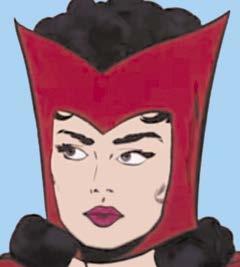



© Marvel Comics Inc.;
© Grantray-Lawrence Animation

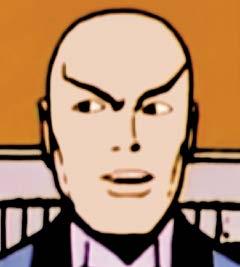
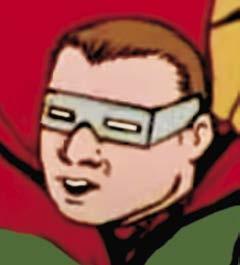
ANIMATION
TV’s “Marvel Super Heroes” had super cheezy animation and recycled artwork, but it introduced deepcut Marvel characters to the mainstream.
ON THE DC SIDE
IN THE REALM OF
ANIMATION,
the big news of Fall 1966 was “The New Adventures of Superman,” which dropped five days after “The Marvel Super Heroes” over the ABC network. (Events were unfolding fast and furiously.)
The animators, Filmation Associates, made their bones on the Superman series. Their amusing origin story is ironic, given that “truth” was one of the things Superman stood for (the others being “justice” and “the American way”). In order to land the Superman account, Filmation employed, shall we say, creative subterfuge.
The company was on the verge of closing its doors when out of the blue, a call came in from DC Comics editor Mort Weisinger about a possible Superman animated series. DC wanted to send another of its editors, Whitney Ellsworth, to “see the studio.”
Filmation co-founder Lou Scheimer recounted his reaction in his memoir written with Andy Mangels, “Lou Scheimer: Creating the Filmation Generation” (2012, TwoMorrows Publishing).
Said Scheimer: “What studio? There’s me, there’s Hal (Sutherland, another co-founder) and 24 desks!”
But Filmation needed the work, and put out a clarion call.
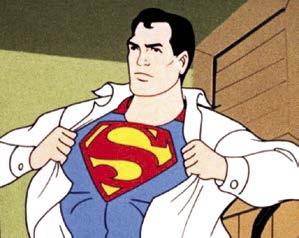


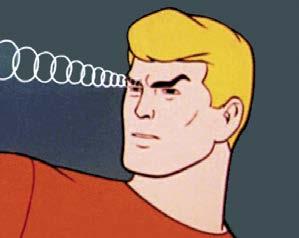
To fool Ellsworth into believing that Filmation was a thriving, bustling concern, Scheimer “started calling friends in the animation business,” wrote Mangels. “Anyone who could reasonably fill a seat behind one of the animation desks for the day was fair game.”
The gambit worked, and Filmation was back in business.
Nostalgia alert: Superman was voiced by Bud Collyer who, a generation earlier, likewise voiced the character for radio.
So much grew out of “The New Adventures of Superman.”
Filmation continued exploring the DC Universe with “The Superman /Aquaman Hour of Adventure” (1967-68) and “The Batman/ Superman Hour” (1968-69). In the latter, Batman was voiced by Olan Soule, who played a news anchor in a 1966 King Tut episode of the live-action “Batman.” (Holy coincidence!)
Superman was animated previously, in theatrical shorts by the Fleischers and Famous Studios (1941-43). Filmation’s Batman cartoons would have been the first time the character was animated, if not for the novel opening credits of the live-action show. But there’s no room for debate regarding Aquaman, nor several of his compatriots in the DCU. This was their debutante ball.
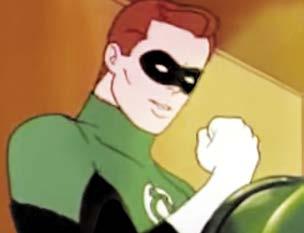


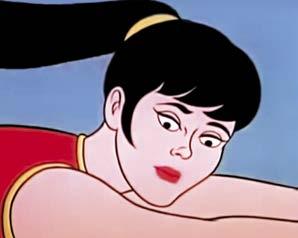

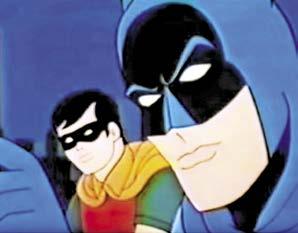

88
Superman rescued Filmation in 1965. They returned the favor by spotlighting his DCU pals. © DC Comics Inc.; © Filmation Associates

Saturday-morning-friendly supercharacters filled air time.
But Space Ghost was different.
Despite having a masked monkey for a sidekick and some inherently goofy villains, Hanna-Barbera’s “Space Ghost” (initially broadcast 1966-68) played it straight, more or less.
Space Ghost has often been called, in elevator-pitch fashion, “Batman in space.” He certainly looks as cool as Batman.
Much credit for this goes to Alexander “Alex” Toth (19282006), a comic book artist with a resumé dating back to the 1940s. Toth pulled a mid-career switch beginning in 1960 by honing a specialty in character design and storyboarding for animation.
Drawing on his extensive background in superhero comics — Toth had drawn Green Lantern, Flash, and the Justice Society of America during the Golden Age of Comics —he created sleek animation designs that were instantly classic. Toth rendered Space Ghost as a mysterious figure in a black hood (with white eyes), a gold cape, white tights and red armbands.
The character’s founding voice artist was Gary Owens, remembered as the announcer on the very ’60s TV comedy “Laugh-In.” Space Ghost patrolled outer space in his rocket plane, the Phantom Cruiser, accompanied by teenage cohorts Jan (voiced by Ginny Tyler of Disney fame) and Jace (Tim Matheson of “Animal House” fame), plus Blip the monkey (Don Messick, the voice of Scooby Doo). In keeping with the All Things Superhero policies of 1966, each of these characters was masked. Even Blip. The group communicated via radios in their chest emblems. Largely thanks to those versatile armbands, Space Ghost could activate a force field; emit powerful energy and hypno rays; attain invisibility; and fly through space with no apparent air helmet.
BATMAN VS. SPACE GHOST MISSION
Fights injustice from the dark corners of Gotham City
Started out in comic books, wound up on television
Fights injustice from the dark corners of outer space
COSTUME TRAJECTORY
Dark cowl with white eyes, cape, tights, gloves, boots
Started out on television, wound up in comic books
Dark cowl with white eyes, cape, tights, gloves, boots
SIDEKICK(S)
Masked teenager Robin
Masked teenagers Jan and Jace
ANIMAL PAL
Ace the Bat-hound (a masked dog) Blip (a masked monkey)
Guest villains were voiced by Ted Cassidy (Lurch on “The Addams Family”); Keye Luke (Kato in the Green Hornet serials); Alan Reed (the voice of Fred Flintstone); and Vic Perrin (the kinda creepy announcer on “The Outer Limits”).
But was Space Ghost a ghost? Important details like Space Ghost’s origin story were left to subsequent iterations to fill in, and liberties were taken. In 1994, Space Ghost was reintroduced as a talk show host in the Cartoon Network’s droll sendup “Space Ghost: Coast to Coast.” The roster of live-action guests was, to say the least, eclectic. Guests included Bjork, Willie Nelson, the Bee Gees, the Ramones, Jim Carrey, George Clinton, Ice-T, Carol Channing, David Byrne, Kevin Smith, Charlton Heston, Timothy Leary, and — in yet another full-circle moment — Adam West.
90
“Space Ghost” © Hanna-Barbera Productions

Crimef ighters for kiddies
Hanna-Barbera always found an angle, a way to exploit a popular trend. When the TV superhero craze hit in the middle 1960s, the animators got to work whipping up a raft of kid-friendly supercharacters for its Saturday morning schedule. In the two-fer “Frankenstein Jr. and the Impossibles,” scientist’s son Buzz Conroy enlists the titular giant robot (an invention of his father’s) to save mankind from various colorful threats. Franky Jr. was voiced by Ted Cassidy, as ever rockin’ the basso profundo tones of that harpsichord-playing, Frankensteinian butler.
Hanna-Barbera kiddie heroes, from above: 1966 Impossibles ad, Secret Squirrel, Buzz, Frankenstein Jr., Atom Ant, and Superstone.
© Hanna-Barbera Productions
The Impossibles were a rock band and a superteam. Watch out, villains, here comes Coil-Man (he bounces), Fluid-Man (he splashes people), and Multi-Man (he multiplies himself). Yep, that’s one limited slate of superpowers. Tiny Atom Ant’s super strength fools many an adversary. Showmate Secret Squirrel is a 007 sendup. Hanna-Barbera’s flagship “The Flintstones” presented Fred Flintstone as Superstone, his Superman-like alter ego and the “champion of fairplay, honor and justice” in Season 5. Not even Fred’s pal Barney Rubble knew his secret.
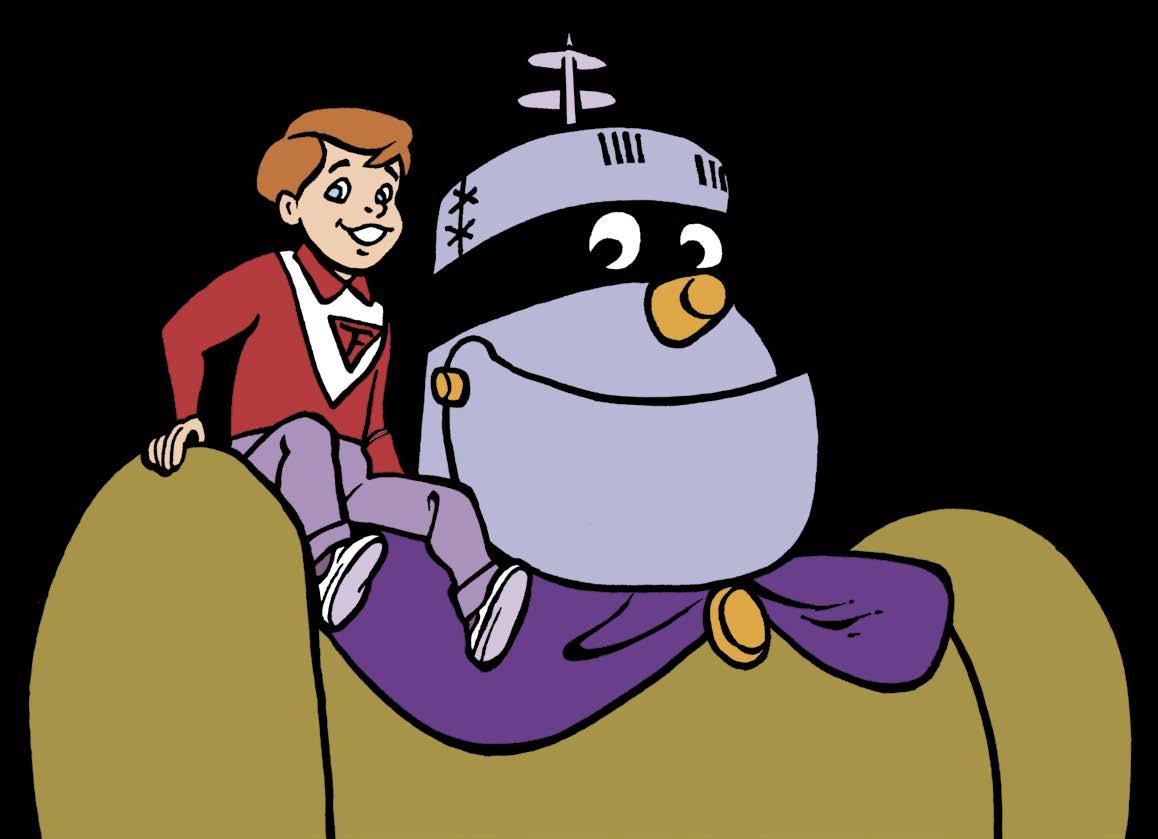
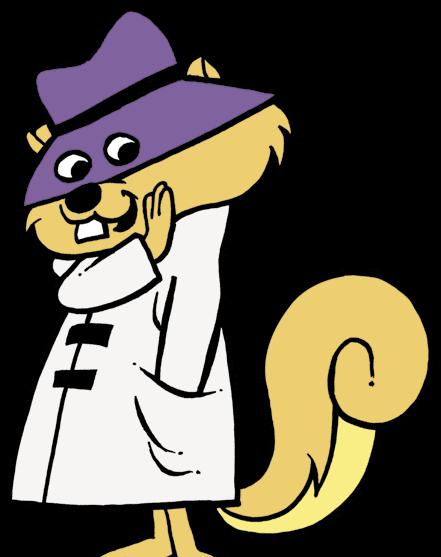

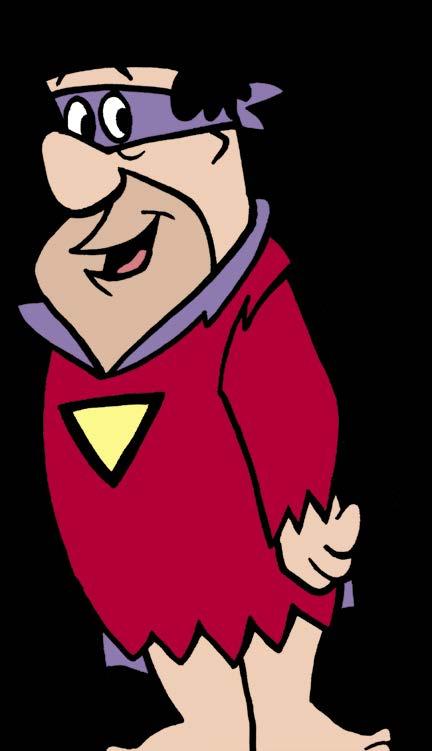
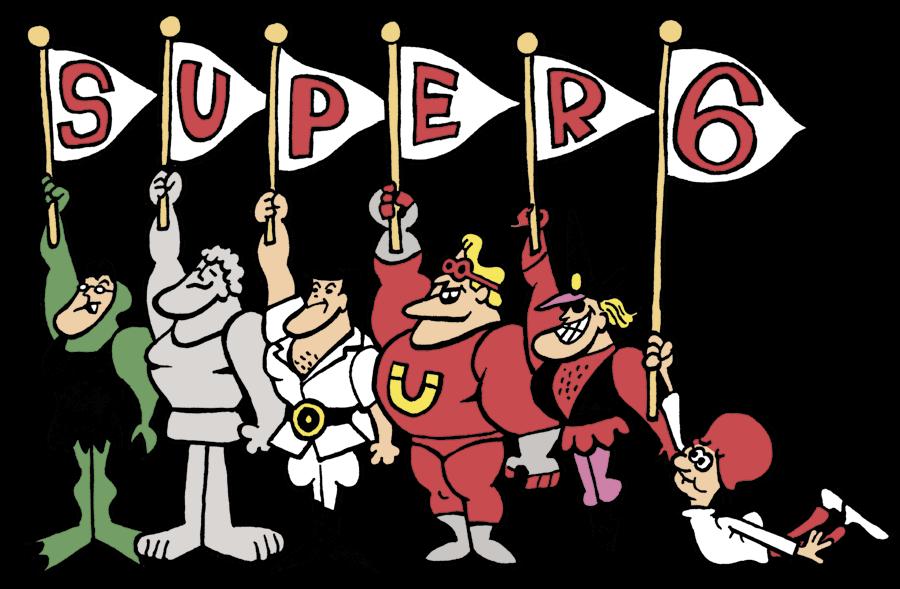
Critter power
“Funny animal” superheroes scurried across TV screens as early as 1955, with CBS’ Saturday morning show “Mighty Mouse Playhouse.” MM’s 1960s descendants included, from left below, Underdog (voiced by Wally Cox); Super Chicken (a co-star of George of the Jungle); Minute Mouse and Courageous Cat (sendups of Robin and Batman co-created by, whaddaya know, Bob Kane); Batfink (who sent up the live-action “Batman” and “The Green Hornet”); and Fearless Fly (who created buzz on “Milton the Monster”).
Bwoing?
Simultaneously silly and clever, DePatie-Freleng’s “The Super 6” (196669) followed the misadventures of six heroes for hire who operate out of Super Service headquarters. They are, from left: Super Scuba, Granite Man, Elevator Man, Magneto Man, Captain Zammo (originally Captain Wammo, until the toy company Wham-O complained); and Super Bwoing (the group’s guitar-strumming apprentice). The theme song was performed by Gary Lewis (son of Jerry) and the Playboys, the pop group behind the #1 hit “This Diamond Ring.” Another cartoon superteam was Terrytoon’s “The Mighty Heroes” (1967-68), which included Cuckoo Man, Tornado Man, Diaper Man ... you get the idea.
Creator Ralph Bakshi later directed the X-rated animated films “Fritz the Cat” (1972) and “Heavy Traffic” (1973).
Artwork © DePatie-Freling Enterprises
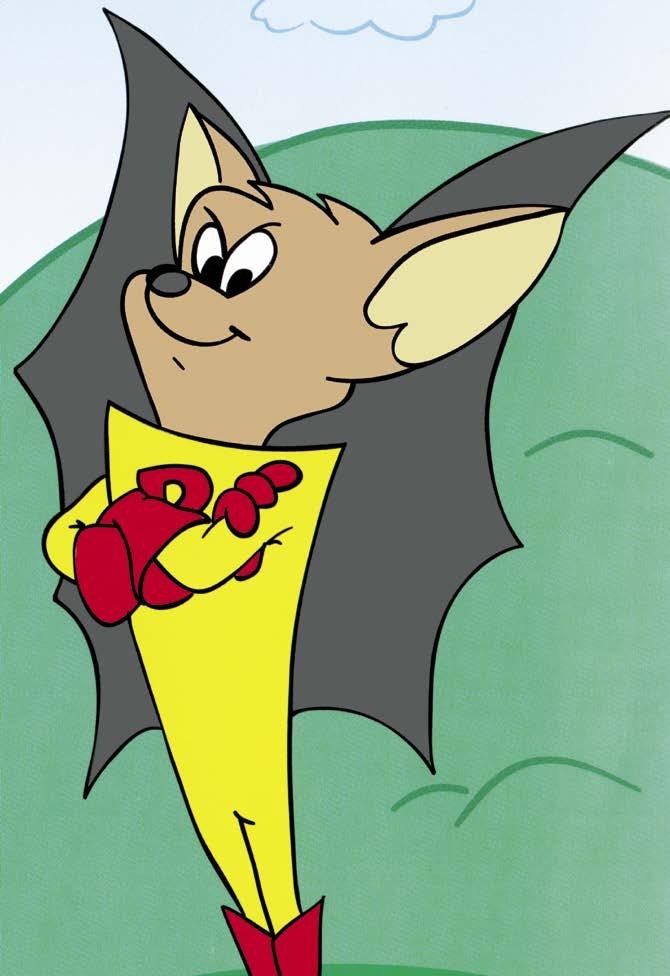

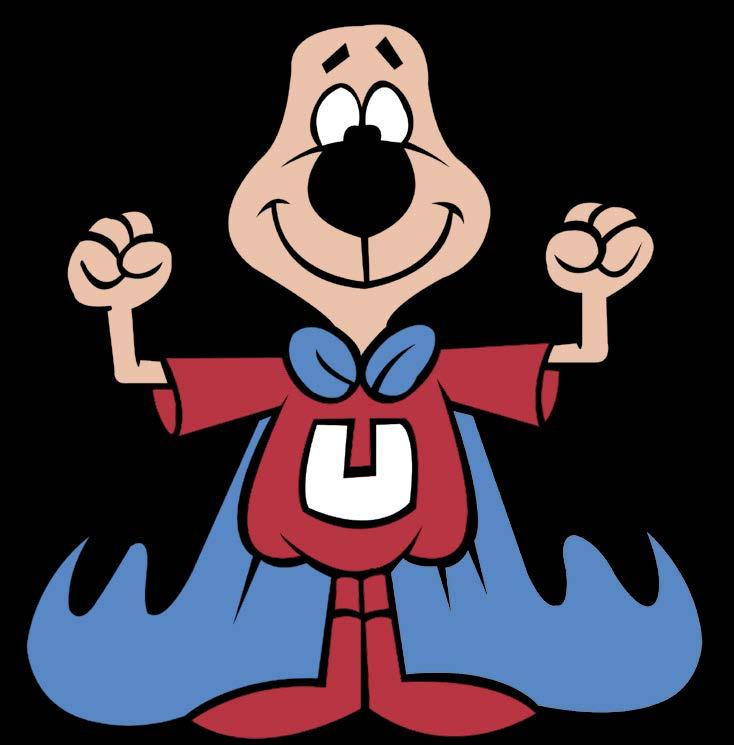
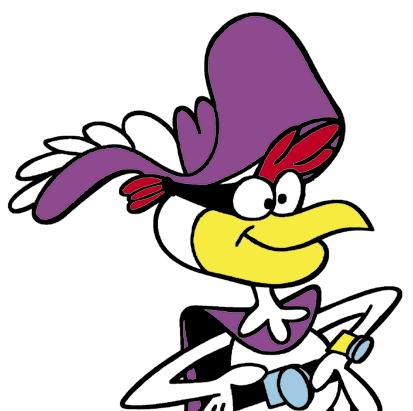


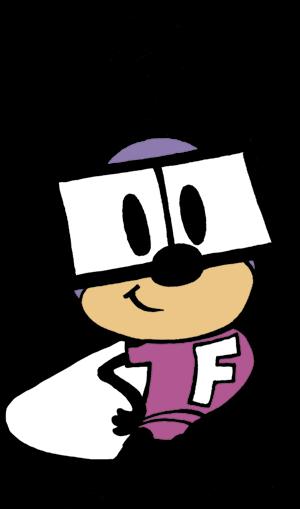 Underdog © Total Television; Super Chicken © Jay Ward Prod.; Courageous Cat and Minute Mouse © Trans-Artists Productions; Batfink and Fearless Fly © Hal Seeger Productions
Underdog © Total Television; Super Chicken © Jay Ward Prod.; Courageous Cat and Minute Mouse © Trans-Artists Productions; Batfink and Fearless Fly © Hal Seeger Productions
Super
From manga — Japanese comic books that are read from back to front — came (1952-68)
The comic was adapted by Japan’s Fuji TV as an animated series (1963-66) whose title translates to “Mighty Atom.” The series was immediately exported to American TV as trace of
builds Astro Boy as a replacement for his son. The
“You’ve always told me that you love me as though

Boy?) Aston dies in a car crash in the far-off, futuristic a self-driving car.) Aston’s


“dad”: “Flesh and blood? Why, that’s a joke, son!” The scientist sells Astro to a traveling robot circus, robot with bull-like horns, for an exhibition fight. In the audience is Dr. Elephan of the Institute of Science, who reclaims Astro Boy, calling him “a masterpiece of
A sample theme lyric from the American dub (as sung by children for maximum child-friendliness) is “Crowds will cheer you / You’re a hero /
Rise of an industry
A dry run for the deluge of TV-hero-themed memorabilia happened during the 1950s.
Well, it couldn’t have happened in the 1930s (with the Great Depression and all), nor the 1940s (with World War II and all).
After all of that scrimping, saving and sacrificing came the era of “post-war optimism.” The advance of television had been put on hold during those trying times. But in the nifty 1950s, as bulky TV sets entered more and more households, television grew into a cultural force.
Children were glued to the sets to watch their favorite shows such as “The Howdy Doody Show,” “The Lone Ranger,” “The Roy Rogers Show,” “Hopalong Cassidy,” “The Adventures of Superman” and sci-fi programs like “Tom Corbett, Space Cadet” and “Captain Video and His Video Rangers.” Fess Parker, who starred in Walt Disney’s miniseries “Davy Crockett, King of the Wild Frontier,” got to be as big as the Beatles — at least, to the munchkins.
“I first got a clue to the enormity of it when I was sent out on tour,” Parker told me in 1995. “There were massive crowds. I shook hands with 3,000 children a day in the department stores where I was placed.
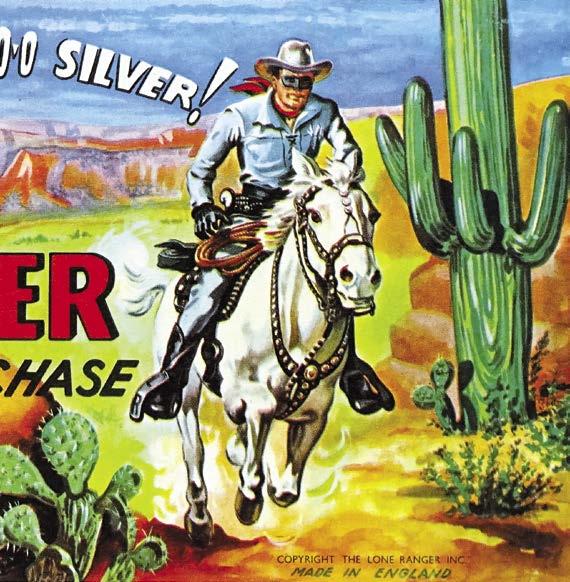
“I was appearing in different venues, all of which were just completely unique. I’d never dreamed that I would be asked to speak at the Rotary, or have dinner with this person or that person, from breakfast until it was time to go to bed, and then on to the next city. It was almost overwhelming, but I got through it.”
Television — moving pictures and sound in real time — became the ultimate marketing tool. Perhaps the most ubiquitous TV tie-in product of the ’50s was the coonskin cap popularized by Parker.
Artist Howard Bender, a “Crockett” fan who grew up in the decade of Elvis and hula hoops, believed Disney was using his Sunday night TV show to hype Disneyland, which opened in 1955.
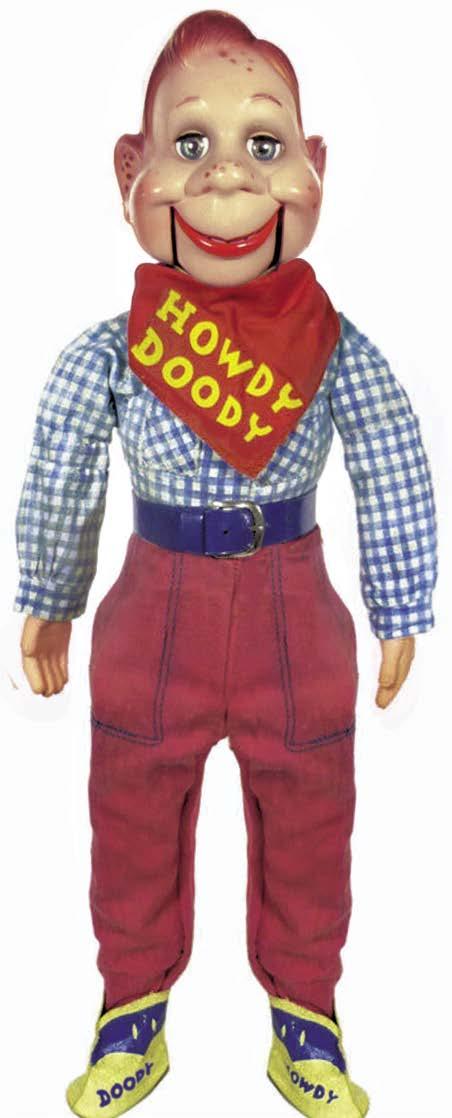
“He’d have Frontierland, and then he’d do a TV show about that,” Bender told me in 2023.
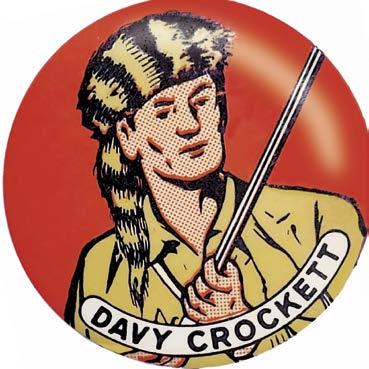
“Disney decided to do Davy Crockett who, unfortunately for him, was a real person; he couldn’t be copyrighted. This gave anyone license to put Davy Crockett on any product. That’s why the craze was so huge. But you could always tell the Disney stuff by Fess Parker’s face.”
The selling power of
“Howdy Doody” was noted in a mailing to potential commercial partners bearing the slogan “Meet Howdy Doody, the super-popular salesman on strings.” A chilling sentence from that mailing: “It is even conceivable that your TV-tutored 2-year-old clearly enunciated ‘Howdy Doody’ before learning to say ‘Mommy’ or ‘Daddy.’ ” Scorch!
IT’S NO COINCIDENCE THAT SO MANY kiddie shows of the period were western-themed. The venerable, old-timey genre still ruled kids’ entertainment, until the anything-goes 1960s came along and everything went kablooey.
So when the TV “Batman” skyrocketed in the ratings with its Jan. 1966 premiere, the merchandising magnates were ready to pounce. They had systems in place. They had formats from lunch boxes to puppets to games to dolls to models to masks. They knew the ins and outs of licensing.
No pun intended, but after everything they’d learned during the reign of Davy Crockett, Howdy Doody and the Lone Ranger — well, this was not their first rodeo.
Television grew into a cultural force during the nifty 1950s. Shown: Items based on the TV properties “The Lone Ranger,” “Howdy Doody” and “Davy Crockett.”
COLLECTIBLES
© The Wrather Corp.; © NBC Television; © Ideal Toy Co.; © Current copyright holder

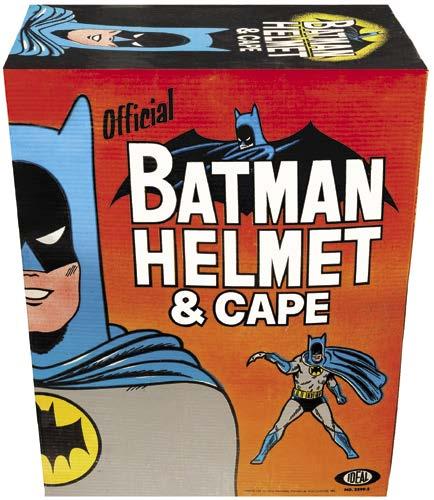

Mask up! Don’t just watch TV and read
books — become your
be sure to look
ways before crossing the street, kids.) Ad © F.W. Woolworth Co.; characters © DC Comics Inc., © Zorro Productions Inc., © The Green Hornet Inc.; helmet box photo courtesy of Heritage Auctions
comic
favorite superhero! Above: The Woolworth’s chain heralded Ben Cooper’s glut of superhero costumes. Left: Ideal’s hard plastic Batman helmet covered the entire head. (But
both

Superhero adjacent
You didn’t need to be born on Krypton or Asgard or Paradise Island, nor be injected with “super soldier” serum, to cash in on the TV superhero craze triggered by Batmania in the 1960s.
Some non-superhero characters partook of fringe benefits from the trend, like Tarzan, the Lone Ranger, Tonto, Zorro, Flash Gordon and Dick Tracy.
Many such characters predated superheroes, having sprung forth from old-media formats like radio, pulp fiction magazines and the newspaper funnies.
Like their superhero counterparts, they cross-pollinated in other media. (Dick Tracy alone headlined a newspaper strip, a radio show, a movie serial, a liveaction TV series, an animated TV series, feature films, and one muthaload of merch.)
Prior to ’66, the country had never witnessed so concentrated a wave of superhero-themed merchandise. Manufacturers — largely old-timers who didn’t necessarily grasp the finer points of the genre — lumped these “superhero adjacent” characters in with the Real Thing. After all, many adjacent characters also wore colorful costumes. Some even wore masks. So ...
The word “TV” was often emphasized in packaging. Left: Ideal mixes it up. From below left: Puppets of Zorro, Tonto and Dick Tracy.
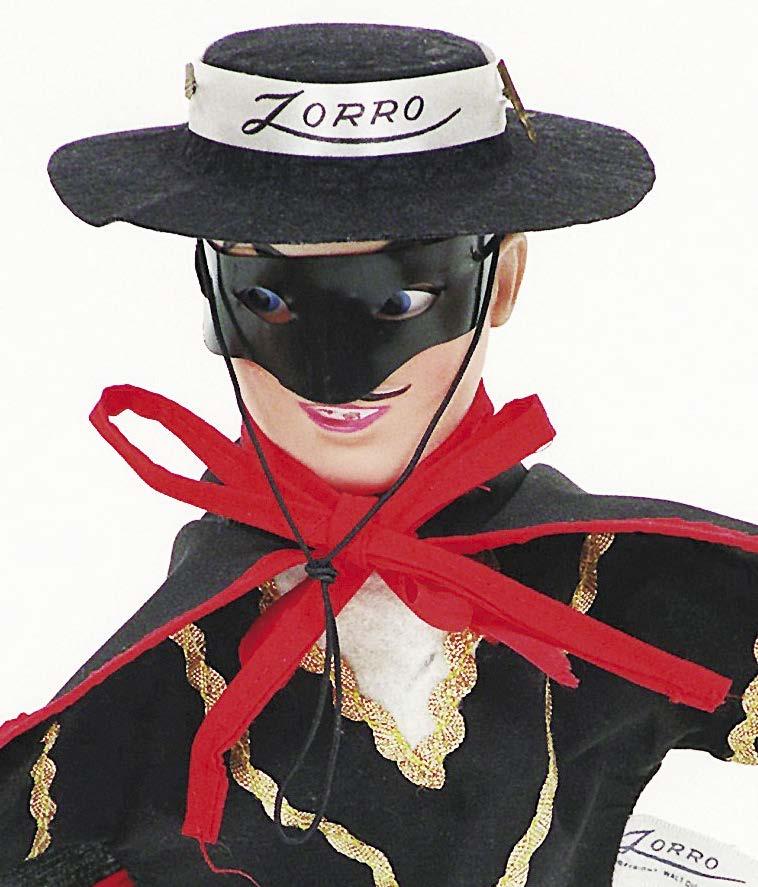
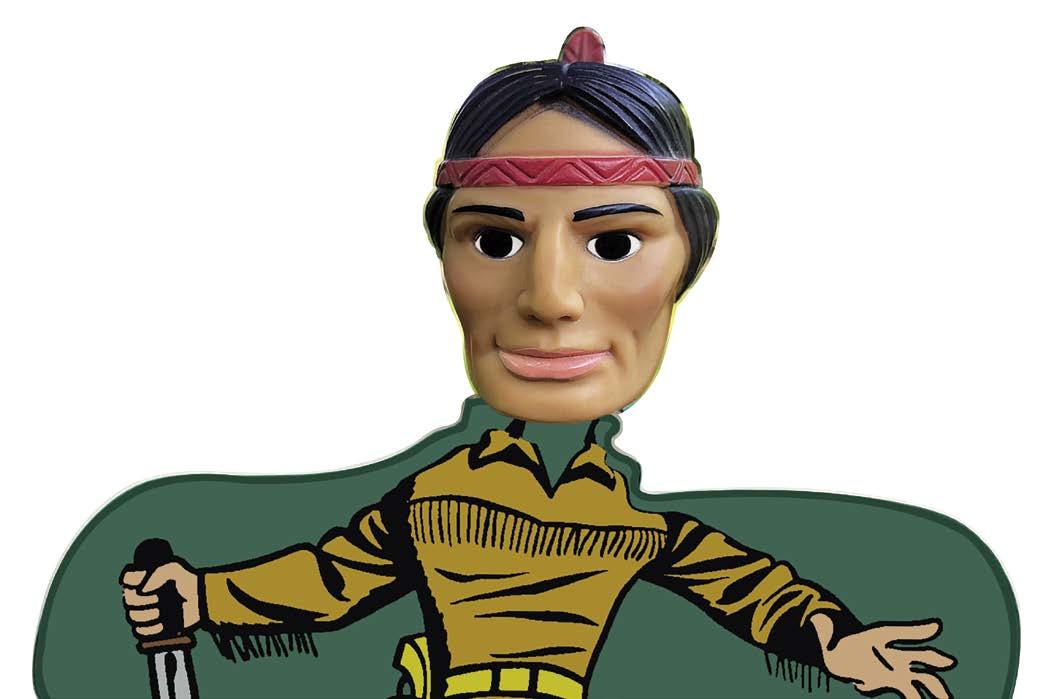


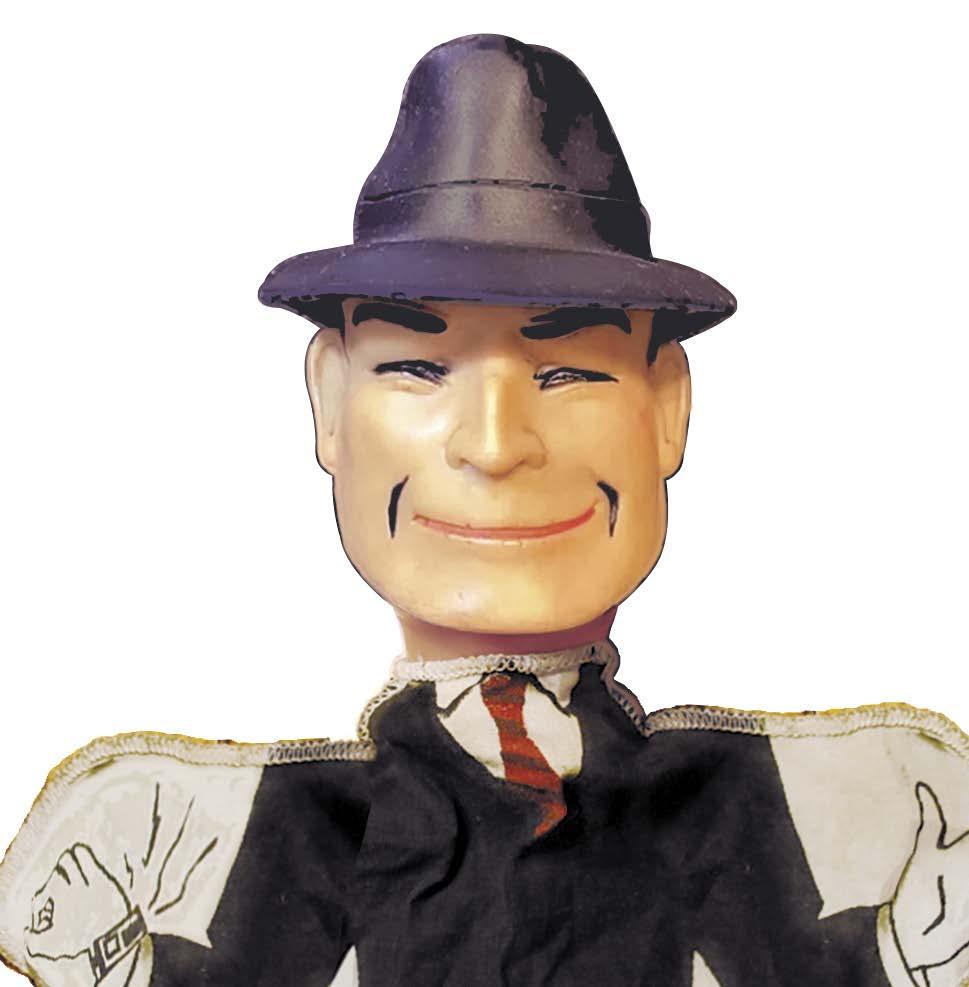
© Ideal Toy Corporation; © Wrather Corporation; © King Features Syndicate. Other copyrights are noted on the Ideal TV Favorites hand puppet box.

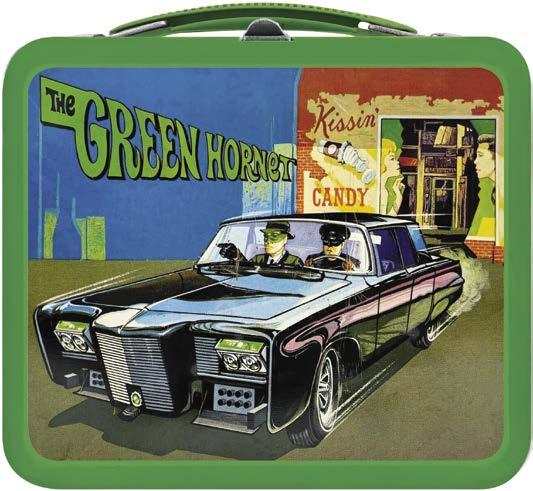
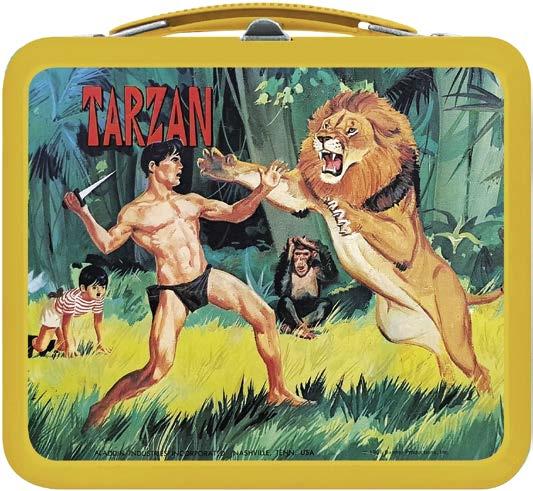
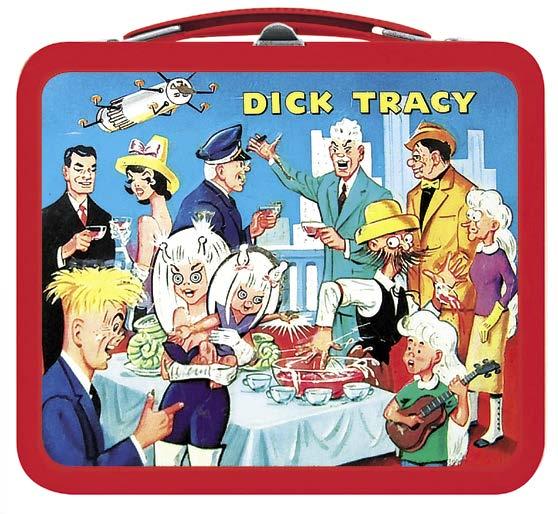


Aladdin lunch boxes presented feats of derring do by, from top, Dick Tracy, the Green Hornet and Kato, and Tarzan. Opposite: You didn’t have to be a politician to have your likeness on a button. DC and Marvel characters get “pinned.”
boxes © Aladdin Industries; characters © Chicago Tribune Syndicate; © The Green Hornet Inc.; © Banner Productions; © DC Comics Inc.; © Marvel Comics Inc. 102
Lunch

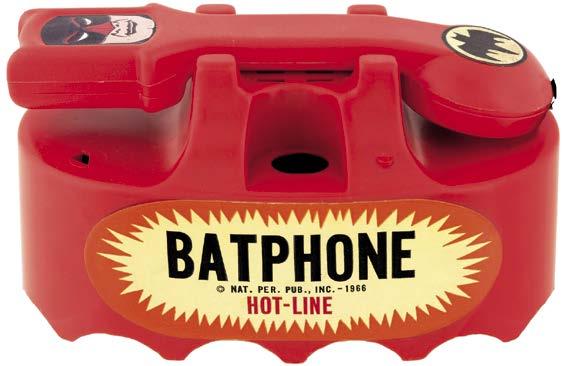


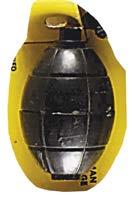


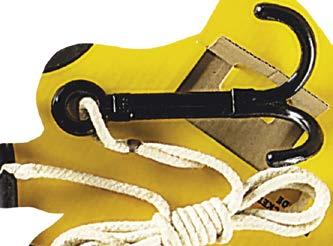
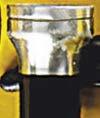

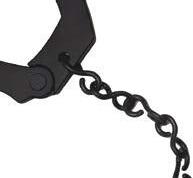
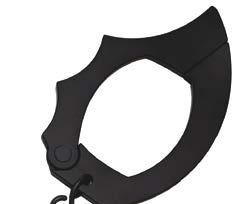
106
Batman knockoffs

Ever hear of Super Bat or Batichica? A Batman knockoff side hustle thrived during Batmania. From above left: Argentina’s Batichica; a “jiggler” from 1973; a sad
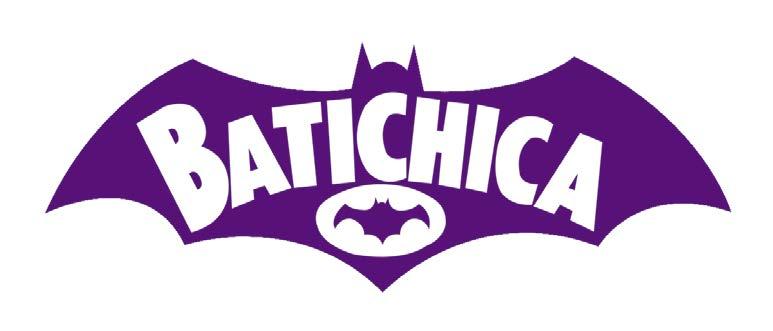
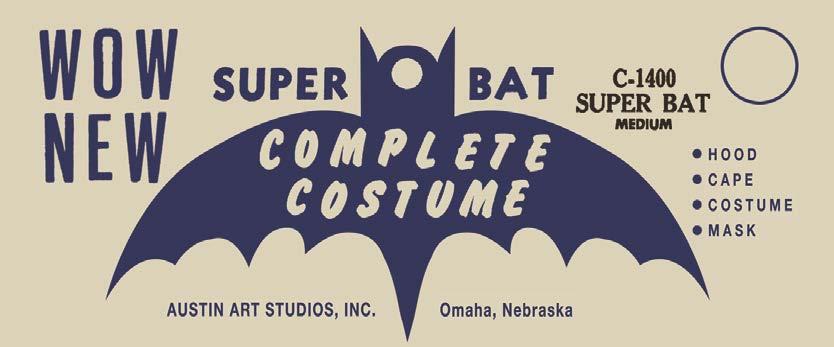
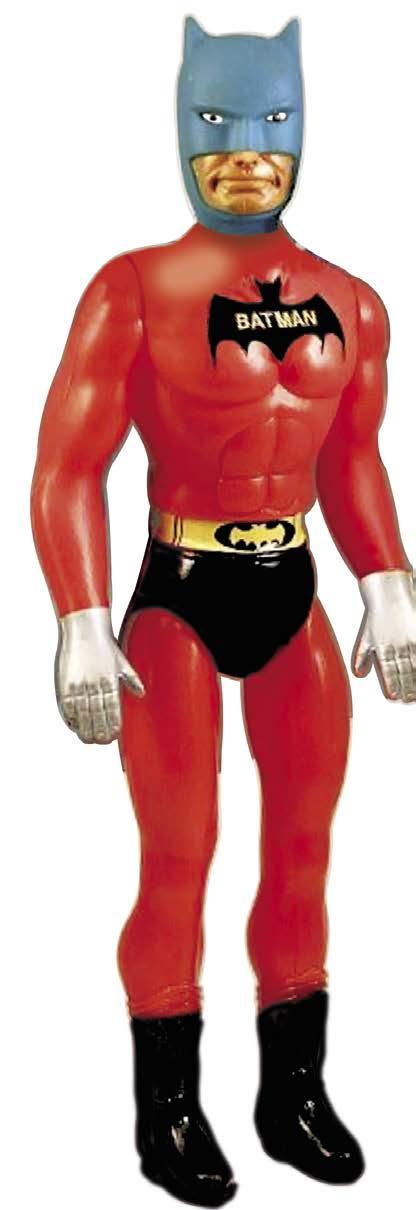

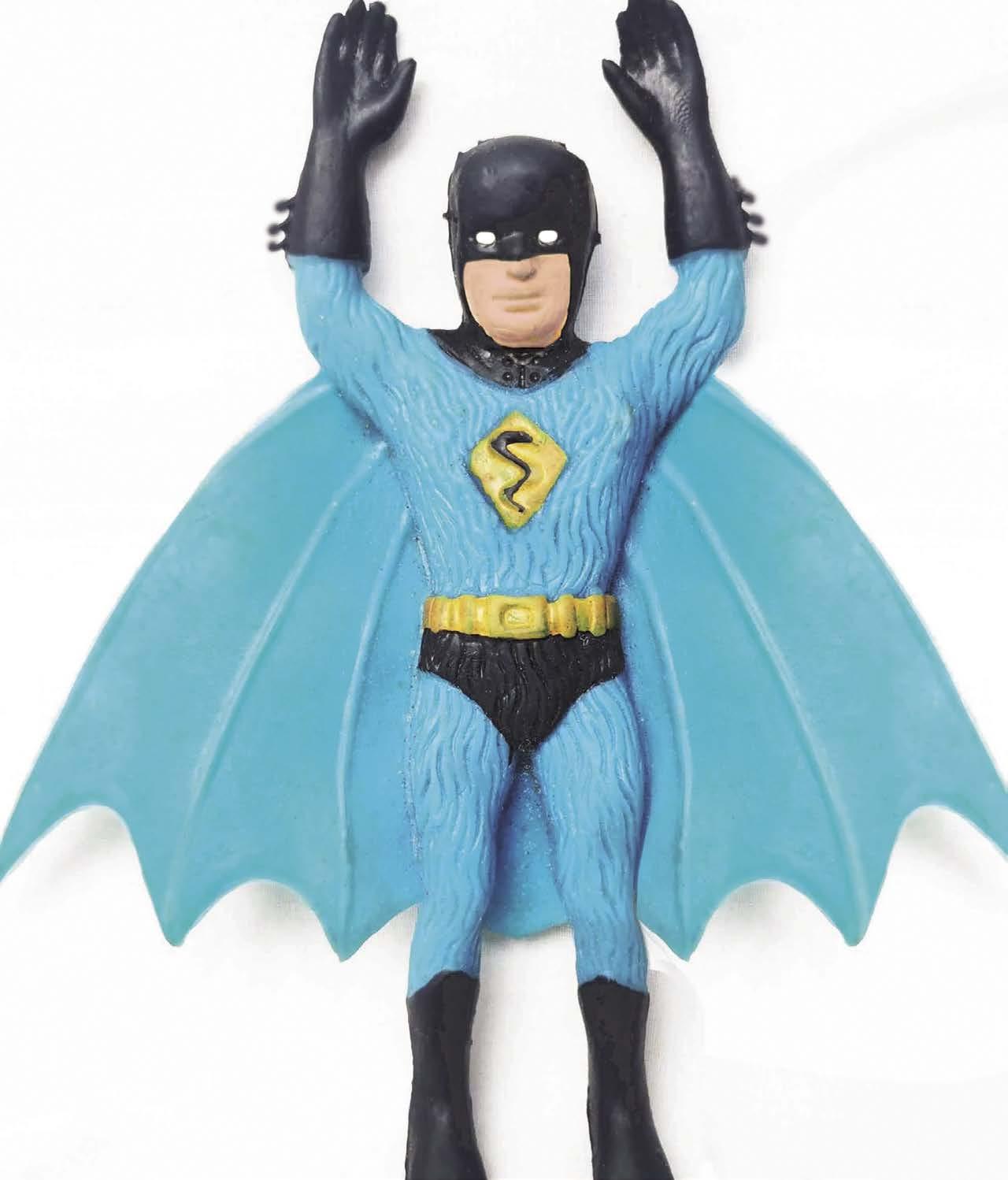 guy in red leotards with oven
guy in red leotards with oven

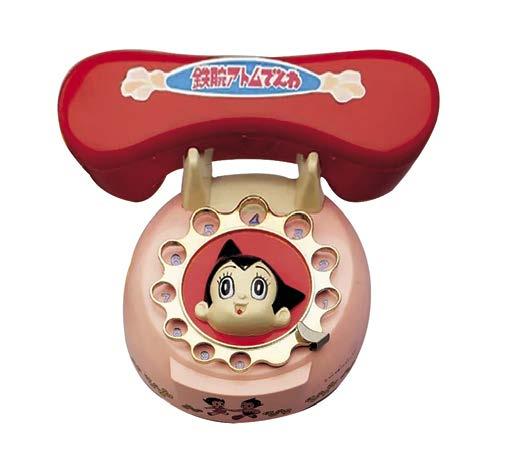

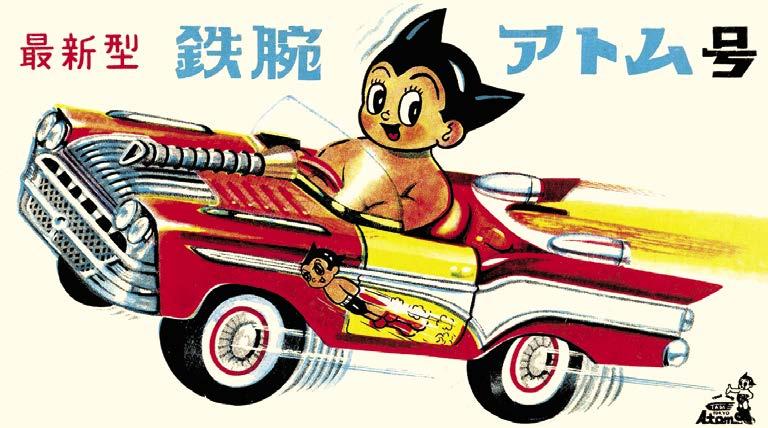

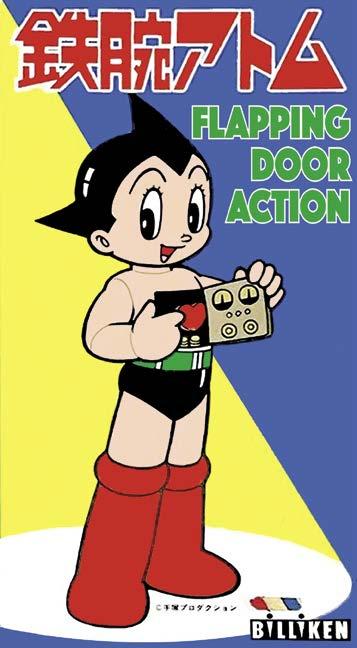 Astro Boy stuff was adorable! But most of it never made it to the States. From top left: “Flapping Door Action” toy; pinball game; telephone; car box art; toy box art; gun. Astro Boy © Fuji TV; toy © Billiken; otherwise © respective copyright holders
Astro Boy stuff was adorable! But most of it never made it to the States. From top left: “Flapping Door Action” toy; pinball game; telephone; car box art; toy box art; gun. Astro Boy © Fuji TV; toy © Billiken; otherwise © respective copyright holders

Turning Japanese

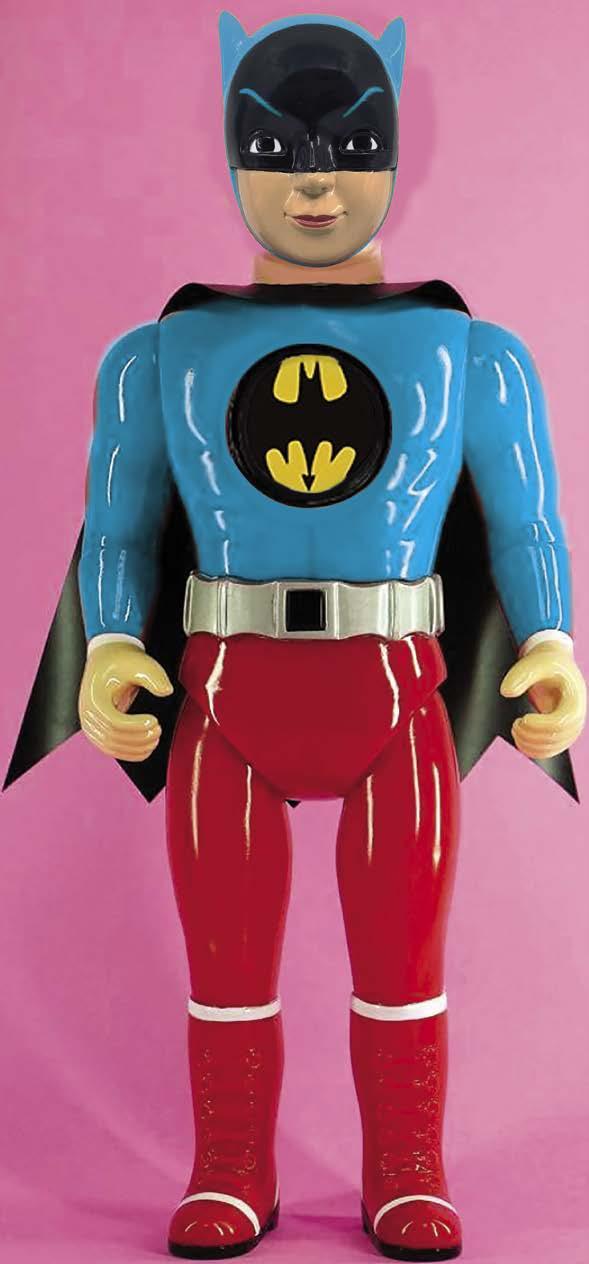




Alter nate bat-verse

Wheel cool


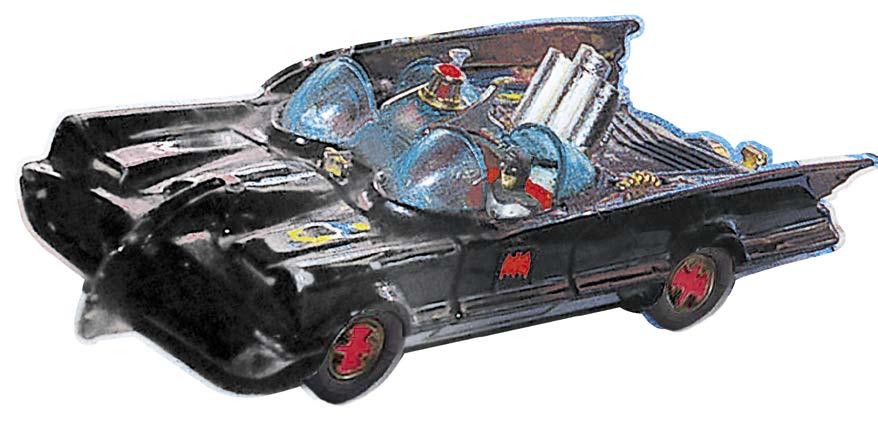



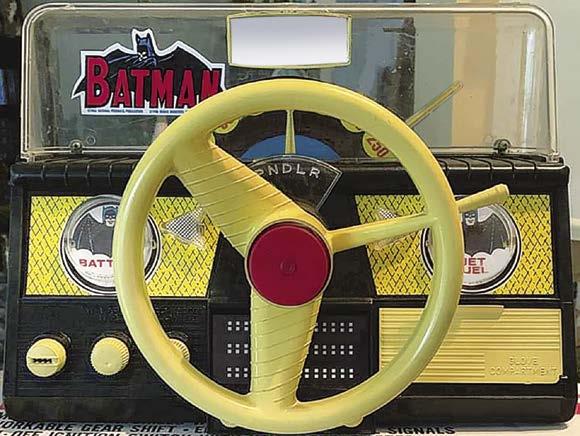

110
The Green Hornet takes aim from the back seat of Corgi’s Black Beauty.
Turbines to speed! Remco put youngsters in the driver’s seats with Batmobile (left) and Black Beauty toy dashboards. © Remco; © Warner Bros.; © DC Comics Inc.; © The Green Hornet Inc.
Did Corgi’s Batmobile top their 007 Aston Martin for coolest toy car of the ’60s? It came with Batman and Robin figures, and shot “rockets” from the back — just like on TV
© Corgi; © Greenway Productions; © DC Comics Inc.
© Corgi; © The Green Hornet Inc.
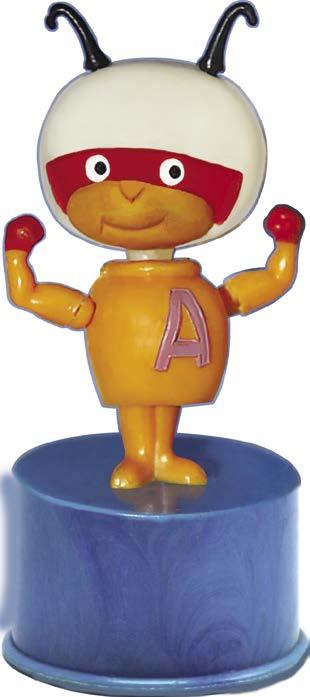


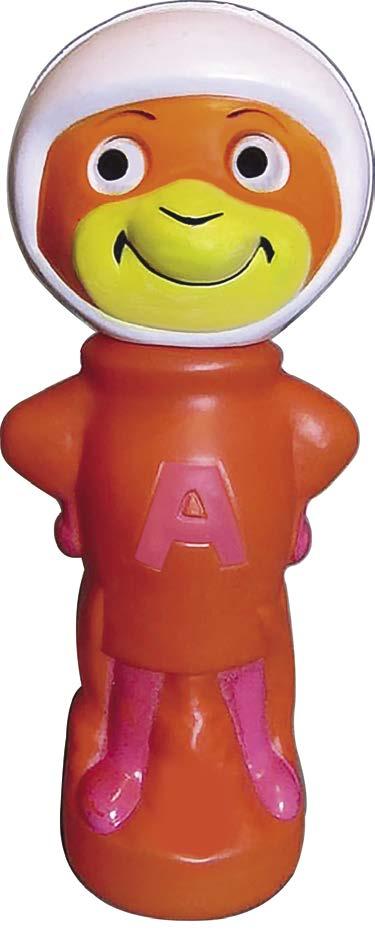

115
Hanna-Barbera kiddie hero stuff, from left: Atom Ant push-button toy; Frankenstein Jr. coloring book; Atom Ant Soaky bubble bath toy. © Kohner; © Whitman; © Colgate; © HannaBarbera Productions
Left: Frankenstein Jr. Big Little Book; right: Impossibles puzzle. © Whitman; © Roalex; © Hanna-Barbera Productions

FIGURE
WHEN I TURNED 8, I WAS GIFTED WITH A SET OF 2-inch 007 figures for my birthday. James Bond was cool and all, but I wished these were superhero figures. So much so that I got out my Testors enamel paints — the ones used for model kits — and painted the figures over to look like the Justice League. Moneypenny became Wonder Woman (a no-brainer). Oddjob became the Flash. (In his hat-throwing pose, he kinda sorta looked like he was running). Bond became Batman. Dr. No became Superman. Largo became Martian Manhunter. That left Goldfinger to become a fat Green Lantern. (I’d run out of options.) As you can imag ine, it was sloppy work. The fig ures were relatively tiny, so painting thin “lightning bolt” designs around Flash’s wrists was not possible. But if you scrunched your eyes and squinted at ’em from across the room, it was the Justice League. For a moment.
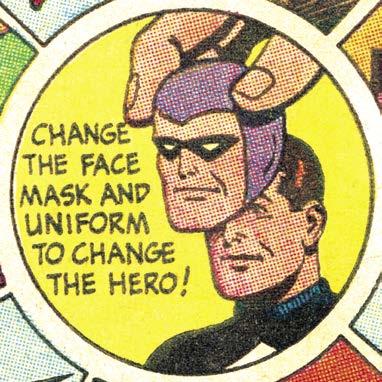
SO THERE WAS A CRAVING OUT THERE FOR A superhero action figure. (If I wanted one, a million more like me did too.) Imagine our collective joy when, in 1966, the Ideal Toy Company began running an advertisement for something called Captain Action, “the Amazing 9-in-1 Super Hero!”
The ad, which appeared in DC Comics publications, was drawn in the clean, solid comic book style of Kurt Schaffenberger, then DC’s preeminent Lois Lane artist. Even to we unsophisticated tykes, Schaffenberger’s style registered as familiar and authentically superhero-like. We knew this territory.
“Pose him in 1001 positions” proclaimed box type, which was no unique boast. (You already did that with Johnny West and G.I. Joe.) But another line clinched the deal: “Get official costumes to change Capt. Action into these super heroes!”
He could be Batman! Superman! Aquaman! The Phantom! Captain America! There were four more “superheroes,” but they weren’t actually super: Lone Ranger, Steve Canyon, Sgt. Fury and Flash Gordon. (This was our first exposure to “superhero adjacent” characters that were swept along with the Genuine Articles in those days by less-than-savvy manufacturers.)
Ideal’s Captain Action was a multi-publisher crossover the likes of which the world will never see again. Opposite: Dr. Evil attacks in Kurt Schaffenberger art.
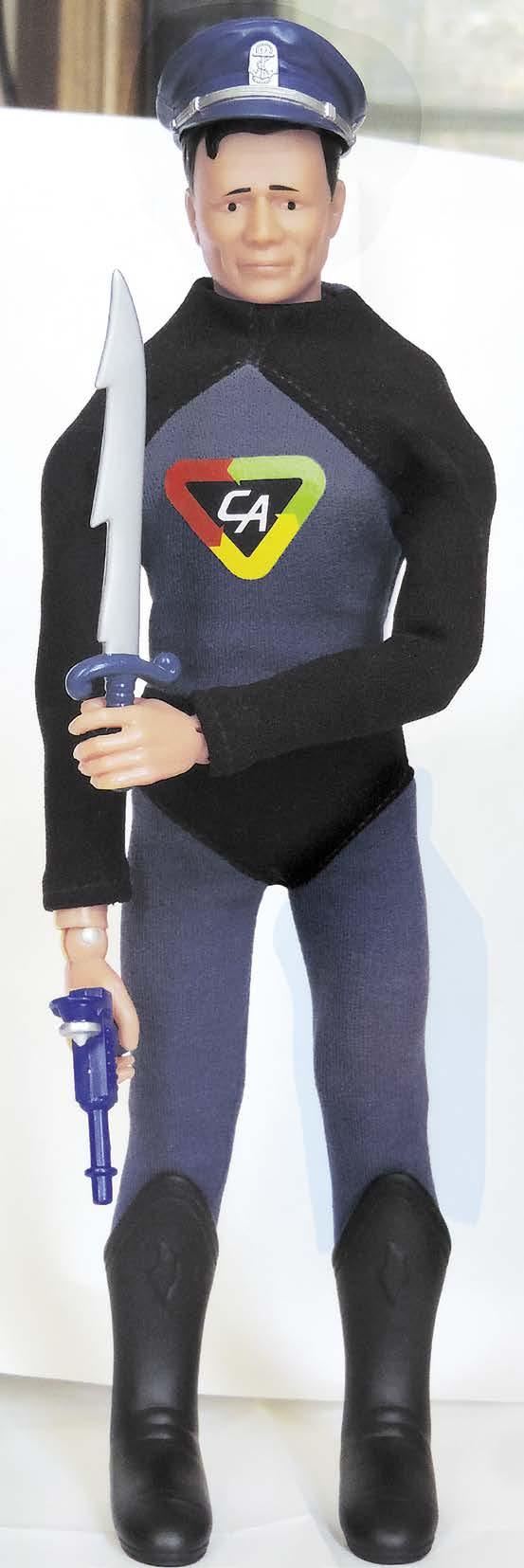
Captain Action Enterprises; characters © DC Comics Inc. except the Lone Ranger © Wrather Corp.; Steve Canyon © Field Enterprises Inc.; Flash Gordon and the Phantom © King Features Syndicate; Sgt. Fury and Captain America © Marvel Comics Inc.
©
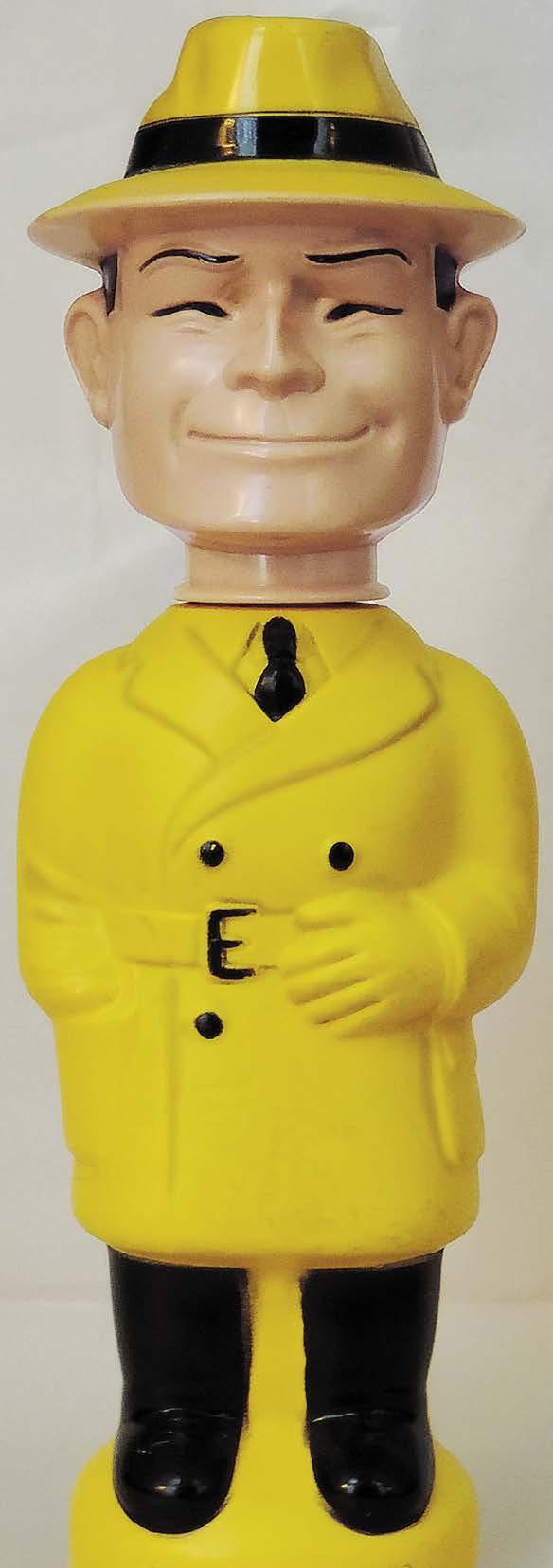


Masked on magazines
“I want to show you something wonderful,” said William Dozier to Adam West.
Dozier, the executive producer of “Batman,” then tossed onto his desk a brand-spankin’-new copy of Life magazine dated March 11, 1966. On the cover was a photo of West in his Batman getup, an expression of manic euphoria on his face, in mid-leap.
(All too well, West remembered posing for Life photographer Yale Joel. “For the photo shoot, I had to jump from the top of the Batcave Atomic Pile in full costume,” West wrote in “Back to the Batcave,” his 1994 memoir. “I ended up doing it 18 times, landing on a stack of mattresses 12 feet below. … During an early jump I twisted an ankle, and it was agony going back up over and over until the photographer got the shot he wanted.”)
“Nice,” said West to Dozier regarding the magazine, not to mention the publicity bonanza it would yield.
“Yes,” Dozier said, “but don’t get any big ideas. Remember, there have been 13 Tarzans.”
West got Dozier’s chilling message. The actor later wrote: “I never forgot what he said, because it reminded me that in Hollywood you can like someone, work closely with them, have fun with them, and go to their house for dinner, but that doesn’t make them your friend. If the ratings drop, if the ship starts to sink, it’s every Batman for himself.”
MAGAZINES WERE STILL A THING, still very much a major force, during the era of Batmania. It was a time when “mass media” could be boiled down to a handful of formats, chiefly broadcast (TV and radio), print (books, newspapers, magazines) and film.
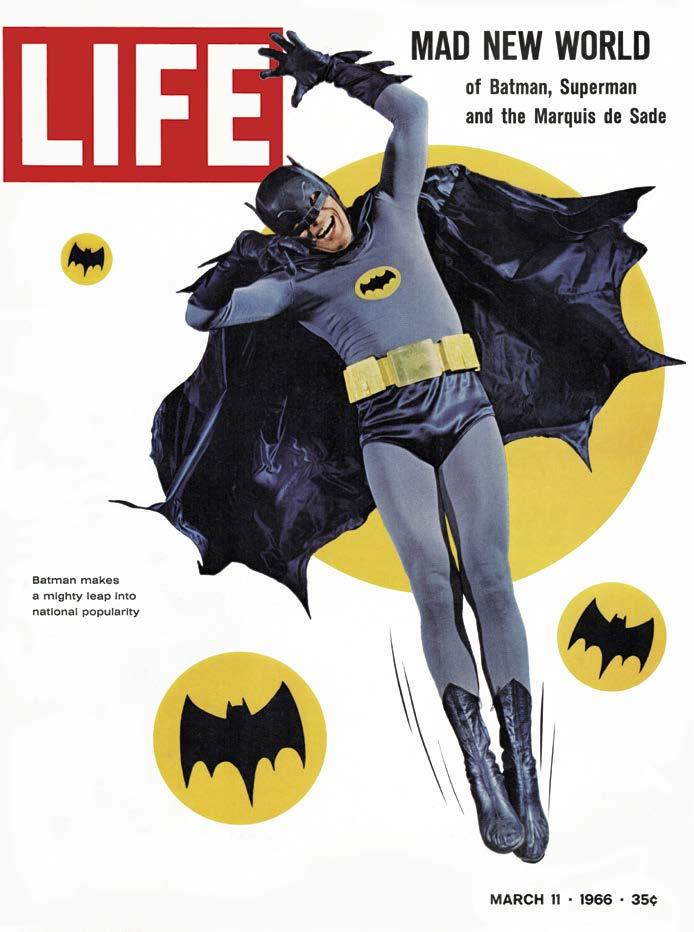
Adam West’s mighty leap for Life. Opposite: Roy Lichtenstein’s pop-art cover illustration for Newsweek. © Time Inc.; © Newsweek
In the case of Life, the runaway popularity of “Batman” which took the country by surprise was something the magazine could not ignore, however low-brow they perceived the TV show to be.
Life’s cover blurb, “MAD NEW WORLD of Batman, Superman and the Marquis de Sade,” suggested a larger trend, folding in stage productions under the umbrella of cultural “madness.”
From Tom Brideaux’s cover story (titled “The Whole Country Goes Super-mad”): “There’s no escape. It’s all over the place. Madness! Supermadness! The entertainment world offers it on all sides, and the public gobbles it up. Batman conquers TV.
Kids swing Batman capes in the backyard, and Bat products are everywhere. In the theater, craziness is the new craze. The whole country is going deliberately, and profitably, nuts.”
This shoe-horned hyperbole absolved Life of any accusation of using Batman to sell magazines. Or that seemed to be the hope.
Newsweek, too, sought to stay above the fray in its April 25, 1966 issue, with a Roy Lichtenstein cover of a big POP! and the blurb: “It’s what’s happening in art, fashion, entertainment, business” — again, playing the over-arching trend card. Lichenstein, who interpolated comic iconography in his art, was a shrewd choice.
PRINT MEDIA
123
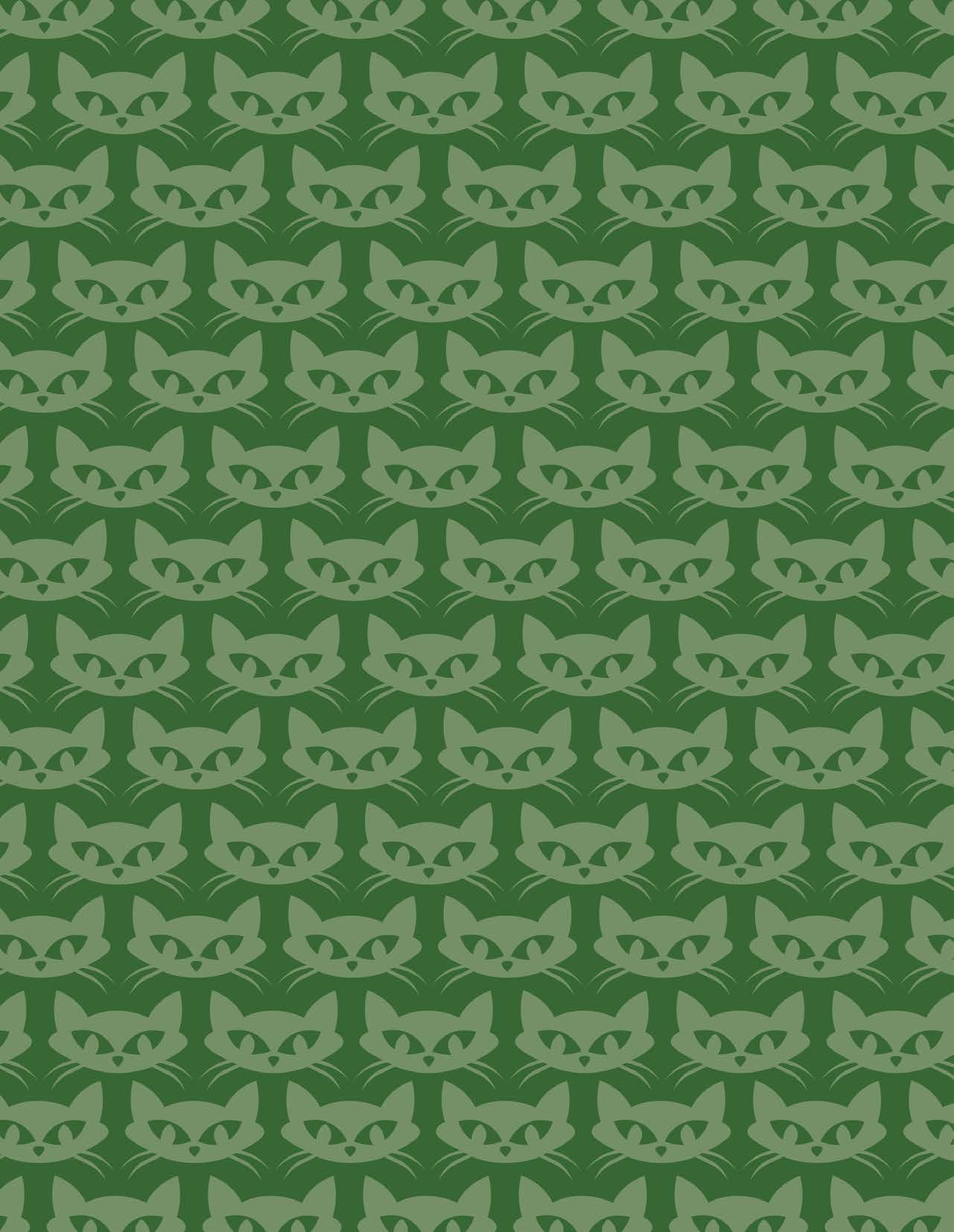
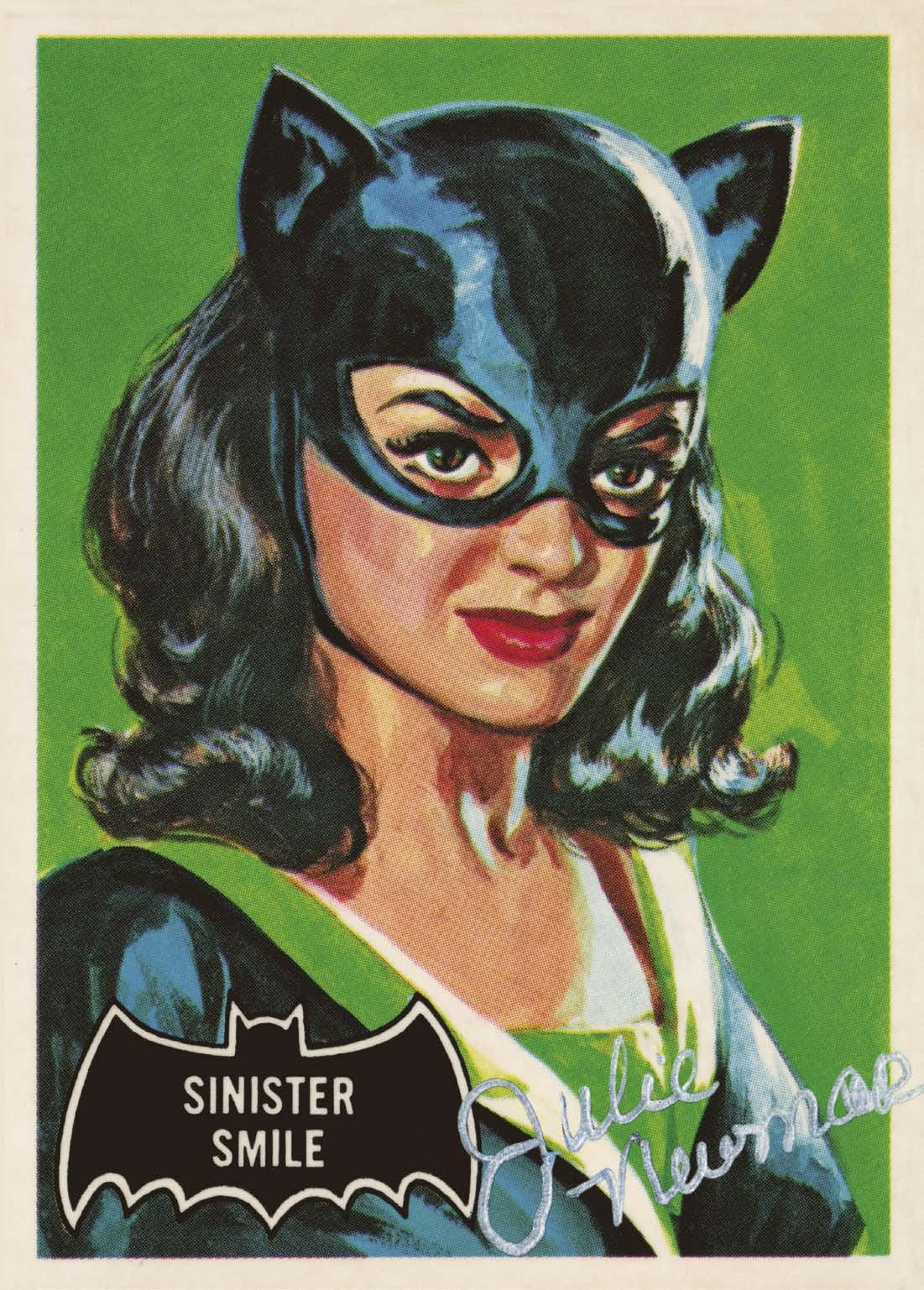
All this (& gum) for a nickel
BOLD. EXQUISITE. HYPNOTIC. And weird as hell.
The painted artwork of Topps’ first three Batman trading card series of 1966 remain some of the finest, and craziest, visual depictions of Batman and Robin in any medium — comics and film included.
The paintings were museum worthy, at least to us whelps who spent our hard-won nickels on them. They were markedly different from any other Batman-related media seen during this fast and furious era. On the TV show, Batman never pursued a crook atop the Statue of Liberty, nor hung from a giant clock. (Little did we know, these exciting scenes were throwbacks to the pulp fiction covers of the 1930s, ’40s and ’50s, painted by one of the medium’s masters. More on that later.)
We generally think of Topps as a trading card company, but actually, it began as a chewing gum company that used cards to help sell gum. Topps Chewing Gum, Inc., of Brooklyn was founded in 1938 and introduced Bazooka Bubble Gum in 1947. Though Topps is best known for its baseball cards, the company’s initial cards featured movie cowboy “Hopalong” Cassidy. Topps’ 1952 Mickey Mantle card once sold for $12.6 million (!). Topps got into painted artwork with trading card series on the Civil War, World War II, and its infamous sci-fi series “Mars Attacks.”
The “Batman” TV show triggered a tsunami of merchandising in 1966 — something that was anticipated by Len Brown, then an editor for Topps.
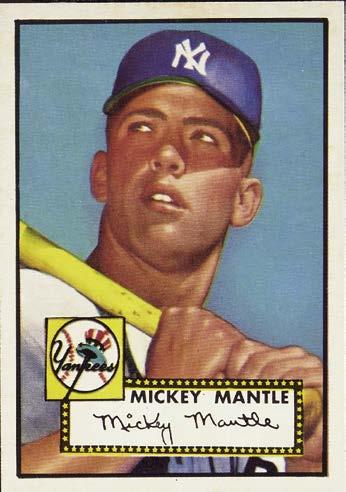
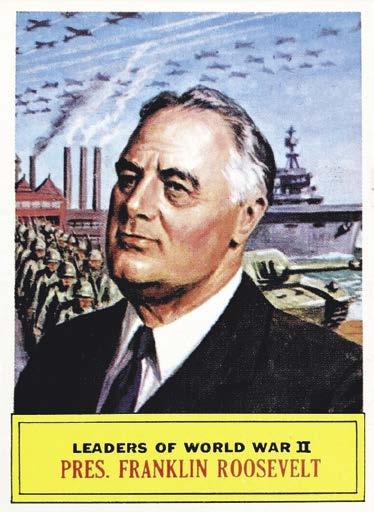
He told me in 1996: “Batman was another thing, like science fiction, that deeply influenced my life. I collected the comics when I was a little kid. My earliest memories of going to the movies were seeing these 1940s Batman black-and-white serials, where they’d show a chapter a week. My grandfather took me. In ’49, the second Batman serial was issued, so I went every Saturday. I was 6. I remember thinking they were great. I’ve seen them again since, and laugh at the campiness and how poorly done they were.
“So Batman was just a character that I loved. And now he was going to be on television. We heard about it the previous year.” Brown alerted his superiors at Topps about the upcoming show.
“I remember telling (Topps supervisor) Woody Gelman and the people who made these decisions: ‘As soon as Batman goes on TV, we’ve gotta get the rights to do it. Because this is going to be huge. Kids are going to see Batman for the first time in the flesh.’ Sure enough, the Adam West show debuted and it was an immediate hit.”
Topps figured that photos from the TV show would be used for the cards. Recalled Brown: “They (DC Comics) said, ‘No, there’s a problem. We don’t have the rights to the actors’ likenesses. Why don’t you just use artwork, like comics?’ It was licensed through DC Comics at the time.”
But Brown and his colleagues had a different idea. Previously, Topps enjoyed success with “Civil War News,” a trading card series about the Civil War dressed up with blood and guts. Chief among artists assigned to the series were Norman Saunders, whose dynamic painted covers adorned pulp fiction magazines beginning in the 1930s, and Bob Powell, a veteran comic book artist who served as a penciller.
“We got pushed into it, but I think we lucked out,” Brown said. “We really wanted pictures from the TV show because we felt that’s what the kids would want. So really, we were forced into doing the paintings.”
SURPRISINGLY, DC BALKED WHEN
they first saw the finished artwork.
“I remember going up there with the art after we had finished it, to get the approvals,” Brown said. “They hated it. They wanted it to look just like the comics. They wanted it to look like Bob Kane comic book art. That’s what they were licensing. They said, ‘What are you guys doing? You’re painting it? You’re trying to make it look like Adam West and Burt Ward?’ I guess, to a certain extent, you might say that. We didn’t make it look exactly like the actors, but we felt the cards should look like pulp covers — you know, the way paperback covers looked in those days.
“When I left DC, I was completely dejected. I couldn’t get approval. It took the president of Topps calling somebody high up in the DC chain for them to say, ‘OK, OK, go ahead and use it.’ ”
In the end, money talked; the Batman cards were a huge seller.
“Batman was, to the ’60s, like the Davy Crockett craze was to the ’50s,” Brown said. “Every kid was into Batman.”
The painted art was realistic, cinematic and, not for nuthin’, weird. The artists — whose numbers grew with the second and third series — seemed to pack an entire story into each 2.5"-by3.5" card. The fleet synopses forced the reader to fill in story details, a healthy exercise for growing brains.
131
Above: Topps’ 1952 Mickey Mantle card and FDR on Topps’ 1965 World War II set. Opposite: A 1966 Catwoman card autographed by Julie Newmar. Cards © Topps; Catwoman © DC Comics Inc.
Carmine Infantino
“I was a fan of the Batman as a kid,” said the artist who, as things turned out, rescued Batman from the editorial chopping block.
“I enjoyed seeing the character,” continued Carmine Infantino, an influential superhero artist who later became editorial director for DC Comics. “I was happy to get a shot at it. That was in 1964 I took it over, when it began to lose some popularity.”
Brooklyn native Infantino (1925-2013) was speaking of the time that Julius Schwartz — then the newly appointed editor of Batman comic books — engaged him to illustrate Batman stories after 25 years during which the character was controlled by its originator, Bob Kane, and Kane’s complement of “ghost artists.”
“That was a decision by Irwin Donenfeld, by the way, who was then the publisher,” Infantino told me in 1992. (The artist’s version of events differed somewhat from Schwartz’s account.)
“Apparently, the Batman was dying. They were getting sales like 18 percent, 17 percent. It was literally dying off. So he suggested to Julie — this is what I was told, now — that they should put me on Detective, and I should do all the covers on the Batman, and see if anything happens.
“And if nothing happened, they were going to unload the strip. Drop it altogether. That’s how bad it was. The first issue I did (Detective Comics #327) did well. And then the covers helped on the other Batman stuff.”
THE SO-CALLED ‘NEW LOOK’ WASN’T JUST ABOUT optics. The scripts evinced a shift in narrative tone toward something less fanciful, which jibed closer to Infantino’s visual style.
“At the moment, we were just going to do subtle changes,” the artist said. “We were feeling our way. The only thing they did want me to do was keep the character in my style. Because they thought that Kane had gotten too cartoony or something.”
As you might guess, Kane did not take the transition lightly.
“He was not happy,” Infantino admitted.
“You know, Kane was very upset. When the Batman was dying many years ago and they put me on the strip, he was quite upset about that. He said that my work stunk. He said that.
“But I can understand that, too. You know, he was being taken off the strip. It makes sense. That’s a normal reaction. There’s nothing detrimental about that.”
SIX YEARS AFTER THAT CONVERSATION, I AGAIN spoke with Infantino, this time on the occasion of Kane’s death. I asked the artist what Kane was like as a person (little realizing what a loaded question that was).
“He was quiet,” Infantino then said. “He had a big ego, I remember that. You know, really, he wasn’t very well liked, this guy. And he used guys all over the place to do the stuff (artwork) for him. I don’t think he drew the strip after 20 years. He had Sheldon Moldoff do it; nine different people did the thing for him. A lot of people had all kinds of animosity.”
There was no need to bring up the name of Bill Finger; Infantino did that for me.
“Bill Finger should get some credit here,” Infantino said.
“The truth is, he was promised all kinds of things by Bob’s father (engraver Herman Kahn). They never delivered.”
Perhaps Infantino thought better of his candor? Before ending the conversation, he lauded Kane for his tenacity.
“Kane had a right to have an ego about it,” Infantino said. “It was a wonderful strip, a lifetime thing. He had his name on it. That’s the key. The Batman was his thing. He created a whole world with that character. He created a character that is immortal.
“Myself and, I’m sure, everybody else I put on the strip — like Neal Adams and Irv Novick — we were very pleased to have worked on that character for all those years. Bob created something that will outlast generation after generation of youngsters. He created something that will be part of our society forever.”
 Artist Carmine Infantino in 2001.
Photo by Kathy Voglesong
Artist Carmine Infantino in 2001.
Photo by Kathy Voglesong
Joe Giella Comics’ undersung 1966 Batman artist
WHO IS MY FAVORITE 1966-ERA BATMAN ARTIST?
That’s an easy one. When I was 7, my crystal clear image of Batman is from the Detective Comics and Batman covers inked by Joe Giella. The art is solid and unambiguous and clean. It’s friendly but not necessarily “kid friendly.” To me, that is the 1966 Batman.
After studying different styles as an adult, I concluded: Whenever Giella is the inker, that’s how Batman looks. It’s a specific Batman that is taken for granted as “generic” because it’s so clean. I think of Giella as one of the great undersung Batman artists.
Apparently, I am not alone. As Giella (1928-2023) told me during a 1996 interview, “Everybody tells me that!”
The hitch: Giella wasn’t known as a penciller for DC Comics. He inked. But if you’re familiar with, say, Carmine Infantino’s pencilling style, and you observe how Giella inked it, you know that Giella frequently re-pencilled the Batman figures before inking. This was especially true on the covers. There’s no better example than the iconic cover of Detective Comics #354 (Aug.
“More Weisinger was the editor,” Giella recalled. “He was constantly telling me to keep it on the ‘camp’ look. I’d always envisioned the Batman as a serious character of the night. Very dramatic. But they wanted to get it to look and feel like the TV show. It’s a camp look, a ‘Joe Palooka’ look. I had difficulty working that way at first, but then I got used to it.”
On certain licensing jobs, Giella again ghosted for Kane.
“He would get involved in some projects, and invariably he’d call me,” Giella said. “Because he really didn’t do much drawing. So he had a lot of people working on the Batman. Quite a few artists worked on the Batman. But I did a few projects for him.”
Even a few off-the-radar projects. Said Giella: “Bob would go on TV on Saturday mornings, and he’d have a big pad on an easel, and he would proceed to sketch the characters. But, see, they were my drawings on the pad, done with a very light blue pencil.
“What happened was, I came up with slew of drawings for Bob and put them on the pad. Then he’d take the pad to the TV studio,

Joe Giella provided the iconic 1966-era Batman in comic books, licensing and syndicated comic strips.
Photo courtesy of Frank Giella
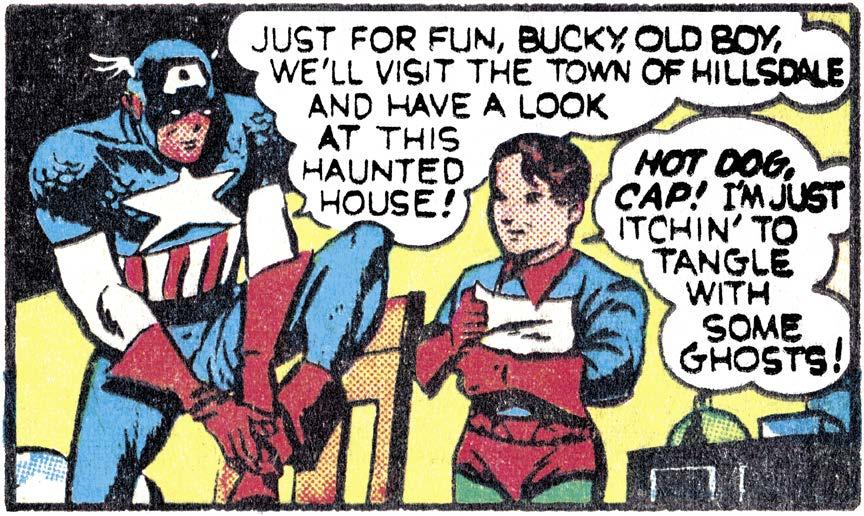

Marvel’s museum
“From yesteryear ... Marvel proudly presents six more timeless tales ... Still as fresh and exciting as the day they were first published!... More! More! More of the early fantasy thrillers ... Each tale complete and unabridged! Not one dazzling word or picture omitted!” Marvel’s Fantasy Masterpieces giants (1966-67) were like printed museums, wherein fans learned about the past lives of current (and forgotten) heroes. Reprinted stories included, from top, Cap and Bucky from Captain America #4 (1941); Sub-Mariner from Marvel Mystery #9 (1940); the Torch and Toro from The Human Torch #1 (1940); and the All Winners Squad (can you identify each character?) from All Winners #19 (1946).
© Marvel Comics Inc.
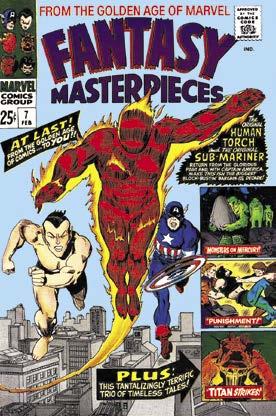

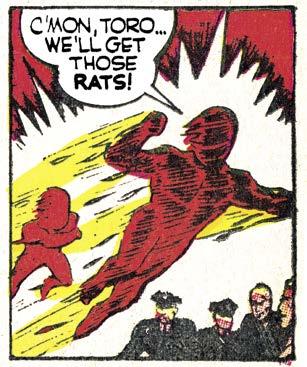
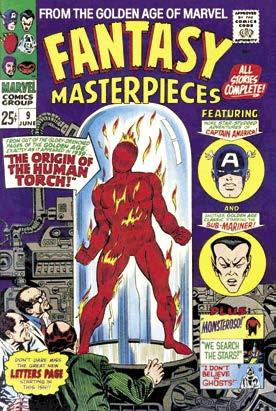

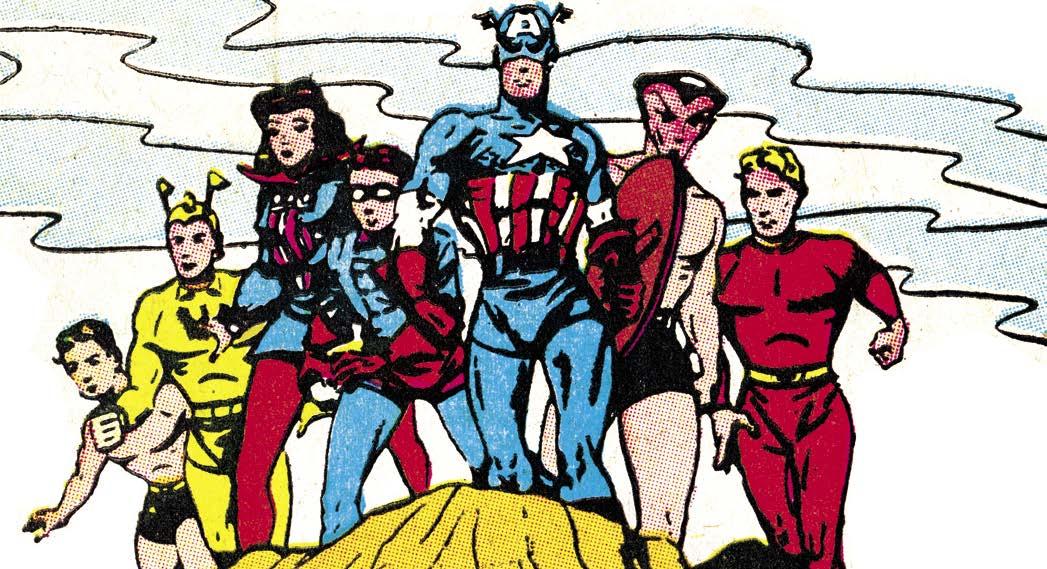
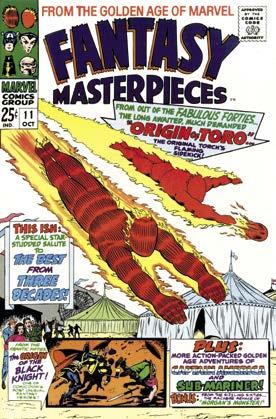
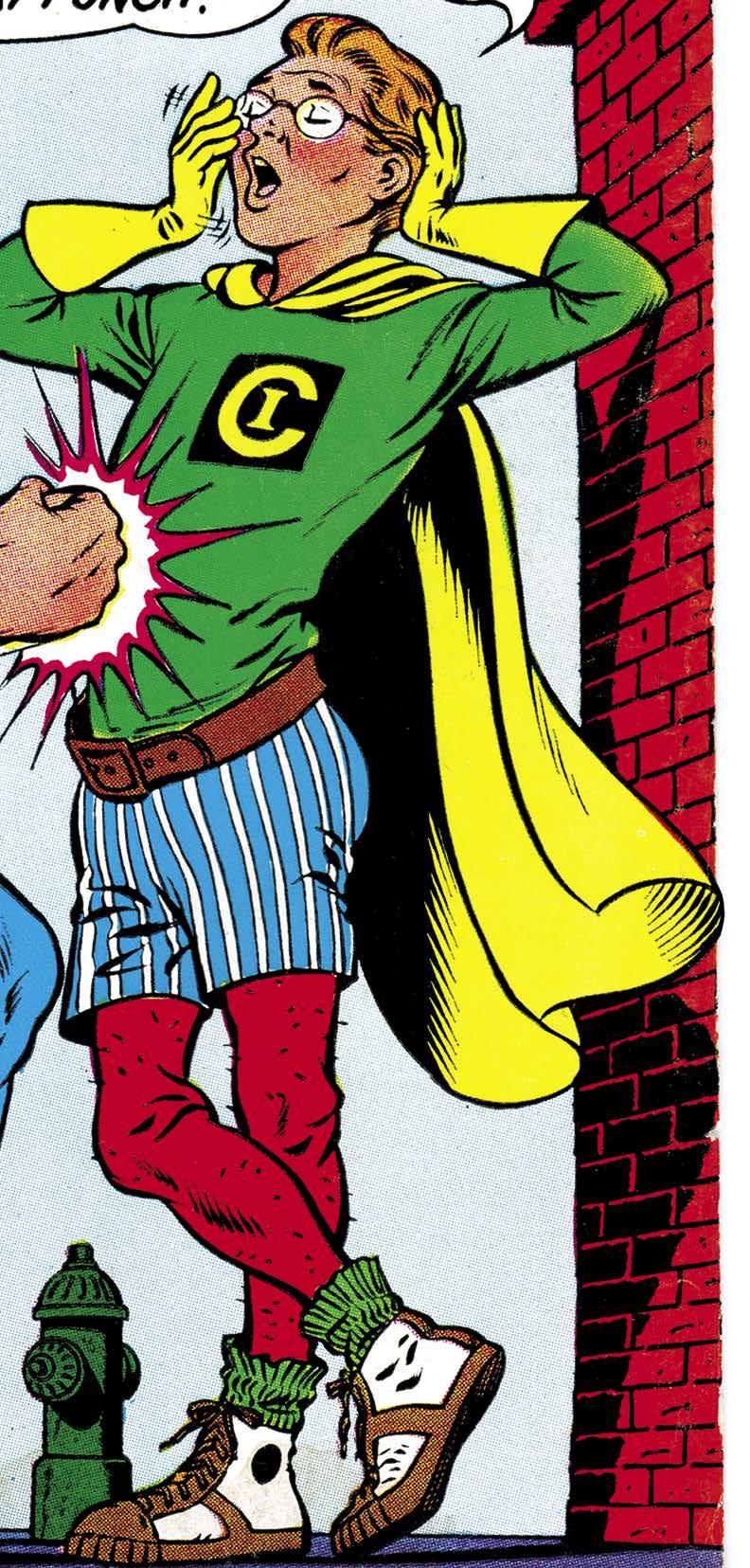
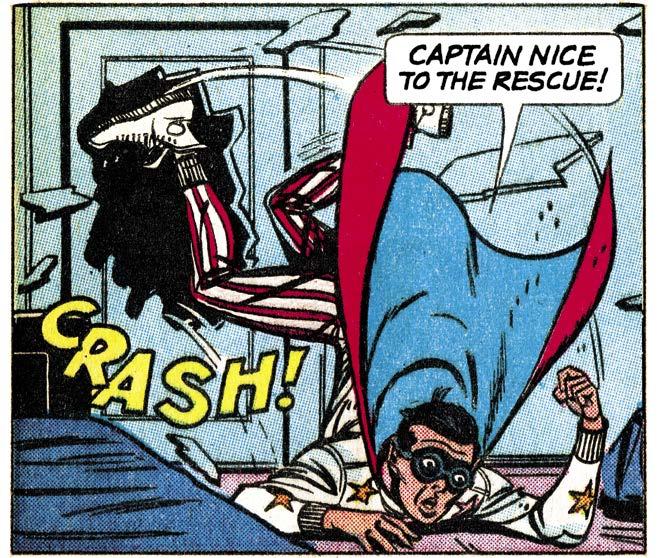
Funny’ TV heroes
IT’S A BIT CIRCLE-JERKY WHEN YOU ANALYZE it: A TV show about a silly original superhero parodies a TV show about an established comic book superhero, and then the parody show gets its own ... comic book? (Sounds like a conflict of interest.) In answer to ABC’s “Batman,” NBC aired the parody “Captain Nice,” which was adapted to comics by Dell. (Irony alert: The uncredited art is by Joe Certa, co-creator of DC’s Martian Manhunter.) DC returned the volley with Action #354 featuring “that puny powerhouse,” long-johns-clad Captain Invincible. From top left: Invincible yawns at Superman’s punch in Curt Swan art; Captain Nice crashes in his first (and only) edition; Dell’s adaptation of Hanna-Barbera’s cartoon super-beings Atom Ant and FluidMan (a friend of Aquaman?) of the Impossibles.

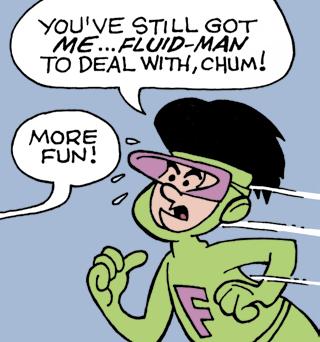
© NBC Television; © Dell Publishing; © DC Comics Inc.; © Hanna-Barbera Productions
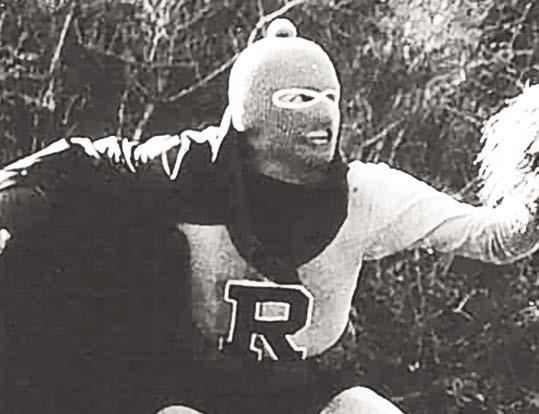

‘
Rat Pfink and Boo Boo’ (1966)
RAY DENNIS STECKLER IS WELL KNOWN TO shlock aficionados as the auteur behind “Wild Guitar,” “The Lemon Grove Kids Meet the Monsters” and “The Incredibly Strange Creatures Who Stopped Living and Became Mixed Zombies!!?” (Yes, that is its title and punctuation. The film was once featured on the 1960s TV docuseries “Hollywood and the Stars,” I’ll have you know.) Steckler makes Roger Corman look like Michael Curtiz, but you can’t hate his movies.
“Rat Pfink and Boo Boo” was Steckler’s no-budget attempt to cash in on Batmania. Rat Pfink wears a ski mask and gym sweats, Boo Boo wears a Mardis Gras hat with blinking lights. They tool around in a shiny cycle/ sidecar ensemble lent to the production by a trusting, well-off friend (I’m guessing).
Plot: Sadistic hoods are roughing up vulnerable young ladies. Outside the Capitol Records Tower in L.A. — a stolen shot, natch — we meet Lonnie Lord (Ron Haydock), a rock singer in an expired pompadour. The narrator tells us Lonnie has sold 10 million records. We’ll have to take his word for it. Lonnie rides on a merry-go-round with his gal Cee Bee (Carolyn Brandt), listening to his song titled “Running Wild” (I think). The hoods harass Cee Bee with obscene phone calls. The next song up is titled “You is a Rat Pfink” (I think), and has Lonnie cavorting with bikini-clad girls. After the hoods abduct Cee Bee, Lonnie and his slow-witted gardener (Titus Moede) suit up as Our Heroes.
“Rat Pfink and Boo Boo” is a jumble of nonsynch sound; more stolen exteriors; generic surf-rock; and a guy in a gorilla suit (good old Bob Burns, billed as “Kogar”). Funniest scene: Haydock and Moede, in costume, bluff their way into a real-life parade and wave to the crowd like they’re real-life celebrities. And folks in the crowd wave back!
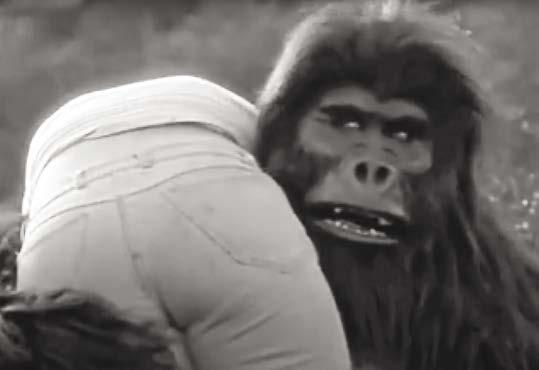

 Poster detail.
© Morgan Picture Corp.
From above: Haydock as Rat Pfink; Moede as Boo Boo; Kogar (Burns) totes Cee Bee (Brandt). © Morgan Picture Corp.
Poster detail.
© Morgan Picture Corp.
From above: Haydock as Rat Pfink; Moede as Boo Boo; Kogar (Burns) totes Cee Bee (Brandt). © Morgan Picture Corp.

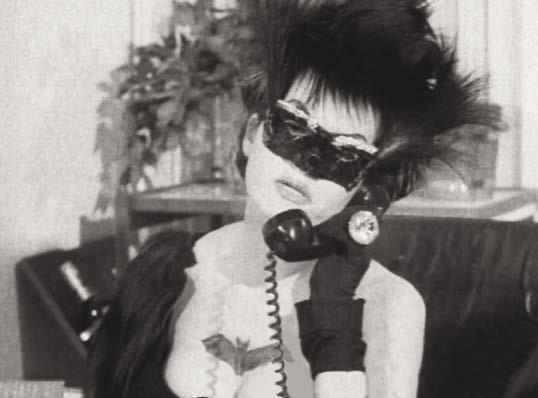
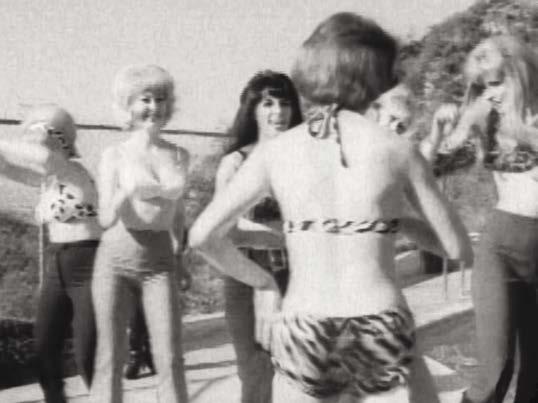

‘ The Wild World of Batwoman ’ (1966)
“NOT ASSOCIATED WITH NATIONAL PERIODICAL Publications, Inc.,” reads the disclaimer under the title in “The Wild World of Batwoman.” We’d already guessed that.
Perhaps writer-editor-director-producer Jerry Warren didn’t realize that DC Comics indeed had a character named Batwoman (though she had been put into mothballs earlier that decade).
Premise: In a precursor to “Charlie’s Angels,” Batwoman (Katherine Victor) runs a squad of “bat girls” who fight crime, but their true talents lie in dancing by the pool wearing bikinis.
Batwoman’s costume seems like it was assembled in 10 minutes after a sprint through Goodwill. Let’s see, there’s a black domino mask; what appear to be ostrich feathers dyed black and peeking out willy-nilly from black hairpieces; a plunging black bodice; black hot pants; sheer black stockings; and a bat tattoo stamped across her cleavage. In other words, Batwoman couldn’t look sleazier if she was plucked from a Whitesnake video.
And not for nuthin’, Victor was no spring chicken. She exudes all the charm of a tired madame on the verge of retirement.
During indoctrination, a bat girl must drink a “blood solution.”
It contains honey, mint, cherry and strawberry yogurt. As one bat girl explains, “Drinking the real stuff went out with Count Dracula!”
During poolside ceremonies, the bat girls chant: “We, the girls who are dedicated to Batwoman, take an oath with all sincerity ...” (It continues, but I’ll spare you the rest.)
There are three tiers of bad guys. The first are a pair of hoods (Mel Oshins and Steve Conte) who abduct a bat girl (Suzanne Lodge) after drugging her in a discotheque. Next is mad scientist Prof. Neuron (J.G. Mitchell) and his hunchbacked assistant (Lloyd Nelson) who are a bit too close for comfort by 1966 standards. Commanding them all is criminal boss Bat Fink (Richard Banks), who wears an outdated getup you might call a Standard Serial Villain costume — black fedora, black mask, black cloak — presumably rented (or creatively borrowed) from Western Costume.
Even Bruno VeSota, a plus-size Warren mainstay who can be counted on to enliven his films, is barely treading water here.
But Warren made money on “TWWOB.” After Batmania died down, the ever-enterprising shlockmeister re-released the film as “She Was a Hippy Vampire.” Caveat emptor, y’all!
168
Left: The June Taylor Dancers .. . not. Right: Mel Oshins and Suzanne Lodge brave wet, sandy shoes for art. © ADP Productions
Left: Poster art detail. Right: Katherine Victor as the Batwoman consolidates power. (Note cleavage tattoo.) © ADP Productions
‘Las mujer murcielago (1968)
A mad scientist is killing wrestlers to build a scaly, bug-eyed gill-man in his floating laboratory. Who ya gonna call? Las mujer murcielago, of course. (That’s Batwoman to we Yanks). Maura Monti stars as a famous luchadora enmasculado (lady masked wrestler) enlisted by the polic a straight ripoff of the one worn by Adam West, save for the periwinkle tights. (Besides the cape and cowl, Batwoman basically walks around town in a nicely filled bikini, hunting for clues and eluding bungling thugs.) She throws acid in the face of evil Dr. Williams, played by Roberto Cañedo in a virtual reprise of his role in “Doctor of Doom” (1963), which likewise mixed wrestling ladies and monsters. René Cardona, the director of both films, often employs an underwater camera in scenes of Batwoman deftly navigating jagged coral without damaging her precious bat-bikini.

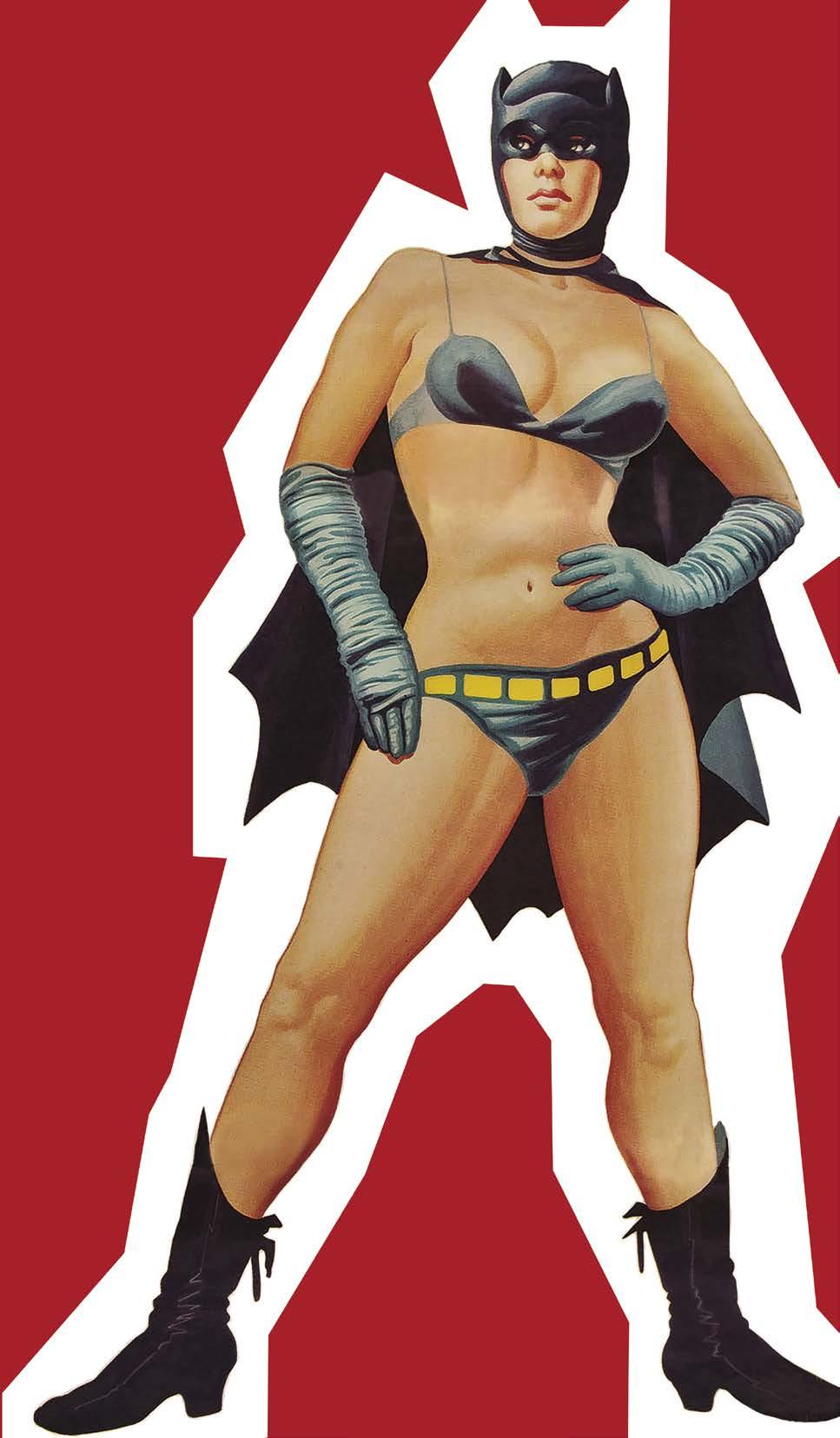 Maura Monti is the (unlicensed) Mexican “Batwoman.” © Cinematográfica Calderón
Maura Monti is the (unlicensed) Mexican “Batwoman.” © Cinematográfica Calderón
Superheroes Italian style
FROM THE COUNTRY
that brought us parmigiano reggiano and Gina Lollobrigita came superhero exports that also featured 007-style intrigue, sword-and-sandal, martial arts, sci-fi and, without fail, femme fatales.
“Ken Wood” (the U.S.-friendly name for Giancarlo Cianfriglia) wore the tights in Nick Nostro’s “Superargo vs. Diabolicus” (1966) and Paulo Bianchini’s “Superargo and the Faceless Giants” (1968).
Superargo is a professional wrestler who causes the death of a colleague during a match. Riddled with guilt (“I feel like a killer”), he retires from the ring. But the Secret Service has other plans for him.
In “Diabolicus,” the title tyrant (Gérard Tichy) can convert mercury into gold, and plans to flood the market to create economic chaos.
In “Faceless Giants,” Professor Wond (American leading man Guy Madison) commands an army of plodding zombies who wear man-thongs.
Both antagonists operate from sprawling Bond-villain-style compounds equipped with up-to-the-minute technology (closed-circuit TV, teletype machines, automatic doors).
Superargo has no powers, but “his metaphys ical equilibrium is so perfectly balanced, it gives him superhuman resistance.” He is trained by a turban-wearing mystic (Aldo Sambrell) to read minds and levitate.

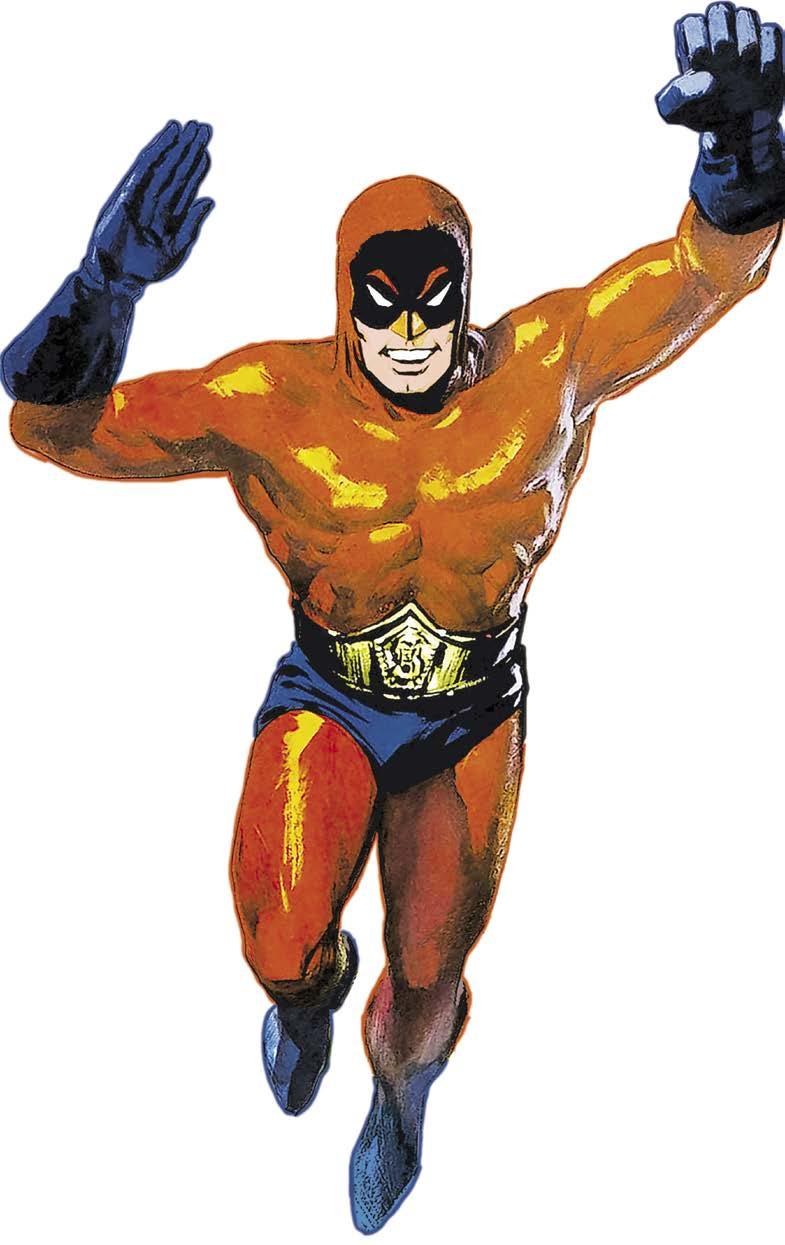
As with 007, Superargo employs hightech gadgets such as a martini olive, complete with toothpick, that is really a geiger counter. His fighting is a mix of disciplines: karate chops, wrestling moves (scissor legs, lift-and-toss), and John Wayne-style roundhouse punches. We never learn Superargo’s identity, nor do we see his face unmasked.
In “Goldface” (1967), the signature move of the title masked avenger (Espartaco Santoni) is to leap from high places. It’s his Goldface’s sidekick (Lotario) is always shirtless and always wears an animal-tooth necklace, not that he’s an African stereotype. The same year saw Sergio Grieco’s international romp “Argoman” starring Roger Browne. The liveliest of the bunch is Gianfranco Parolini’s “The Three Supermen” (1967), in which two heist specialists (Luciano Stella and Aldo Canti) team up with an FBI agent (Brad Harris) against evil Golem (Joch Brockmann), who can perfectly duplicate gold, diamonds, even people. Golem poses as a philanthropist, but plans to kill the children in his foundation (“They have seen too much”) once he’s duplicated them. Stuntmen for Stella and Canti bounce from unseen trampolines for spectacular Harris previously starred in “Goliath Against the Giants” (1961). There were five (!) sequels.

From top: Superargo, Argoman, Lotario, Goldface and the Three Supermen.
 © Liber Film; © Fida Cinematografica; © Cinematografica Associati; © Cinesecolo
© Liber Film; © Fida Cinematografica; © Cinematografica Associati; © Cinesecolo
Mexico’s masked avengers
DOES EL SANTO — THE MEXICAN WRESTLER, movie star and folk hero — qualify as a superhero?
Just consider the similarities between Batman and Santo. Both wear masks and capes. Both tool around in flashy cars. Both keep their true iden tities secret. Both star in comic books. Both are mere mortals trained in hand-to-hand combat and crime detection techniques.
But there’s one important difference between Batman and Santo. Batman is a fictional character. Santo was real.
Professional wrestler Rodolfo Guzmán Huerta (1917-1984) developed the persona in the 1940s, winning fame throughout Mexico as the #1 luchador enmascarado (masked wrestler). He made the transition to film in two 1958 movies shot in (barely) pre-Castro Cuba.
During the 1960s TV superhero craze, millions of Americans witnessed Santo’s exploits on television. But he wasn’t called Santo in the English dubs; we Yanks first knew him as “Samson.” This tweak came courtesy of pro ducer K. Gordon Murray, the man who introduced Santo, er, Samson to los Estados Unidos “Samson vs. the Vampire Women” (1962) and “Samson in the Wax Museum” (1963).
(Speaking of Mexican monster movies with luchadors enmascarado, the second film in Rafael Portillo’s Aztec Mummy trilogy, 1957’s “The Curse of the Aztec Mummy,” featured the extremely-Santo-like Angel.)
Huerta kept making movies into the ’80s, more than 50 in all. His wrestling colleague Wolf Ruvinskis played the shirtless (and sweaty) superhero Neutron in five Mexican films between 1960 and ’65, including “Neutron vs. the Death Robots.” The Blue Demon (Alejandro Muñoz Moreno) kicked off a film series in 1961, joining forces with Santo beginning in 1971.
For more than 40 years, El Santo wouldn’t reveal his identity on screen or off. That changed in 1984, when he unmasked during his final TV appearance, one week before his death at 66.
In “Samson in the Wax Museum,” one character calls El Santo “a strange man and a good one. There aren’t many others around anymore. He carries on a constant battle. He tries to help the law, fighting criminal elements and other enemies.”
Santo himself put it like this in “Samson vs. the Vampire Women”: “I have to go on, the way my ancestors did, to eliminate evil of all kinds.”

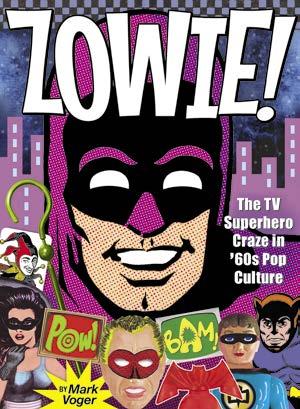
ZOWIE!

The TV Superhero Craze in ’60s Pop Culture by MARK VOGER

HOLY PHENOMENON! In the way-out year of 1966, the action comedy “Batman” starring ADAM WEST premiered and triggered a tsunami of super swag, including toys, games, Halloween costumes, puppets, action figures, and lunch boxes. Meanwhile, still more costumed avengers sprang forth on TV (“The Green Hornet,” “Ultraman”), in movies (“The Wild World of Batwoman,” “Rat Pfink and Boo Boo”), and in animation (“Space Ghost,” “The Marvel Super Heroes”). “Zowie!” traces the history of the superhero genre from early films, through the 1960s TV superhero craze, and its pop culture influence ever since. This 192-page hardcover, in pop art colors that conjure the period, spotlights the coolest collectibles and kookiest knockoffs every ’60s kid begged their parents for, and features interviews with the TV stars (WEST, BURT WARD, YVONNE CRAIG, FRANK GORSHIN, BURGESS MEREDITH, CESAR ROMERO, JULIE NEWMAR, VAN WILLIAMS), the artists behind the comics (JERRY ROBINSON, DICK SPRANG, CARMINE INFANTINO, JOE GIELLA), and others. Written and designed by MARK VOGER (“Monster Mash,” “Holly Jolly”), “Zowie!” is one super read!
(192-page FULL-COLOR HARDCOVER) $43.95 • (Digital Edition) $15.99 • ISBN: 978-1-60549-125-7
https://twomorrows.com/index.php?main_page=product_info&cPath=95_96&products_id=1803
Main image: El Santo! Insets: Neutron! And Blue Demon! © Filmadora Panamericana
IF YOU ENJOYED THIS PREVIEW, CLICK THE LINK BELOW TO ORDER THIS BOOK!
























 Bob Kane at the drawing board (1944). Below: Two inspirations were Leonardo da Vinci and the 1931 film “Dracula.”
© McClure Newspaper Syndicate; © Universal Pictures
Bob Kane at the drawing board (1944). Below: Two inspirations were Leonardo da Vinci and the 1931 film “Dracula.”
© McClure Newspaper Syndicate; © Universal Pictures


 Jerry Robinson in 2003.
Background: Joker influence Conrad Veidt. 2003 photo by Kathy Voglesong
Jerry Robinson in 2003.
Background: Joker influence Conrad Veidt. 2003 photo by Kathy Voglesong




















 Superman’s sci-fi roots were visualized in the animation medium. © Paramount Pictures; © Fleischer Studios; © DC Comics Inc.
Superman’s sci-fi roots were visualized in the animation medium. © Paramount Pictures; © Fleischer Studios; © DC Comics Inc.











 Photos by Kathy Voglesong; “Batman” © Warner Bros.; character © DC Comics Inc.
Photos by Kathy Voglesong; “Batman” © Warner Bros.; character © DC Comics Inc.



 Gorshin (shown in 2001) compared the Riddler to Shakespeare.
Photo by Kathy Voglesong
Gorshin (shown in 2001) compared the Riddler to Shakespeare.
Photo by Kathy Voglesong

 Photo by Kathy Voglesong
Photo by Kathy Voglesong





















































 Underdog © Total Television; Super Chicken © Jay Ward Prod.; Courageous Cat and Minute Mouse © Trans-Artists Productions; Batfink and Fearless Fly © Hal Seeger Productions
Underdog © Total Television; Super Chicken © Jay Ward Prod.; Courageous Cat and Minute Mouse © Trans-Artists Productions; Batfink and Fearless Fly © Hal Seeger Productions






































 guy in red leotards with oven
guy in red leotards with oven





 Astro Boy stuff was adorable! But most of it never made it to the States. From top left: “Flapping Door Action” toy; pinball game; telephone; car box art; toy box art; gun. Astro Boy © Fuji TV; toy © Billiken; otherwise © respective copyright holders
Astro Boy stuff was adorable! But most of it never made it to the States. From top left: “Flapping Door Action” toy; pinball game; telephone; car box art; toy box art; gun. Astro Boy © Fuji TV; toy © Billiken; otherwise © respective copyright holders
































 Artist Carmine Infantino in 2001.
Photo by Kathy Voglesong
Artist Carmine Infantino in 2001.
Photo by Kathy Voglesong


















 Poster detail.
© Morgan Picture Corp.
From above: Haydock as Rat Pfink; Moede as Boo Boo; Kogar (Burns) totes Cee Bee (Brandt). © Morgan Picture Corp.
Poster detail.
© Morgan Picture Corp.
From above: Haydock as Rat Pfink; Moede as Boo Boo; Kogar (Burns) totes Cee Bee (Brandt). © Morgan Picture Corp.





 Maura Monti is the (unlicensed) Mexican “Batwoman.” © Cinematográfica Calderón
Maura Monti is the (unlicensed) Mexican “Batwoman.” © Cinematográfica Calderón



 © Liber Film; © Fida Cinematografica; © Cinematografica Associati; © Cinesecolo
© Liber Film; © Fida Cinematografica; © Cinematografica Associati; © Cinesecolo



